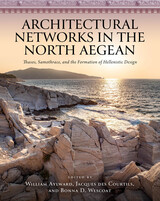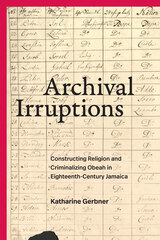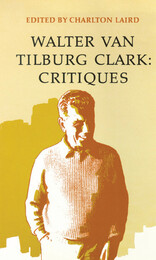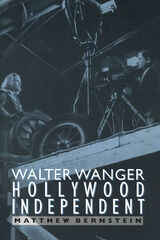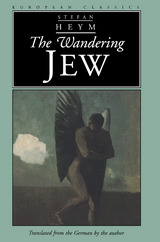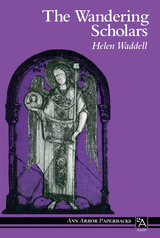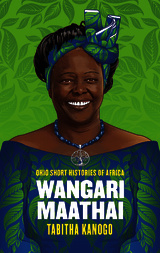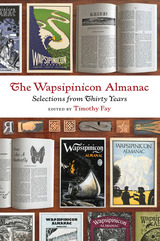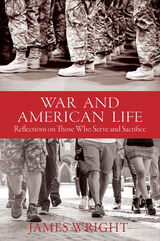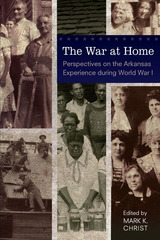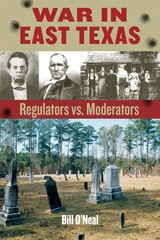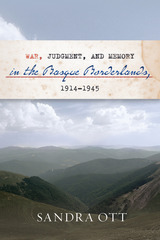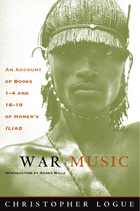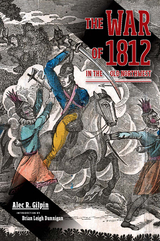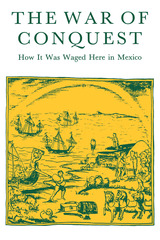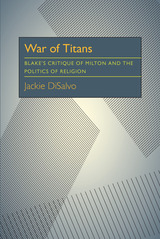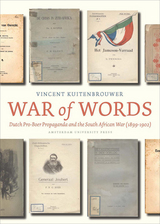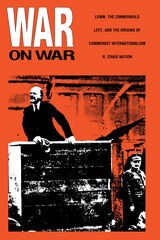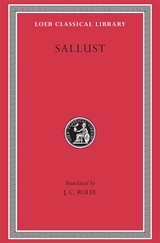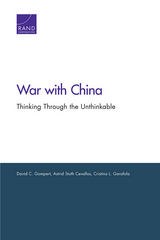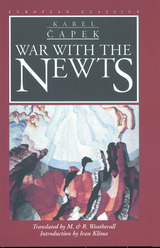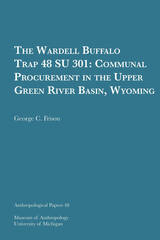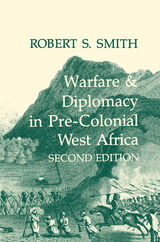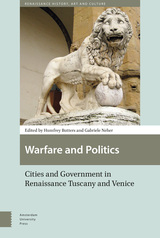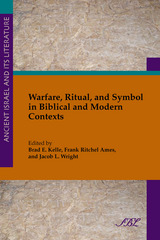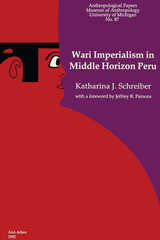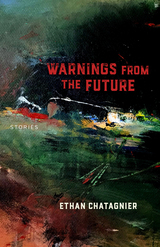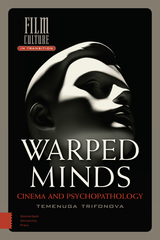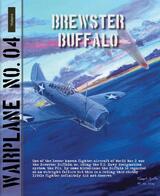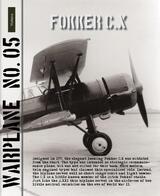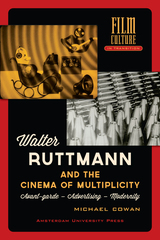 Walter Ruttmann and the Cinema of Multiplicity: Avant-Garde Film - Advertising - Modernity
Michael Cowan
Amsterdam University Press, 2014 A key figure in early avant-garde cinema, Walter Ruttmann was a pioneer of experimental animation and the creative force behind one of the silent era's most celebrated montage films, Berlin: Symphony of a Great City. Yet even as he was making experimental films, Ruttmann had a day job. He worked regularly in advertising -and he would go on to make industrial films, medical films, and even Nazi propaganda films.
Michael Cowan offers here the first study of Ruttmann in English, not only shedding light on his commercial, industrial, and propaganda work, but also rethinking his significance in light of recent transformations in film studies. Cowan brilliantly teases out the linkages between the avant-garde and industrial society in the early twentieth century, showing how Ruttmann's films incorporated and enacted strategies for managing the multiplicities of mass society.
This book has won the Willy Haas Award 2014 for its outstanding contribution to the study of German cinema.
Walter Van Tilberg Clark: Critiques
Charlton Laird
University of Nevada Press, 1983 Beginning in 1849, Alfred Doten recorded his life in minute detail for more than 54 years. His revealing daily accounts of the West's lusty mining frontier included tales of lynching, vigilante justice, shootings in the street, grand opera and theatre, stock manipulations, seances, musical soirees, and general "jollifications." Clark selected and edited the most valuable portions of Doten's massive diaries. He said he knew of no other account, fact or fiction, that so graphically presented the tragic course of a single representative life through the violent transformations brought about by the California Gold Rush and the Nevada Silver Boom.
Walter Wanger, Hollywood Independent
Matthew Bernstein
University of Minnesota Press, 2000 A portrait of the trailblazing film producer whose career spanned five decades. The long, colorful career of Walter Wanger (1894-1968) is one of Hollywood’s greatest untold stories. An intellectual and a socially conscious movie executive who produced provocative message movies and glittering romantic melodramas, Wanger’s career started at Paramount studios in the 1920s and led him to work at virtually every major studio as either a contract producer or an independent. He produced a series of American film classics, including Queen Christina, Stagecoach, Foreign Correspondent, and Invasion of the Body Snatchers, as well as a few notable flops, such as Cleopatra. This comprehensive biography brings to life a distinctive film personality and offers a new appreciation of the role of the producer in the history of American cinema.
 Walter's Perspective: A Memoir of Fifty Years in Chicago TV News
Walter Jacobson, Foreword by Bill Kurtis
Southern Illinois University Press, 2012 This highly readable book provides a unique glimpse into the rough-and-tumble Chicago news business as seen through the eyes of one of its legendary players. From his first news job working as a legman for Daily News columnist Jack Mabley in the 1950s to his later role as a news anchor and political commentator at CBS-owned WBBM, Walter Jacobson battled along the front lines of an industry undergoing dramatic changes. While it is ultimately Jacobson’s story, a memoir of a long and distinguished (and sometimes highly controversial) career, it is also an insider’s account of the inner workings of Chicago television news, including the ratings games, the process of defining news and choosing stories, the media’s power and its failures, and the meddling by corporate and network executives. As a reporter, Jacobson was regularly contentious and confrontational. He was fired on a number of occasions and was convicted of libeling tobacco company Brown and Williamson, resulting in a multimillion-dollar federal court judgment against him and CBS. Yet it was this gutsy attitude that put him at the top of the news game. With an engaging writing style, Jacobson recollects his interactions with Chicago mayors Richard J. and Richard M. Daley, Jane Byrne, Harold Washington, and Rahm Emanuel; recounts his coverage of such fascinating news stories as the violent 1968 Democratic National Convention and the execution of convicted mass murderer John Wayne Gacy; and recalls his reporting on and interviews with Louis Farrakhan, governors George Ryan and Rod Blagojevich, and Barack Obama. More than a memoir, Walter’s Perspective is the extraordinary journey of one reporter whose distinctive career followed the changing face of Chicago’s local news.
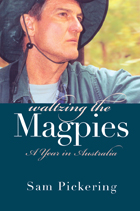 Waltzing the Magpies: A Year in Australia
Sam Pickering
University of Michigan Press, 2004 Praise for Sam Pickering:
"The art of the essay as delivered by Mr. Pickering is the art of the front porch ramble."
---The New York Times Book Review
"Reading Pickering . . . is like taking a walk with your oldest, wittiest friend."
---Smithsonian
"What a joy it is to 'mess around' with Professor Sam Pickering!"
---The Chattanooga Times
"Pickering is a barefoot observer of the quotidian who revels in the spectacle and its gift for surprise, prefers the rumpled to the starched, has raised puttering and messing about to an art form, and wrings from it more than a pennyworth of happiness and a life well lived."
---Kirkus Reviews
The movie Dead Poets Society is where most Americans first met Sam Pickering, the University of Connecticut English professor. Robin Williams plays the lead character (loosely based on Pickering), an idiosyncratic instructor who employs some over-the-top teaching methods to keep his subjects fresh and his students learning.
Fewer know that Pickering is the author of more than 16 books and nearly 200 articles, or that he's inspired thousands of university students to think in new ways. And, while Williams may have captured Pickering's madcap classroom antics, he didn't uncover the other side of the author-Sam Pickering as one of our great American men of letters. Like the music of Mozart, the painting of Picasso, or the poetry of Emily Dickinson, you can spot Pickering's writing a mile away; there's no mistaking the Pickering pen. As an ample demonstration of the author's literary gifts, Waltzing the Magpies is his unabashedly lush and Technicolor travelogue from Down Under.
On the face of it, Waltzing is the chronicle of a sabbatical year spent with family in Australia. Yet beneath the surface Pickering's big themes-family, nature, seizing the moment-move in a powerful current that frequently bursts out in moments of ecstatic revelation and intense sensual flourish. Through it all Pickering weaves stories from his fictional Southern town of Carthage, Tennessee, especially when the goings of the outside world get rough.
Waltzing the Magpies is classic Pickering at the height of his literary powers, and places him in the company of such great American essayists as E. B. White and James Thurber, but with an irony and observational prowess that is pure Pickering.
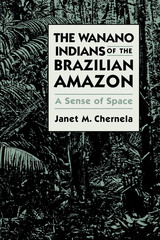 The Wanano Indians of the Brazilian Amazon: A Sense of Space
By Janet M. Chernela
University of Texas Press, 1996 The Wanano Indians of the northwest Amazon have a social system that differs from those of most tropical forest tribes. Neither stratified by wealth nor strictly egalitarian, Wanano society is "ranked" according to rigidly bound descent groups. In this pioneering ethnographic study, Janet M. Chernela decodes the structure of Wanano society. In Wanano culture, children can be "grandparents," while elders can be "grandchildren." This apparent contradiction springs from the fact that descent from ranked ancestors, rather than age or accumulated wealth, determines one's standing in Wanano society. But ranking's impulse is muted as senior clans, considered to be succulent (referring to both seniority and resource abundance), must be generous gift-givers. In this way, resources are distributed throughout the society. In two poignant chapters aptly entitled "Ordinary Dramas," Chernela shows that rank is a site of contest, resulting in exile, feuding, personal shame, and even death. Thus, Chernela's account is dynamic, placing rank in historic as well as personal context. As the deforestation of the Amazon continues, the Wanano and other indigenous peoples face growing threats of habitat destruction and eventual extinction. If these peoples are to be saved, they must first be known and valued. The Wanano Indians of the Brazilian Amazon is an important step in that direction.
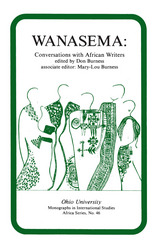 Wanasema: Conversations with African Writers
Don Burness
Ohio University Press, 1985 There is a tendency to regard African literature as a homogenous product. Certainly it is true that African writers have created a vibrant, modern literature. Nevertheless, they come from specific societies and reflect vastly differing worlds. Wanasema attempts to show some of the many faces of African literature. Dramatists, poets and novelists speak in these pages. They write in French, English, Portuguese, Arabic and indigenous languages. Some are Christian; others are Muslim. A variety of subjects are discussed, including the status of women, history, religion, politics, dress and education. Taken together, the interviews in Wanasema suggest that Western students of Africa would do well to learn the languages of Africa. They suggest, too, taht there is a need to investigate further the relationship between Islamic North Africa and Sub-Saharan Africa, and finally, that oral literature continues to be a vast marketplace for scholars. This book should interest African Studies specialists, of course, but also those whose concerns include literature, history and contemporary events in the non-Western world generally.
Wanda Gág: A Life of Art and Stories
Karen Nelson Hoyle
University of Minnesota Press, 2009 Now in paper. At the young age of just 15, Wanda Gág received her dying father's last wish that she take up his dream of becoming a successful artist: "What papa couldn't do, Wanda would have to finish." Wanda assumed the role of head of the household and became the sole means of support for her sick mother and six siblings. Although times were tough, Wanda persevered and eventually became a celebrated artist and author living in New York City. Karen Nelson Hoyle tells the story of Wanda Gág's eccentric life as a children's book author and traces the significant contributions she made to the genre. Drawn from extensive research of the artist's personal and professional papers and correspondence with friends and contemporaries, Hoyle presents a rich portrait of a gifted artist.
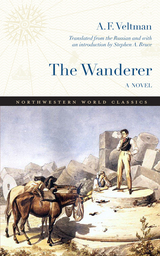 The Wanderer: A Novel
Alexander Veltman, Stephen A. Bruce
Northwestern University Press, 2026 The first English-language translation of an eccentric, unclassifiable classic
An unnamed narrator embarks on a rambling journey across the diverse borderlands of the Russian and Ottoman Empires—all without leaving his divan. Drawing on his own experiences in Bessarabia during the Russo-Turkish War of 1828–29, A. F. Veltman describes our Romantic narrator poring over a map and traversing distant, contested regions—at once imperial backwaters and cosmopolitan crossroads—where Romanians, Ruthenians, Jews, Bulgarians, Germans, and Turks comingle.
Meandering and motley in form and language, this lost classic of the early nineteenth century deploys metafictional innovations that anticipate postmodernist literature. The novel is speckled with dictionary entries, multiplication tables, philosophical digressions, and love poetry as Veltman swings from Gothic horror to antiquarian commentary to burlesque comedy. Past, present, and fantasy blend together, as Alexander the Great, Ovid, and Augustus join the narrator on his daydreamed journey of self-discovery.
Hugely popular in its day, The Wanderer is a remarkable tale that depicts the extraordinary places and peoples that met along the fault lines of once-great empires.
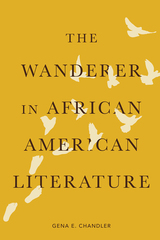 The Wanderer in African American Literature
Gena E. Chandler-Smith
University of Tennessee Press, 2020 The Wanderer in African American Literature highlights an enduring feature of African American letters: “From the slave narrative to Afrofuturism, the literature is populated, driven, and emboldened by wanderers who know no bounds.” Gena E. Chandler argues that wanderers and the theme of wandering push the limits of narrative forms and challenge assumptions about the African American experience. The slave narratives of Olaudah Equiano and Harriet Jacobs echo eighteenth-and nineteenth-century literary traditions and chronicle journeys toward freedom and faith. Equiano traces his changing identity, integrating his native African culture with his adopted European one. Jacobs addresses the gender restrictions she faces as a slave and then a free woman whose progress in life remains uncertain and ongoing.La ngston Hughes and Nella Larsen chronicle real and imagined journeys during the Harlem Renaissance and the Great Migration. Hughes’s autobiography I Wonder as I Wander (1956) traces his global travels in the 1930s, highlighting his unique identity as a black American. Larsen’s novel Quicksand (1928) follows its biracial heroine as she travels throughout the United States and to Denmark while navigating matters of race and gender. The protagonist of Richard Wright’s The Outsider (1953) seeks individual freedom and a new identity but is “constrained within the boundaries of an American nation and a Western ideal that continuously views the black subject as outside and distinct from the modern project of advancement and freedom.” In James Baldwin’s Giovanni’s Room (1956), the white protagonist flees America for France yet cannot escape difficult questions about sexuality and race. Finally, John Edgar Wideman’s The Cattle Killing (1996) tells the story of two wanderers—an itinerant preacher spreading God’s word during the Great Awakening and a twentieth-century writer on a journey of self-discovery about his identity and vocation. The former experiences a crisis of his Christian faith, and the latter endures a crisis of faith in his literary abilities. Tying these diverse threads together, Chandler demonstrates the power of the black narrative to assimilate and redeploy the literary trope of wanderlust, exchanging its premise of rootless drifting for something altogether more mobilizing.
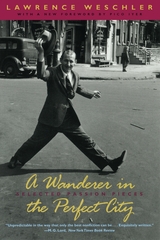 A Wanderer in the Perfect City: Selected Passion Pieces
Lawrence Weschler
University of Chicago Press, 2006 “There is something both marvelous and hilarious,” writes Lawrence Weschler, “in watching the humdrum suddenly take flight. This is, in part, a collection of such launchings.” Indeed, the eight essays collected in A Wanderer in the Perfect City do soar into the realm of passion as Weschler profiles people who “were just moseying down the street one day, minding their own business, when suddenly and almost spontaneously, they caught fire, they became obsessed, they became intensely focused and intensely alive.” With keen observations and graceful prose, Weschler carries us along as a teacher of rudimentary English from India decides that his destiny is to promote the paintings of an obscure American abstract expressionist; a gifted poker player invents a more exciting version of chess; an avant-garde Russian émigré conductor speaks Latin, exclusively, to his infant daughter; and Art Spiegelman composes Maus. But simple summaries can’t do these stories justice: like music, they derive their character from digressions and details, cadence and tone. And like the upwelling of passion Weschler’s characters feel, they are better experienced than explained. “Weschler seems so hungry for life that the rest of us become hungry for him . . . a magician, a performer, and a scholar. All in one.”—from the Foreword by Pico Iyer “Weschler’s essays are exquisitely written—so perfectly and unobtrusively organized that one can’t imagine telling them a better way.” —New York Times Book Review “Weschler is the owner of a large dose of novelistic vision, and a particularly poetic set of ears, but . . . as important an endowment as a novelist’s eye or a poet’s ear is still the journalistic nose which led him down the proverbial alley.”— National Post (Canada) “Weschler is a thoughtful observer and a superb storyteller.”— Minneapolis Star Tribune
 THE WANDERERS
NAOMI GLADISH SMITH
Swedenborg Foundation Publishers, 2007
What might a spirit feel on first awakening in the afterlife? Fear, confusion, denial?
When Maggie Stevens, a former world-class gymnast, first awakens in a hospital bed, she is amazed that her body is pain-free. After all, she fell off a balance beam during a competition and crashed head-first onto the auditorium floor. What Maggie doesn't at first realize is that the hospital is like no place on earth. She meets other newly arrived "patients": Kate Douglas, a no-nonsense academic who suffered a heart attack; Ryan James, a handsome musician, who is recovering from a motorcycle crash; Frank Chambers, an ex-cop from Chicago, and Patrick Riley, a church organist, both of whom arrived from a Swiss cancer clinic; and Claire and Swen, a young couple running away from the army. When they all learn that they didn't recover from their illnesses and injuries, they go on an adventure to discover the nature of their new reality. Each must discover that their earthly choices and intentions paved the way for their final destination.
 Wandering Dixie: Dispatches from the Lost Jewish South
Sue Eisenfeld
Ohio State University Press, 2020 Sue Eisenfeld is a Yankee by birth, a Virginian by choice, an urbanite who came to love the rural South, a Civil War buff, and a nonobservant Jewish woman. In Wandering Dixie, she travels to nine states, uncovering how the history of Jewish southerners converges with her personal story and the region’s complex, conflicted present. In the process, she discovers the unexpected ways that race, religion, and hidden histories intertwine. From South Carolina to Arkansas, she explores the small towns where Jewish people once lived and thrived. She visits the site of her distant cousin and civil rights activist Andrew Goodman’s murder during 1964’s Freedom Summer. She also talks with the only Jews remaining in some of the “lost” places, from Selma to the Mississippi Delta to Natchitoches, and visits areas with no Jewish community left—except for an old temple or overgrown cemetery. Eisenfeld follows he r curiosity about Jewish Confederates and casts an unflinching eye on early southern Jews’ participation in slavery. Her travels become a journey of revelation about our nation’s fraught history and a personal reckoning with the true nature of America.
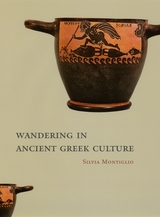 Wandering in Ancient Greek Culture
Silvia Montiglio
University of Chicago Press, 2005 From the Archaic period to the Greco-Roman age, the figure of the wanderer held great significance in ancient Greece. In the first comprehensive study devoted to this theme, Wandering in Ancient Greek Culture unearths the many meanings attached to this practice over the centuries. Employing a broad range of literary and philosophical texts, Silvia Montiglio demonstrates how wandering has been conceptualized from Homer's Odysseus—the hero "who wandered much"—in the eighth century BCE to pagan sages of the early Roman Empire such as Saint John the Baptist in the first century AD.
Attitudes toward wandering have evolved in accordance with cultural perspectives, causing some characterizations to persist while others have faded. For instance, the status of wanderers in Greek societies varied from outcasts and madmen to sages, who were recognized as mystical, even divine. Examining the act of wandering through many lenses, Wandering in Ancient Greek Culture shows how the transformation of the wanderer coincided with new perceptions of the world and of travel and invites us to consider its definition and import today.
The Wandering Jew
Stefan Heym
Northwestern University Press, 1999 According to the myth of the Wandering Jew, Ahasverus denied Christ a resting place while Christ was traveling to Golgotha. In turn, Ahasverus was cursed to roam the earth until the Second Coming. Stefan Heym's novel re-creates and expands this myth to propose that the right synthesis of love and rebellion can bring humankind to the Kingdom of Heaven.
Heym introduces both Ahasverus and Lucifer as angels cast out of heaven for their opinions on God's order. Their respective oppositions continue throughout the rest of time: Ahasverus remains defiant through protest rooted in love and a faith in progress, while Lucifer is rebellious by means of his old, familiar methods. In a funny eternity of run-ins, debates, and meddling with characters such as Christ, a disciple of Luther, and a Marxist professor in East Germany, Ahasverus and Lucifer struggle on, awaiting the Second Coming.
The Wandering Life: Followed by "Another Era of Writing"
Yves Bonnefoy
Seagull Books, 2023 The first English translation of Yves Bonnefoy’s account of his life as a traveler.
The Wandering Life is a poetic culmination of Yves Bonnefoy’s wanderings and characterizes the final twenty-five years of his work. Bonnefoy was an ardent traveler throughout his life, and his journeys in foreign countries left a profound imprint on his work. The time he spent in Italy, translating Shakespeare’s work in England, in universities in the United States, in India with Octavio Paz, and more, affected his poetry in discernible ways and inspired The Wandering Life. Interweaving verse and prose—vignettes that range from a few lines in length to several pages—this volume is a fitting capstone to Bonnefoy’s oeuvre and appears in English translation for the first time to mark the centenary of Yves Bonnefoy’s birth.
 The Wandering Mind: What the Brain Does When You're Not Looking
Michael C. Corballis
University of Chicago Press, 2015 If we’ve done our job well—and, let’s be honest, if we're lucky—you’ll read to the end of this description. Most likely, however, you won’t. Somewhere in the middle of the next paragraph, your mind will wander off. Minds wander. That’s just how it is.
That may be bad news for me, but is it bad news for people in general? Does the fact that as much as fifty percent of our waking hours find us failing to focus on the task at hand represent a problem? Michael Corballis doesn’t think so, and with The Wandering Mind, he shows us why, rehabilitating woolgathering and revealing its incredibly useful effects. Drawing on the latest research from cognitive science and evolutionary biology, Corballis shows us how mind-wandering not only frees us from moment-to-moment drudgery, but also from the limitations of our immediate selves. Mind-wandering strengthens our imagination, fueling the flights of invention, storytelling, and empathy that underlie our shared humanity; furthermore, he explains, our tendency to wander back and forth through the timeline of our lives is fundamental to our very sense of ourselves as coherent, continuing personalities.
Full of unusual examples and surprising discoveries, The Wandering Mind mounts a vigorous defense of inattention—even as it never fails to hold the reader’s.
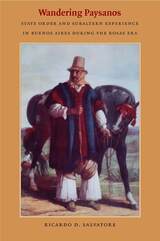 Wandering Paysanos: State Order and Subaltern Experience in Buenos Aires during the Rosas Era
Ricardo D. Salvatore
Duke University Press, 2003 A pioneering examination of the experiences of peasants and peons, or paysanos, in the Buenos Aires province during Juan Manuel de Rosas’s regime (1829–1852), Wandering Paysanos is one of the first studies to consider Argentina’s history from a subalternist perspective. The distinguished Argentine historian Ricardo D. Salvatore situates the paysanos as mobile job seekers within an expanding, competitive economy as he highlights the points of contention between the peasants and the state: questions of military service, patriotism, crime, and punishment. He argues that only through a reconstruction of the different subjectivities of paysanos—as workers, citizens, soldiers, and family members—can a new understanding of postindependence Argentina be achieved. Drawing extensively on judicial and military records, Salvatore reveals the state’s files on individual prisoners and recruits to be surprisingly full of personal stories directly solicited from paysanos. While consistently attentive to the fragmented and mediated nature of these archival sources, he chronicles how peons and peasants spoke to power figures—judges, police officers, and military chiefs—about issues central to their lives and to the emerging nation. They described their families and their wanderings across the countryside in search of salaried work, memories and impressions of the civil wars, and involvement with the Federalist armies. Their lamentations about unpaid labor, disrespectful government officials, the meaning of poverty, and the dignity of work provide vital insights into the contested nature of the formation of the Argentine Confederation. Wandering Paysanos discloses a complex world until now obscured—that of rural Argentine subalterns confronting the state.
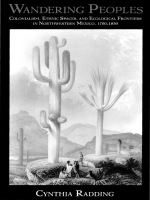 Wandering Peoples: Colonialism, Ethnic Spaces, and Ecological Frontiers in Northwestern Mexico, 1700–1850
Cynthia Radding
Duke University Press, 1997 Wandering Peoples is a chronicle of cultural resiliency, colonial relations, and trespassed frontiers in the borderlands of a changing Spanish empire. Focusing on the native subjects of Sonora in Northwestern Mexico, Cynthia Radding explores the social process of peasant class formation and the cultural persistence of Indian communities during the long transitional period between Spanish colonialism and Mexican national rule. Throughout this anthropological history, Radding presents multilayered meanings of culture, community, and ecology, and discusses both the colonial policies to which peasant communities were subjected and the responses they developed to adapt and resist them.
Radding describes this colonial mission not merely as an instance of Iberian expansion but as a site of cultural and political confrontation. This alternative vision of colonialism emphasizes the economic links between mission communities and Spanish mercantilist policies, the biological consequences of the Spanish policy of forced congregación, and the cultural and ecological displacements set in motion by the practices of discipline and surveillance established by the religious orders. Addressing wider issues pertaining to ethnic identities and to ecological and cultural borders, Radding’s analysis also underscores the parallel production of colonial and subaltern texts during the course of a 150-year struggle for power and survival.
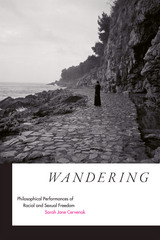 Wandering: Philosophical Performances of Racial and Sexual Freedom
Sarah Jane Cervenak
Duke University Press, 2014 Combining black feminist theory, philosophy, and performance studies, Sarah Jane Cervenak ruminates on the significance of physical and mental roaming for black freedom. She is particularly interested in the power of wandering or daydreaming for those whose mobility has been under severe constraint, from the slave era to the present. Since the Enlightenment, wandering has been considered dangerous and even criminal when associated with people of color. Cervenak engages artist-philosophers who focus on wayward movement and daydreaming, or mental travel, that transcend state-imposed limitations on physical, geographic movement. From Sojourner Truth's spiritual and physical roaming to the rambling protagonist of Gayl Jones's novel Mosquito, Cervenak highlights modes of wandering that subvert Enlightenment-based protocols of rationality, composure, and upstanding comportment. Turning to the artists Pope.L (William Pope.L), Adrian Piper, and Carrie Mae Weems, Cervenak argues that their work produces an otherworldly movement, an errant kinesis that exceeds locomotive constraints, resisting the straightening-out processes of post-Enlightenment, white-supremacist, capitalist, sexist, and heteronormative modernity. Their roaming animates another terrain, one where free, black movement is not necessarily connected to that which can be seen, touched, known, and materially valued.
The Wandering Scholars
Helen Waddell
University of Michigan Press, 1990 “There is no beginning,” writes Helen Waddell in her introduction to this classic, “to a history of medieval Latin. Its roots take hold too firmly on the kingdoms of the dead. The scholar’s lyric of the twelfth century seems as new a miracle as the first crocus; but its earth is the leafdrift of centuries of forgotten scholarship.” This book is the record of the Wandering Scholars, makers, and singers of medieval Latin, and their vanished Order.
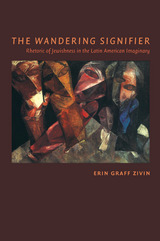 The Wandering Signifier: Rhetoric of Jewishness in the Latin American Imaginary
Erin Graff Zivin
Duke University Press, 2008 While Jews figure in the work of many modern Latin American writers, the questions of how and to what end they are represented have received remarkably little critical attention. Helping to correct this imbalance, Erin Graff Zivin traces the symbolic presence of Jews and Jewishness in late-nineteenth- through late-twentieth-century literary works from Argentina, Brazil, Peru, Mexico, Colombia, and Nicaragua. Ultimately, Graff Zivin’s investigation of representations of Jewishness reveals a broader, more complex anxiety surrounding difference in modern Latin American culture. In her readings of Spanish American and Brazilian fiction, Graff Zivin highlights inventions of Jewishness in which the concept is constructed as a rhetorical device. She argues that Jewishness functions as a wandering signifier that while not wholly empty, can be infused with meaning based on the demands of the textual project in question. Just as Jews in Latin America possess distinct histories relative to their European and North American counterparts, they also occupy different symbolic spaces in the cultural landscape. Graff Zivin suggests that in Latin American fiction, anxiety, desire, paranoia, attraction, and repulsion toward Jewishness are always either in tension with or representative of larger attitudes toward otherness, whether racial, sexual, religious, national, economic, or metaphysical. She concludes The Wandering Signifier with an inquiry into whether it is possible to ethically represent the other within the literary text, or whether the act of representation necessarily involves the objectification of the other.
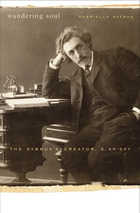 Wandering Soul: The Dybbuk’s Creator, S. An-sky
Gabriella Safran
Harvard University Press, 2010 The man who would become S. An-sky—ethnographer, war correspondent, author of the best-known Yiddish play, The Dybbuk—was born Shloyme-Zanvl Rapoport in 1863, in Russia’s Pale of Settlement. His journey from the streets of Vitebsk to the center of modern Yiddish and Hebrew theater, by way of St. Petersburg, Paris, and war-torn Austria-Hungry, was both extraordinary and in some ways typical: Marc Chagall, another child of Vitebsk, would make a similar transit a generation later. Like Chagall, An-sky was loyal to multiple, conflicting Jewish, Russian, and European identities. And like Chagall, An-sky made his physical and cultural transience manifest as he drew on Jewish folk culture to create art that defied nationality.
Leaving Vitebsk at seventeen, An-sky forged a number of apparently contradictory paths. A witness to peasant poverty, pogroms, and war, he tried to rescue the vestiges of disappearing communities even while fighting for reform. A loner addicted to reinventing himself—at times a Russian laborer, a radical orator, a Jewish activist, an ethnographer of Hasidism, a wartime relief worker—An-sky saw himself as a savior of the people’s culture and its artifacts. What united the disparate strands of his life was his eagerness to speak to and for as many people as possible, regardless of their language or national origin.
In this first full-length biography in English, Gabriella Safran, using Russian, Yiddish, Hebrew, and French sources, recreates this neglected protean figure who, with his passions, struggles, and art, anticipated the complicated identities of the European Jews who would follow him.
 Wandering Spirits: Loneliness and Longing in Greenland
Janne Flora
University of Chicago Press, 2019 It is common to think of the Arctic as remote, perched at the farthest reaches of the world—a simple and harmonious, isolated utopia. But the reality, as Janne Flora shows us, is anything but. In Wandering Spirits, Flora reveals how deeply connected the Arctic is to the rest of the world and how it has been affected by the social, political, economic, and environmental shifts that ushered in the modern age.
In this innovative study, Flora focuses on Inuit communities in Greenland and addresses a central puzzle: their alarmingly high suicide rate. She explores the deep connections between loneliness and modernity in the Arctic, tracing the history of Greenland and analyzing the social dynamics that shaped it. Flora’s thorough, sensitive engagement with the families that make up these communities uncovers the complex interplay between loneliness and a host of economic and environmental practices, including the widespread local tradition of hunting. Wandering Spirits offers a vivid portrait of a largely overlooked world, in all its fragility and nuance, while engaging with core anthropological concerns of kinship and the structure of social relations.
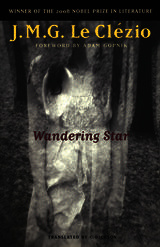 Wandering Star
J.M.G. Le Clézio
Northwestern University Press, 2009 “This is Nobel-quality writing, an international author with a mature style telling a story to the peak of his capacity. The English language needs more of it.” —The Telegraph From the winner of the 2008 Nobel Prize for Literature, Wandering Star is the story of two young women, one uprooted by the Holocaust and the other by the founding of the state of Israel. Bearing witness to the boundless strength of the spirit, and based on his own experience as a child in World War II, J.M.G. Le Clézio chronicles the saga of a young girl, Esther, who, in a small mountain village north of Nice occupied by Italian forces, learns what it means to be Jewish in wartime Europe. A quiet young teenager, she suffers the loss of her beloved father and, with her mother, is forced to flee advancing German troops. At war’s end, Esther and her mother make an arduous journey to Jerusalem, where their path crosses with a group of displaced refugees, including Nejma, a Palestinian girl whose story of life in the camps balances Esther’s own tale of suffering and survival. Esther and Nejma never meet again, but in their respective exiles, they are forever haunted by the memory of one another. Wandering Star is a powerful coming-of-age story and, as Le Figaro notes, truly “a luminous lesson in humanity.”
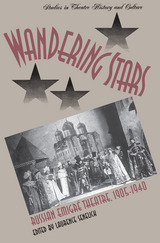 Wandering Stars: Russian Emigré Theatre, 1905-1940
Laurence Senelick
University of Iowa Press, 1992 From the beginning of this century, wars, pogroms, revolution, and economic hardship have impelled Russian cultural figures to seek their fortunes abroad—and theatre people have been no exception. This movement was a windfall for Western Europe and North America, for often the most talented and exciting actors and directors put down roots in foreign lands. Their styles and messages were transmuted in the process, but the inspiration they provided was tremendous. Now, Wandering Stars is the first book in any language to look closely at this theatrical emigration. Essays by Russian and American scholars and practitioners examine the ways in which the process of transplanting art distorted, magnified, or otherwise altered originals and how expectations on both sides led to disappointments and achievements. A particular strength of this collection is its attention to the question of the transmission of one culture to another. The thirteen essays in Wandering Stars, originally presented at a landmark 1991 conference at Harvard University, approach a host of historical, cultural, and theatrical issues. The effects of the pioneer touring companies of Pavel Orlenev, Alla Nazimova, and, most significantly, the Moscow Art Theatre are traced. The fates of actors like Maria Germanova and directors like Theodore Komisarjevsky who settled in the West receive careful inquiry. The techniques and influences of charismatic teachers such as Michael Chekhov and Andrius Jilinsky are examined, and the fortunes of cabarets like the Chauve-Souris and experimental playwrights like Nikolay Evreinov are given careful study. In addition, essays analyze the fascination America has held for Russian artists throughout history and the problems which face any emigrant who tries to preserve the best of his or her culture in an alien environment. With the continuing interest in interculturalism evinced in the academy, popular literature, and the media, Wandering Stars makes a vital and timely contribution to the ongoing inquiry and debate. This book should be of interest to all students of theatre and Russian life and all those with an abiding interest in the realities of a global society.
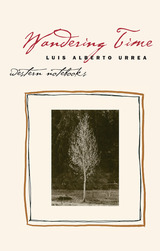 Wandering Time: Western Notebooks
Luis Alberto Urrea
University of Arizona Press, 1999 Fleeing a failed marriage and haunted by ghosts of his past, Luis Alberto Urrea jumped into his car and headed west. Driving cross-country with a cat named Rest Stop, Urrea wandered the West from one year’s spring through the next. Hiking into aspen forests where leaves “shiver and tinkle like bells” and poking alongside creeks in the Rockies, he sought solace and wisdom. In the forested mountains he learned not only the names of trees—he learned how to live. As nature opened Urrea’s eyes, writing opened his heart. In journal entries that sparkle with discovery, Urrea ruminates on music, poetry, and the landscape. With wonder and spontaneity, he relates tales of marmots, geese, bears, and fellow travelers. He makes readers feel mountain air “so crisp you feel you could crunch it in your mouth” and reminds us all to experience the magic and healing of small gestures, ordinary people, and common creatures. Urrea has been heralded as one of the most talented writers of his generation. In poems, novels, and nonfiction, he has explored issues of family, race, language, and poverty with candor, compassion, and often astonishing power. Wandering Time offers his most intimate work to date, a luminous account of his own search for healing and redemption.
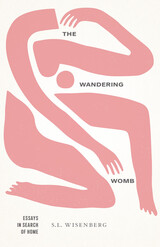 The Wandering Womb: Essays in Search of Home
S. L. Wisenberg
University of Massachusetts Press, 2023 Even as a fourth-generation Jewish Texan, S. L. Wisenberg has always felt the ghost of Europe dogging her steps, making her feel uneasy in her body and in the world. At age six, she’s sure that she hears Nazis at her bedroom window and knows that after they take her away, she’ll die without her asthma meds. In her late twenties, she infiltrates sorority rush at her alma mater, curious about whether she’ll get a bid now. Later in life, she makes her first and only trip to the mikvah while healing from a breast biopsy (benign this time), prompting an exploration of misogyny, shame, and woman-fear in rabbinical tradition. With wit, verve, blood, scars, and a solid dose of self-deprecation, Wisenberg wanders across the expanse of continents and combs through history books and family records in her search for home and meaning. Her travels take her from Selma, Alabama, where her Eastern European Jewish ancestors once settled, to Vienna, where she tours Freud’s home and figures out what women really want, and she visits Auschwitz, which—disappointingly—leaves no emotional mark.
 Wanderlust: The Amazing Ida Pfeiffer, the First Female Tourist
John van Wyhe
National University of Singapore Press, 2019 I found no one to accompany me, and was determined to do; so I trusted to fate, and went alone.
In 1797 in Vienna, Ida Pfeiffer was born into a world that should have been too small for her dreams. The daughter of an Austrian merchant, she made clear from an early age that she would not be bound by convention, dressing in boys’ clothing and playing sports. After her tutor introduced her to stories of faraway lands, she became determined to see the world first-hand. This determination led to a lifetime of travel—much of it alone—and made her one of the most famous women of the nineteenth century.
Pfeiffer faced many obstacles, not least expectations of her gender. She was a typical nineteenth century housewife with a husband and two sons. She was not wealthy nor well connected. Yet after the death of her husband, and once her sons were grown and settled, at the age of forty-one she set off on her first journey, not telling anyone the true extent of her travel plans. Between that trip and her death in 1858, she would barely pause for breath, circling the globe twice—the first woman to do so—and publishing numerous popular books about her travels. Usually traveling solo, Pfeiffer faced storms at sea, trackless deserts, plague, malaria, earthquakes, robbers, murderers, and other risks.
In Wanderlust, John Van Wyhe tells Pfeiffer’s story, with generous excerpts from her published accounts, tell of her involvement with spies, international intrigue, and more. The result is a compelling portrait of the remarkable life of a pioneer unjustly forgotten.
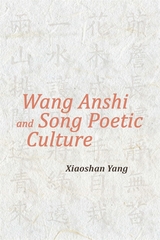 Wang Anshi and Song Poetic Culture
Xiaoshan Yang
Harvard University Press, 2021 A poetic culture consists of a body of shared values and conventions that shape the composition and interpretation of poetry in a given historical period. This book on Wang Anshi (1021–1086) and Song poetic culture—the first of its kind in any Western language—brings into focus a cluster of issues that are central to the understanding of both the poet and his cultural milieu. These issues include the motivations and consequences of poetic contrarianism and the pursuit of novelty, the relationship between anthology compilation and canon formation, the entanglement of poetry with partisan politics, Buddhist orientations in poetic language, and the development of the notion of late style.
Though diverse in nature and scope, the issues all bear the stamp of the period as well as Wang Anshi’s distinct personality. Conceived of largely as a series of case studies, the book’s individual chapters may be read independently of each other, but together they form a varied, if only partial, mosaic of Wang Anshi’s work and its critical reception in the larger context of Song poetic culture.
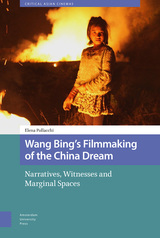 Wang Bing's Filmmaking of the China Dream: Narratives, Witnesses and Marginal Spaces
Elena Pollacchi
Amsterdam University Press, 2021 This volume offers an organic discussion of Wang Bing's filmmaking across China’s marginal spaces and against the backdrop of the state-sanctioned 'China Dream'. Wang Bing's cinema gives voice to the subaltern. Focusing on contemporary China, his work testifies to a set of issues dealing with inequality, labour, and migration. His internationally awarded documentaries are considered masterpieces with unique aesthetics that bear reference to global film masters. Therefore, this investigation goes beyond the divides between Western and non-Western film traditions and between fiction and documentary cinema. Each chapter takes a different articulation of space (spaces of labour, history, and memory) as its entry point, bringing together film and documentary studies, Chinese studies, and globalization studies. This volume benefits from the author's extensive conversations with Wang Bing and insider observations of film production and the film festival circuit.
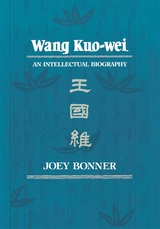 Wang Kuo-wei: An Intellectual Biography
Joey Bonner
Harvard University Press, 1986 In this first full-fledged intellectual biography of the brilliant and multifaceted Chinese scholar Wang Kuo-wei (1877–1927), Joey Bonner throws important new light on the range and course of ideas in early twentieth-century China. Coincidentally, she illuminates the nature of Wang’s intimate, thirty-year personal and professional association with the well-known Chinese scholar Lo Chen-yü (1866–1940) and provides a most comprehensive and compelling account of her biographee’s posthumously controversial career in the years following the 1911 Revolution.
Pursuing her subject across the whole spectrum of his many scholarly interests, Bonner critically examines Wang’s essays on German philosophy and philosophical aesthetics; his poetry, literary criticism, and aesthetic theory; and his works on ancient Chinese history, particularly of the Shang dynasty. Insightfully relating his strenuous intellectual search in the fields of philosophy, literature, and history to his very personal quest for truth, beauty, and virtue, Bonner shows in this finely crafted book how Wang’s unhappiness in later life as well as his suicide can be understood only within the context of his humanistic concerns in general and his extreme commitment in the postimperial period to the Confucian ethicoreligious tradition in particular. Without compromising the clearheaded critical detachment that characterizes her analysis of the intricacies of his thought, Bonner has produced a portrait of Wang Kuo-wei suffused with warmth and sympathetic respect.
Wangari Maathai
Tabitha Kanogo
Ohio University Press, 2020 Wangari Muta Maathai is one of Africa’s most celebrated female activists. Originally trained as a scientist in Kenya and abroad, Professor Maathai returned to her home country of Kenya with a renewed political consciousness. There, she began her long career as an activist, campaigning for environmental and social justice while speaking out against government corruption. In 2004, Maathai was awarded the Nobel Peace Prize for her leadership of the Green Belt Movement, a conservation effort that resulted in the restoration of African forests decimated during the colonial era. In this biography, Tabitha Kanogo follows Wangari Maathai from her modest, rural Kenyan upbringing to her rise as a national figure campaigning for environmental and ecological conservation, sustainable development, democracy, human rights, gender equality, and the eradication of poverty until her death in 2011.
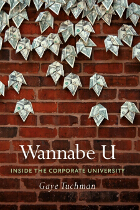 Wannabe U: Inside the Corporate University
Gaye Tuchman
University of Chicago Press, 2009 Based on years of observation at a large state university, Wannabe U tracks the dispiriting consequences of trading in traditional educational values for loyalty to the market. Aping their boardroom idols, the new corporate administrators at such universities wander from job to job and reductively view the students there as future workers in need of training. Obsessed with measurable successes, they stress auditing and accountability, which leads to policies of surveillance and control dubiously cloaked in the guise of scientific administration. In this eye-opening exposé of the modern university, Tuchman paints a candid portrait of the corporatization of higher education and its impact on students and faculty. Like the best campus novelists, Tuchman entertains with her acidly witty observations of backstage power dynamics and faculty politics, but ultimately Wannabe U is a hard-hitting account of how higher education’s misguided pursuit of success fails us all.
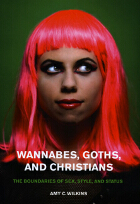 Wannabes, Goths, and Christians: The Boundaries of Sex, Style, and Status
Amy C. Wilkins
University of Chicago Press, 2008 On college campuses and in high school halls, being white means being boring. Since whiteness is the mainstream, white kids lack a cultural identity that’s exotic or worth flaunting. To remedy this, countless white youths across the country are now joining more outré subcultures like the Black- and Puerto Rican–dominated hip-hop scene, the glamorously morose goth community, or an evangelical Christian organization whose members reject campus partying.
Amy C. Wilkins’s intimate ethnography of these three subcultures reveals a complex tug-of-war between the demands of race, class, and gender in which transgressing in one realm often means conforming to expectations in another. Subcultures help young people, especially women, navigate these connecting territories by offering them different sexual strategies: wannabes cross racial lines, goths break taboos by becoming involved with multiple partners, and Christians forego romance to develop their bond with God. Avoiding sanctimonious hysteria over youth gone astray, Wilkins meets these kids on their own terms, and the result is a perceptive and provocative portrait of the structure of young lives.
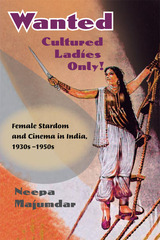 Wanted Cultured Ladies Only!: Female Stardom and Cinema in India, 1930s-1950s
Neepa Majumdar
University of Illinois Press, 2008 Wanted Cultured Ladies Only! maps out the early culture of cinema stardom in India from its emergence in the silent era to the decade after Indian independence in the mid-twentieth century. Neepa Majumdar combines readings of specific films and stars with an analysis of the historical and cultural configurations that gave rise to distinctly Indian notions of celebrity. She argues that discussions of early cinematic stardom in India must be placed in the context of the general legitimizing discourse of colonial "improvement" that marked other civic and cultural spheres as well, and that "vernacular modernist" anxieties over the New Woman had limited resonance here. Rather, it was through emphatically nationalist discourses that Indian cinema found its model for modern female identities. Considering questions of spectatorship, gossip, popularity, and the dominance of a star-based production system, Majumdar details the rise of film stars such as Sulochana, Fearless Nadia, Lata Mangeshkar, and Nargis.
 Wanted Dead or Alive: THE AMERICAN WEST IN POPULAR CULTURE
Edited by Richard Aquila
University of Illinois Press, 1996 Ah, the Wild West! Wide open plains, beautiful sunsets, and thundering herds. Days when the cowboy was king, and good guys always wore white. The love affair with the American West has stood the test of time and survived competition from sports, electronic gadgets, and reality.
Wanted Dead or Alive presents the first-ever comprehensive look at how the American West has been depicted in popular culture. Following Richard Aquila's introduction, which examines the birth and growth of the pop culture West in the context of American history, noted experts explore developments in popular Western fiction, major forms of live Western entertainment, trends in Western movies and television shows, images of the West in popular music, and visual images of the West in popular art and advertising. For the reader on the trail of even more information, each section of the book concludes with suggestions for further reading.
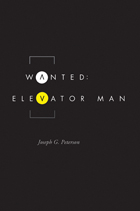 Wanted: Elevator Man
Joseph G. Peterson
Northern Illinois University Press, 2012
Balladeer of the city’s broken and forgotten men, Joseph G. Peterson looks for inspiration in urban side streets and alleys, where crooked schemes are hatched, where lives end violently, and where pretty much everyone is up to no good. Depicting the lives of people who have woefully lost their way in the world—criminals and victims, the unemployed and unemployable, the neglected and the indigent, the lonely and the alone—Peterson nonetheless brings a poet’s touch to his work, which is redolent with allegory, allusion, and Nabokovian wordplay. His last novel, Beautiful Piece, garnered praise from across the literary spectrum. Enter Wanted: Elevator Man, his powerful and ambitious new novel and the story of Eliot Barnes Jr., a man at the end of his proverbial rope.
Haunted by the larger-than-life shadow of his father, a scientist who may have helped develop the atomic bomb, twenty-nine-year-old Eliot Barnes, Jr., is an apple that’s fallen far from the tree. Saddled with a useless degree in literature, caged in a rundown apartment he can’t afford, and embittered by his failure to live up to the future’s promise, Barnes, who dreams of a corner office—an aerie roost high above the city, working with the higher-ups—begrudgingly accepts a job as an elevator man in a downtown Chicago skyscraper. Thus begins a profound but comedic meditation on failure in this life, how one comes to terms with not achieving one’s dreams, the nature and origin of such dreams, and, fittingly, the meaning of the American dream itself.
As unflinching as Nelson Algren and as romantic as Saul Bellow, Peterson’s novel boasts wildly surreal plot twists and a lethal wit that frequently erupts into full-on hilarity. Wanted: Elevator Man is the perfect tale for learning to cope with diminished expectations in these dark and desperate times.
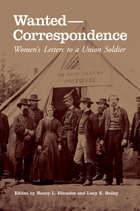 Wanted—Correspondence: Women’s Letters to a Union Soldier
Nancy L. Rhoades
Ohio University Press, 2009 A unique collection of more than 150 letters written to an Ohio serviceman during the American Civil War that offers glimpses of women’s lives as they waited, worked, and wrote from the Ohio home front. The letters reveal fascinating details of the lives of mostly young, single women—friends, acquaintances, love interests, and strangers who responded to one Union soldier’s advertisement for correspondents. Almost all of the women who responded to Lieutenant Edwin Lewis Lybarger’s lonely-hearts newspaper advertisement lived in Ohio and supported the Union. Lybarger carried the collection of letters throughout three years of military service, preserved them through his life, and left them to be discovered in an attic trunk more than a century after Lee’s surrender. Women’s letter writing functioned as a form of “war work” that bolstered the spirits of enlisted men and “kinship work” that helped forge romantic relationships and sustain community bonds across the miles. While men’s letters and diaries abound in Civil War history, less readily available are comprehensive collections of letters from middle-class and rural women that survived the weathering of marches, camp life, and battles to emerge unscathed from men’s knapsacks at war’s end. The collection is accompanied by a detailed editorial introduction that highlights significant themes in the letters. Together, they contribute to the still-unfolding historical knowledge concerning Northern women’s lives and experiences during this significant period in American history.
 Wanting Children: Family-Planning Policies and the Engineering of America’s Population
Leonard M. Lopoo
University of Chicago Press On the eugenic origins of US reproductive laws—and the surprising policy changes needed to remedy it. The US government spends hundreds of millions of dollars every year to promote and facilitate contraception. Whereas other wealthy countries support broader fertility interventions under the banner of “family planning,” the United States remains committed only to helping Americans—and especially poorer Americans—plan not to have a family. In an unflinching treatise on one of the century’s defining social issues, Leonard M. Lopoo shows how the US’s asymmetric reproductive approach is a vestige of the country’s earlier sins: America’s first reproductive policies were authored by the some of the twentieth century’s most prominent eugenicists, a group whose primary goal was birth prevention among lower economic classes and racial minorities. These origins have consequently created a contradictory position for the country today, in which contraception for the lowest-income Americans is subsidized, while many upper-class Americans employ technologies to have children with preferable traits. Lopoo recasts this personal and politicized topic in elegant, stark terms. If the United States is to legislate reproduction, the only defensible approach is equity: helping people who want children to have children. Wanting Children posits a new and elevating criterion for how we think about fertility in the twenty-first century.
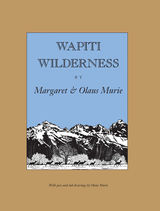 Wapiti Wilderness
Margaret Murie
University Press of Colorado, 1987 For over 37 years, Margaret and Olaus Murie made their home in the mountainous wilderness of the Tetons, where Olaus Murie conducted his famous studies of the American elk: the wapiti. Through these years their home was almost a nature-conservation shrine to thousands of Americans interested in outdoors, animals, and nature. Wapiti Wilderness, begun by Mrs. Murie as a sequel to her book Two in the Far North, which told of the Muries' life and expeditions in Alaska, became a collaborative effort by both the Muries.
In alternate chapters, Olaus tells of his work as a field biologist for the old U.S. Bureau of Biological Survey and recounts stories of his studies of not only elk but also other great animals. And Mrs. Murie, from her side, describes their life together on the trail and in the various camps and nature adventures in that wilderness during all four seasons. The book is replete with stories of Jackson Hole residents, “pioneer poets,” and the wild creatures that made their way into the Murie household. Olaus Murie's evocative pen-and-ink drawings illuminate each chapter, and four pages of photographs help complete the picture of what life was like in the wapiti wilderness.
The Wapsipinicon Almanac: Selections from Thirty Years
Timothy Fay
University of Iowa Press, 2023 In 1988, Timothy Fay published the very first issue of the Wapsipinicon Almanac at his Route 3 Press in Anamosa, Iowa. Fay’s goal was to offer a journal somewhat outside of mainstream Iowa journalism. For thirty years, the annual Wapsipinicon Almanac entertained midwestern readers with timely essays, works of fiction, news notes, art, poetry, and so much more. This book celebrates selections from three decades of the WapsipiniconAlmanac, so that readers can enjoy this important regional publication for years to come.
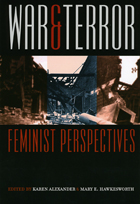 War & Terror: Feminist Perspectives
Edited by Karen Alexander and Mary Hawkesworth
University of Chicago Press, 2008 Traditional academic investigations of war seldom link armed conflict to practices of racialization or gendering. War and Terror: Feminist Perspectives provides a deeper understanding of the raced-gendered logics, practices, and effects of war. Consisting of essays originally published in Signs: Journal of Women in Culture and Society, this volume offers new insights into the complex dynamics of violent conflict and terror by investigating changing racial and gender formations within war zones and the collateral effects of war on race and gender dynamics in the context of two dozen armed struggles. Seldom-studied subjects such as the experiences of girl soldiers in Sierra Leone, female suicide bombers, and Pakistani mothers who recruit their sons for death missions are examined; women’s agency even under conditions of dire constraint is highlighted; and the complex interplay of gender, race, nation, culture, and religion is illuminated in this wide-ranging collection.
 The War against al-Qaeda: Religion, Policy, and Counter-narratives
Nahed Artoul Zehr
Georgetown University Press, 2019 In this original and provocative book, Nahed Artoul Zehr explores the theological underpinnings of al-Qaeda and related Islamic movements such as ISIS. She demonstrates how this marginal narrative transformed al-Qaeda from a relatively hierarchical and regional organization to a globalized, decentralized, and diffuse system of networks. She draws connections between religious ideas and strategy in her translation and analysis of leading theoretical and tactical jihad text, The Global Islamic Resistance Call, by Mustafa abu Mus’ ab al-Suri. Just as importantly, she questions al-Qaeda’s understanding of the Islamic tradition on the use of force, arguing that it reflects a weak understanding of this tradition. More specifically, it is al-Qaeda’s (and related groups’) break with this tradition that is key to an al-Qaeda defeat. Simultaneously, Zehr critiques the US military and policy establishment as it attempts to offer counter-narratives to the al-Qaeda phenomenon that emphasizes “good Muslims” versus “bad Muslims” in order to embrace a “moderate” form of Islam. According to Zehr, this approach is misguided: it is beyond the US government’s purview and expertise to make such theological claims about Islam. Better, she argues, to note the counter-narratives that are coming from within the Muslim community and other nongovernment institutions interested in moving this work forward. By refocusing our attention on al-Qaeda’s narrative and the various ways that
it is being contested, the book provides an alternate lens from which to view
al-Qaeda and the al-Qaeda phenomenon for Islamic and US foreign policy scholars and students.
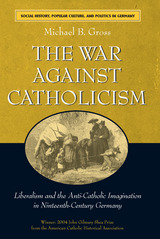 The War against Catholicism: Liberalism and the Anti-Catholic Imagination in Nineteenth-Century Germany
Michael B. Gross
University of Michigan Press, 2005 "A lucid, innovative work of top-flight scholarship. Gross shows us the depths of anti-Catholicism in nineteenth-century Germany; he explains why the German Kulturkampf had such force and why prominent liberals imagined it as a turning point not only in Germany but in world history."
---Helmut Walser Smith, Vanderbilt University
"A marvelously original account of how the Kulturkampf emerged from the cultural, social, and gendered worlds of German liberalism. While not neglecting the 1870s, Gross's analysis directs historians' attention to the under-researched 1850s and 1860s-decades in which liberals' anti-Catholic arguments were formulated against a backdrop of religious revival, democratic innovation, national ambition, and the articulation of new roles for women in society, politics, and the church. The drama of these decades resonates in every chapter of Gross's fine study."
---James Retallack, University of Toronto
"Michael Gross has put the culture back into the Kulturkampf! Integrating social and political analysis with illuminating interpretations of visual and linguistic evidence, Gross explores the work of religious cleavage in defining German national identity. An emerging women's movement, liberal virtues, and Catholic difference come together to explain why, in a century of secularization, Germany's Catholics experienced a religious revival, and why its liberals responded with enmity and frustration. Vividly written and a pleasure to read, this groundbreaking study offers real surprises."
---Margaret Lavinia Anderson, University of California, Berkeley
An innovative study of the relationship between the two most significant, equally powerful, and irreconcilable movements in Germany, Catholicism and liberalism, in the decades following the 1848 Revolution.
After the defeat of liberalism in the Revolution of 1848, and in the face of the dramatic revival of popular Catholicism, German middle-class liberals used anti-Catholicism to orient themselves culturally in a new age. Michael B. Gross's study shows how anti-Catholicism and specifically the Kulturkampf, the campaign to break the power of the Catholic Church, were not simply attacks against the church nor were they merely an attempt to secure state autonomy. Gross shows that the liberal attack on Catholicism was actually a complex attempt to preserve moral, social, political, and sexual order during a period of dramatic pressures for change.
Gross argues that a culture of anti-Catholicism shaped the modern development of Germany including capitalist economics, industrial expansion, national unification, and gender roles. He demonstrates that images of priests, monks, nuns, and Catholics as medieval, backward, and sexually deviant asserted the liberal middle-class claim to social authority after the Revolution of 1848. He pays particular attention to the ways anti-Catholicism, Jesuitphobia, and antimonastic hysteria were laced with misogyny and expressed deeper fears of mass culture and democracy in the liberal imagination. In doing so, he identifies the moral, social, and cultural imperatives behind the Kulturkampf in the 1870s.
By offering a provocative reinterpretation of liberalism and its relationship to the German anti-Catholic movement, this work ultimately demonstrates that in Germany, liberalism itself contributed to a culture of intolerance that would prove to be a serious liability in the twentieth century. It will be of particular interest to students and scholars of culture, ideology, religion, and politics.
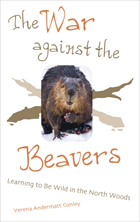 The War Against The Beavers: Learning to Be Wild in the North Woods
Verena Andermatt Conley
University of Minnesota Press, 2005 A lifelong city dweller, Verena Andermatt Conley had long harbored romantic ideals about the natural world and dreamed of a wilderness retreat for herself and her husband, Tom. When a sizable tract of land along the Vermillion River on the edge of Minnesota's Boundary Waters - complete with two primitive log cabins - became available, they jumped at the chance to own a piece of paradise.The War against the Beavers is a wry and funny account of two people's ten-year apprenticeship in backwoods living, from their arrival as literal babes in the woods to their education in the ways of nature as they face plagues of insects, fungus, storms, and droughts, and embark on a lengthy campaign to eradicate a colony of beavers that threatens the peace and beauty of their forest refuge. It is only the coming of a mechanized and much more menacing threat - bulldozers and other heavy machinery clear-cutting the woods - that restores perspective to the obsessed cabin dwellers.
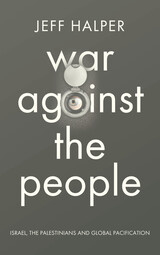 War Against the People: Israel, the Palestinians and Global Pacification
Jeff Halper
Pluto Press, 2015 * Shortlisted for the Palestine Book Awards 2016*
Modern warfare has a new form. The days of international combat are fading. So how do major world powers maintain control over their people today?
This book is a disturbing insight into the new ways world powers such as the US, Israel, Britain and China forge war today. It is a subliminal war of surveillance and whitewashed terror, conducted through new, high-tech military apparatuses, designed and first used in Israel against the Palestinian population. Including nano-technology, hidden camera systems, information databases on civilian activity, automated targeting systems and unmanned drones, it is used to control the very people the nation's leaders profess to serve.
Jeff Halper reveals that this practice is much more insidious than was previously thought. As Western governments claw back individual liberties, War Against the People is a reminder that fundamental human rights are being compromised for vast sections of the world, and that this is a subject that should concern everyone.
War and American Life: Reflections on Those Who Serve and Sacrifice
James Wright
Brandeis University Press, 2022 An engaging collection of essays focusing on American veterans. War and American Life is a book of essays and reflections by celebrated historian and former marine James Wright, who has been active as an advocate, teacher, and scholar. Featuring both previously published pieces and new essays, the book considers veterans in America and the ways in which our society needs better to understand who they are and what they have done on the nation’s behalf—and the responsibilities that follow this recognition.
War and an Irish Town
Eamonn McCann
Pluto Press, 1993 Eamonn McCann's account of what it is like to grow up a Catholic in a Northern Irish ghetto was first published in 1974. It quickly became a recognised as a classic account of the feelings generated by British rule. The author was at the centre of events in Derry which first brought Northern Ireland to world attention.
He witnessed the gradual transformation of the civil rights movement from a mild campaign for 'British Democracy' to an all-out military assault on the British state. This new edition updates the last edition (1980) with an additional introduction covering the last thirteen years.
War and an Irish Town is a trenchant, powerful narrative which reaches an unequivocal conclusion: 'There can be no internal solution to the Northern Ireland problem. The existence of the northern state is the problem'.
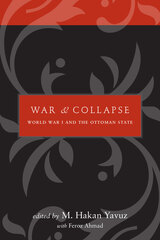 War and Collapse: World War I and the Ottoman State
Edited by M. Hakan Yavuz with Feroz Ahmad
University of Utah Press, 2015 War and Collapse is the third and final volume in a series that covers the last years of the Ottoman Empire. This book stems from a three-day international conference held in May 2012 at which scholars examined the causes and consequences of World War I, with a distinctive focus on how these events pertained to the Ottoman state and society. Fifty-three scholars—both new and established—contributed to this collection, with the goal of explaining what happened within the Ottoman Empire before and during WWI and how ethnic and national groups constructed these events to enhance their identities, promote their interests, and situate their collective selves in the international system. The chapters provide insight into the mindset and experiences of Ottoman peoples from the end of the Balkan Wars through the end of World War I, showing how earlier events set in motion the Ottoman response to the war and how continued engagement in conflict had devastating, irreversible effects on Ottoman society. The articles in this volume include a wide variety of ideas and points of view, thus presenting a comprehensive picture of the events.
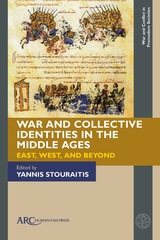 War and Collective Identities in the Middle Ages: East, West, and Beyond
Yannis Stouraitis
Arc Humanities Press, 2023 This book uses sociological perspectives to bring together work on war and identity in the Middle Ages relating to a range of peoples and geographical settings from Europe, the eastern Mediterranean, the Middle East, and Asia. Focusing on the interrelation between ideological practices and group formation, it examines the role of warfare in the emergence and decline of particular social structures, and changing patterns of collective identification. It contributes to the debate on the longue durée development of the phenomena of ethnicity and nationhood by drawing attention to the impact of war on the evolution of various types of polity and visions of community in the Middle Ages. Its use of non-European as well as European exemplars provides a wealth of fruitful comparative material, shedding new light on the relationship between medieval warfare and high-level identities.
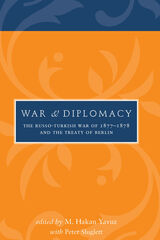 War and Diplomacy: The Russo-Turkish War of 1877-1878 and the Treaty of Berlin
M Hakan Yavuz
University of Utah Press, 2011 Combining different disciplinary perspectives, War and Diplomacy argues that the key events that portended the beginning of the end of the multiethnic Ottoman Empire were the The Russo-Turkish War of 1877–1878 and the Treaty of Berlin. The essays in this volume analyze how the war and the treaty permanently transformed the political landscape both in the Balkans and in the Caucasus. The treaty marked the end of Ottoman hegemony in the Balkans by formally recognizing the independence or de facto sovereignty of Romania, Serbia, and Montenegro, and the autonomy of Bulgaria. By introducing the unitary nation-state as the new organizing concept, the treaty planted the seeds of future conflict, from the Balkan Wars of 1912–1913 and the First World War to the recent civil wars and ethnic cleansing in former Yugoslavia. The magnitude of the defeat of the Ottoman Empire by Russia—and eventually by the other great powers—and the human, material, and territorial losses that followed proved fatal to the project of Muslim liberal reform and modernization that the Ottoman state had launched in the middle of the 19th century.
War and Diplomacy offers the first comparative examination of the treaty and its socio-political implications for the Balkans and the Caucasus by utilizing the theoretical tools and approaches of political science, sociology, history, and international relations. Representing the latest scholarship in the field of study, this volume documents the proceedings of a conference on the Treaty of Berlin that was held at the University of Utah in 2010. It provides an important contribution to understanding the historical background of these events.
War and Diplomacy documents the proceedings of the first of three conferences:
1878 Treaty of Berlin (in 2010)
Balkan Wars (in 2011)
World War I (in 2012)
Proceedings of the final two conferences will also be published by the University of Utah Press.
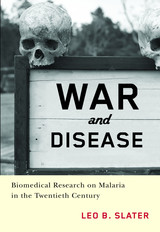 War and Disease: Biomedical Research on Malaria in the Twentieth Century
Leo B. Slater
Rutgers University Press, 2009 Malaria is one of the leading killers in the world today. Though drugs against malaria have a long history, attempts to develop novel therapeutics spanned the twentieth century and continue today. In this historical study, Leo B. Slater shows the roots and branches of an enormous drug development project during World War II. Fighting around the globe, American soldiers were at high risk for contracting malaria, yet quinine–a natural cure–became harder to acquire. A U.S. government-funded antimalarial program, initiated by the National Research Council, brought together diverse laboratories and specialists to provide the best drugs to the nation's military. This wartime research would deliver chloroquinine–long the drug of choice for prevention and treatment of malaria–and a host of other chemotherapeutic insights. A massive undertaking, the antimalarial program was to biomedical research what the Manhattan Project was to the physical sciences. A volume in the Critical Issues in Health and Medicine series, edited by Rima D. Apple and Janet Golden.
War and Empire: The American Way of Life
Paul L. Atwood
Pluto Press, 2010 In this provocative study, Paul Atwood attempts to show Americans that their history is one of constant wars of aggression and imperial expansion.
In his long teaching career, Atwood has found that most students know virtually nothing about America's involvement in the wars of the 20th century, let alone those prior to World War I. War and Empire aims to correct this, clearly and persuasively explaining US actions in every major war since the declaration of independence. The book shows that, far from being dragged reluctantly into foreign entanglements, America's leaders have always picked its battles in order to increase their influence and power, with little regard for the American soldiers and 'enemy' civilians killed or made to suffer in the process.
This book is an eye-opening introduction to the American way of life for undergraduate students of American history, politics and international relations.
 War and Faith: Ikko Ikki in Late Muromachi Japan
Carol Richmond Tsang
Harvard University Press, 2007 During the sengoku era—the period of "warring provinces" in fifteenth- and sixteenth-century Japan—warlords vied for supremacy and sought to expand their influence over the realm. Powerful religious institutions also asserted their military might by calling upon their adherents to do battle against forces that threatened their spiritual and secular interests.
The Honganji branch of Jodo Shinshu (True Pure Land Sect) Buddhism was one such powerhouse that exercised its military will by fanning violent uprisings of ikko ikki, loosely structured "leagues of one mind" made up of mostly commoners who banded together to fight for (or against) any number of causes—usually those advanced by the Honganji's Patriarch.
Carol Richmond Tsang delves into the complex and often contradictory relationship between these ikko leagues and the Honganji institution. Moving beyond the simplistic characterization of ikki as peasant uprisings, the author argues cogently for a fuller picture of ikko ikki as a force in medieval Japanese history. By exploring the political motivations and machinations of the Honganji and the diverse aims and allegiances of its ikko followers, Tsang complicates our understanding of ikko ikki as a multifaceted example of how religion and religious belief played out in a society in conflict.
 War and Its Discontents: Pacifism and Quietism in the Abrahamic Traditions
J. Patout Burns
Georgetown University Press, 1996 This volume examines the limits Islam, Judaism, and Christianity have set for the use of coercive violence. It probes the agreements and disagreements of these major religious traditions on pacifism (the abjurance of all force) and quietism (the avoidance of force unless certain stringent conditions are met). The distinguished contributors examine the foundations for nonviolence in each religion, criticize the positions each religion has taken, address the inherent challenges nonviolence poses, and evaluate the difficulty of practicing nonviolence in a secular society. The concluding essay defines the common ground, isolates the points of conflict, and suggests avenues of further inquiry. The most important contribution this volume makes is to demonstrate that no Western religious tradition provides a basis for the glorification of violence. Rather, each accepts warfare as a regretted necessity and sets strict limits on the use of force. This work offers new insights for those interested in the ethics of warfare, peace studies, religious traditions, and international affairs.
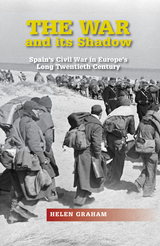 The War and Its Shadow: Spain's Civil War in Europe's Long Twentieth Century
Helen Graham
Sussex Academic Press, 2022 In Spain today, its civil war remains 'the past that will not pass away.' The long shadow of World War II also brings back to central focus its most disquieting aspects, revealing to a broader public the stark truth already known by specialist historians - that in Spain, as in the many other internecine wars that would soon convulse Europe, war was waged predominantly upon civilians: millions were killed, not by invaders and strangers, but by their own compatriots, including their own neighbors. Across the continent, Hitler's war of territorial expansion after 1938 would detonate a myriad 'irregular wars' of culture, as well as of politics, which took on a 'cleansing' intransigence, as those driving them sought to make 'homogeneous' communities, whether ethnic, political, or religious. So much of this was prefigured with primal intensity in Spain in 1936, where, on July 17-18, a group of army officers rebelled against the socially-reforming Republic. Saved from almost certain failure by Nazi and Fascist military intervention, and by a British inaction amounting to complicity, these army rebels unleashed a conflict in which civilians became the targets of mass killing. The new military authorities authorized and presided over an extermination of those sectors associated with Republican change, especially those who symbolized cultural change and thus posed a threat to old ways of being and thinking: progressive teachers, self-educated workers, 'new' women. In the Republican zone, resistance to the coup also led to the murder of civilians. This extrajudicial and communal killing in both zones would fundamentally make new political and cultural meanings that changed Spain's political landscape forever. The War and Its Shadow explores the origins, nature, and long-term consequences of this exterminatory war in Spain, charting the resonant forms of political, social, and cultural resistance to it and the memory/legacy these have left behind in Europe and beyond. Not least is our growing sense of the enormity of what, in greater European terms, the Republican war effort resisted: Nazi adventurism and the continent-wide wars of ethnic and political 'purification' it would unleash.
War and National Reinvention: Japan in the Great War, 1914–1919
Frederick R. Dickinson
Harvard University Press, 1999 For Japan, as one of the victorious allies, World War I meant territorial gains in China and the Pacific. At the end of the war, however, Japan discovered that in modeling itself on imperial Germany since the nineteenth century, it had perhaps been imitating the wrong national example. Japanese policy debates during World War I, particularly the clash between proponents of greater democratization and those who argued for military expansion, thus became part of the ongoing discussion of national identity among Japanese elites. This study links two sets of concerns—the focus of recent studies of the nation on language, culture, education, and race; and the emphasis of diplomatic history on international developments—to show how political, diplomatic, and cultural concerns work together to shape national identity.
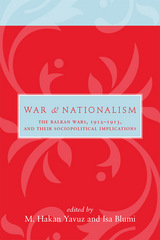 War and Nationalism: The Balkan Wars, 1912–1913, and Their Sociopolitical Implications
M Hakan Yavuz
University of Utah Press, 2013 War and Nationalism presents thorough up-to-date scholarship on the often misunderstood and neglected Balkan Wars of 1912 to 1913, which contributed to the outbreak of World War I. The essays contain critical inquiries into the diverse and interconnected processes of social, economic, and political exchange that escalated into conflict. The wars represented a pivotal moment that had a long-lasting impact on the regional state system and fundamentally transformed the beleaguered Ottoman Empire in the process.
This interdisciplinary volume stands as a critique of the standard discourse regarding the Balkan Wars and effectively questions many of the assumptions of prevailing modern nation-state histories, which have long privileged the ethno-religious dimensions present in the Balkans. The authors go to great lengths in demonstrating the fluidity of social, geographical, and cultural boundaries before 1912 and call into question the “nationalist watershed” notion that was artificially imposed by manipulative historiography and political machinations following the end of fighting in 1913.
War and Nationalism will be of interest to scholars looking to enrich their own understanding of an overshadowed historical event and will serve as a valuable contribution to courses on Ottoman and European history.
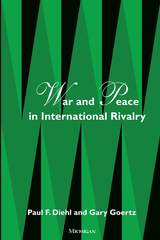 War and Peace in International Rivalry
Paul F. Diehl and Gary Goertz
University of Michigan Press, 2001 This book provides the first detailed analysis of international rivalries, the long-standing and often violent confrontations between the same pairs of states. The book addresses conceptual components of rivalries and explores the origins, dynamics, and termination of the most dangerous form of rivalry--enduring rivalry--since 1816.
Paul Diehl and Gary Goertz identify 1166 rivalries since 1816. They label sixty-three of those as enduring rivalries. These include the competitions between the United States and Soviet Union, India and Pakistan, and Israel and her Arab neighbors. The authors explain how rivalries form, evolve, and end.
The first part of the book deals with how to conceptualize and measure rivalries and presents empirical patterns among rivalries in the period 1816-1992. The concepts derived from the study of rivalries are then used to reexamine two central pieces of international relations research, namely deterrence and "democratic peace" studies. The second half of the book builds an explanation of enduring rivalries based on a theory adapted from evolutionary biology, "punctuated equilibrium."
The study of international rivalries has become one of the centerpieces of behavioral research on international conflict. This book, by two of the scholars who pioneered such studies, is the first comprehensive treatment of the subject. It will become the standard reference for all future studies of rivalries.
Paul F. Diehl is Professor of Political Science and University Distinguished Teacher/Scholar, University of Illinois. He is the coeditor of Reconstructing Realpolitik and coauthor of Measuring the Correlates of War. Gary Goertz is Assistant Professor of Political Science, University of Arizona, and is the coauthor with Paul Diehl of Territorial Change and International Conflict.
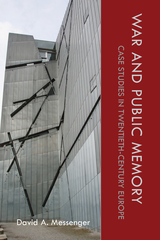 War and Public Memory: Case Studies in Twentieth-Century Europe
David A. Messenger
University of Alabama Press, 2020 An introduction to key issues in the study of war and memory that examines significant conflicts in twentieth-century Europe
In order to understand the history of twentieth-century Europe, we must first appreciate and accept how different societies and cultures remember their national conflicts. We must also be aware of the ways that those memories evolve over time. In War and Public Memory: Case Studies in Twentieth-Century Europe, Messenger outlines the relevant history of war and its impact on different European nations and assesses how and where the memory of these conflicts emerges in political and public discourse and in the public sphere and public spaces of Europe.
The case studies presented emphasize the major wars fought on European soil as well as the violence perpetrated against civilian populations. Each chapter begins with a brief overview of the conflict and then proceeds with a study of how memory of that struggle has entered into public consciousness in different national societies. The focus throughout is on collective social, cultural, and public memory, and in particular how memory has emerged in public spaces throughout Europe, such as parks, museums, and memorial sites.
Messenger discusses memories of the First World War for both the victors and the vanquished as well as their successor states. Other events discussed include the Bolshevik Revolution and subsequent conflicts in the former Soviet Union, the Armenian genocide, the collapse of Yugoslavia, the legacy of the civil war in Spain, Germanys reckoning with its Nazi past, and the memory of occupation and the Holocaust in France and Poland.
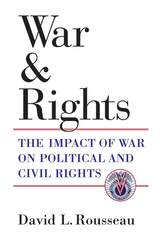 War and Rights: The Impact of War on Political and Civil Rights
David L. Rousseau
University of Michigan Press, 2021 Warfare in Europe contributed to the development of the modern state. In response to external conflict, state leaders raised armies and defended borders. The centralization of power, the development of bureaucracies, and the integration of economies all maximized revenue to support war. But how does a persistent external threat affect the development of a strong state? The “Garrison State” hypothesis argues that states that face a severe security threat will become autocracies. Conversely, the “Extraction School,” argues that warfare indirectly promotes the development of democratic institutions.
Execution of large-scale war requires the mobilization of resource and usually reluctant populations. In most cases, leaders must extend economic or political rights in exchange for resolving the crisis. Large-scale warfare thus expands political participation in the long run. The authors use empirical statistical modeling to show that war decreases rights in the short term, but the longer and bigger a war gets, the rights of the citizenry expand with the conflict. The authors test this argument through historical case studies—Imperial Russia, Austro-Hungarian Dual Monarchy, African Americans in World War I and II, and the Tirailleurs Senegalese in World War I—through the use of large-N statistical studies—Europe 1900–50 and Global 1893–2011—and survey data. The results identify when, where, and how war can lead to the expansion of political rights.
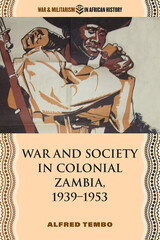 War and Society in Colonial Zambia, 1939–1953
Alfred Tembo
Ohio University Press, 2021 Written from a Zambian perspective, this leading study shows how the British colony of Northern Rhodesia (later Zambia) organized and deployed human, military, and natural resources during and after the Second World War. The Second World War brought unprecedented pressures to bear on Britain’s empire, which then included colonial Northern Rhodesia. Through new archival materials and oral histories, War and Society in Colonial Zambia tells—from an African perspective—the story of how the colony organized its human and natural resources on behalf of the imperial government. Alfred Tembo first examines government propaganda and recruitment of personnel for the Northern Rhodesia Regiment, which served in East Africa, Palestine, Ceylon, Burma, and India. Later, Zambia’s economic contribution to the Allied war effort would foreground the central importance of the colony’s mining industry as well as its role as supplier of rubber and beeswax following the fall of the Southeast Asian colonies to the Japanese in early 1942. Finally, Tembo presents archival and oral evidence about life on the home front, including the social impact of wartime commodity shortages, difficulties posed by incoming Polish refugees, and the more interventionist forms of colonial governance that these circumstances engendered.
 War and Society in the American Revolution: Mobilization and Home Fronts
Edited by John Resch and Walter Sargent
Northern Illinois University Press, 2007
The War for Independence touched virtually every American. It promised liberty, the opportunity for a better life, and the excitement of the battlefield. It also brought disappointment, misery, and mourning. In this collection of original essays that highlight the variety and richness of recent research, eleven leading historians investigate the diverse experiences of Americans from North to South, from coast to backcountry, from white townsfolk to African American slaves.
Revolutionary ideology may have inspired some soldiers in the Continental Army, but as the case studies in this volume document, the men of New England also weighed family commitments, economic concerns, and local politics when deciding whether or not to enlist in the militia. Slaves joined the army believing the war would bring them personal freedom while women served as auxiliaries or as camp followers. Those left behind defended the home front—unless the war took their homes and made them refugees. On the frontier, politically astute Native Americans weighed the relative advantages to themselves before deciding to support the patriots or the Crown.
By bringing together the perspectives of soldiers, women, African Americans, and American Indians, War and Society in the American Revolution gives readers a fuller sense of the meaning of this historical moment. At the same time, these essays show that instead of unifying Americans, the war actually exacerbated social divisions, leaving unresolved the inequalities and tensions that would continue to trouble the new nation.
War and Society in the Ancient and Medieval Worlds: Asia, the Mediterranean, Europe, and Mesoamerica
Kurt Raaflaub
Harvard University Press, 1999 This volume is a unique, multi-authored social history of war from the third millennium B.C.E. to the tenth century C.E. in the Mediterranean, the Near East, and Europe (Egypt, Achaemenid Persia, Greece, the Hellenistic World, the Roman Republic and Empire, the Byzantine Empire, the early Islamic World, and early Medieval Europe), with parallel studies of Mesoamerica (the Maya and Aztecs) and East Asia (ancient China, medieval Japan). The product of a colloquium at Harvard’s Center for Hellenic Studies, this volume offers a broadly based, comparative examination of war and military organization in their complex interactions with social, economic, and political structures as well as cultural practices.
 War and the Art of Governance: Consolidating Combat Success into Political Victory
Nadia Schadlow
Georgetown University Press, 2017 Success in war ultimately depends on the consolidation of political order. Nadia Schadlow argues that the steps needed to consolidate a new political order are not separate from war. They are instead an essential component of war and victory. The challenge of governance operations did not start with the wars in Iraq and Afghanistan. The US Army’s involvement in the political and economic reconstruction of states has been central to all its armed conflicts from large-scale conventional wars to so-called irregular or counterinsurgency wars. Yet, US policymakers and military leaders have failed to institutionalize lessons on how to consolidate combat gains into desired political outcomes. War and the Art of Governance examines fifteen historical cases of US Army military interventions, from the Mexican War through the wars in Iraq and Afghanistan. Improving future outcomes will require US policymakers and military leaders to accept that plans, timelines, and resources must be shaped to reflect this reality before they intervene in a conflict, not after things go wrong. Schadlow provides clear lessons for students and scholars of security studies and military history, as well as for policymakers and the military personnel who will be involved in the next foreign intervention.
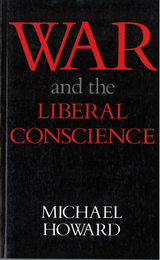 War and the Liberal Conscience
Howard, Michael
Rutgers University Press, 1987 For centuries liberal minded men have been horrified by the pain and waste of war. From Erasmus, who saw war above all as a product of stupidity, to the Marxists who see it as a matter of class conflict, they have produced social theories to account for its occurrence and have tried to devise means to end it.
Their prescriptions have been various. The central view of the Enlightenment was that wars would end when the ambitions of princes could be curbed by the sanity of ordinary men. At first the commercial classes seemed to be the new force that would produce this happy state, but by the end of the nineteenth century they themselves (the ‘capitalists’) were being stigmatized as the instigators of war.
Similarly, the nineteenth-century liberals at first believed that the rise of the new independent nation-states of Europe would lead to a permanent peace as the wishes of the masses (naturally peace-loving) were able to express themselves. Again, the supposed agents of peace were soon seen as a prime cause of wars.
Despite these contradictions there have been certain continuing themes in the search for a means to end wars, and one of the most enlightening things in this book is they way in which it is possible to see how these themes recur in subtly different forms in different periods of history. Professor Howard traces them from the renaissance to our own time, through the social, political and intellectual groups that gave birth to them.
Throughout the whole story runs the continuing contrast between those who hoped to find a single cause for the disease, leading to a lasting cure, and those who understood that, in Professor Howard’s words, ‘this was a task which needs to be tackled afresh every day of our lives’...
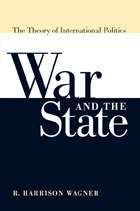 War and the State: The Theory of International Politics
R. Harrison Wagner
University of Michigan Press, 2010 War and the State exposes the invalid arguments employed in the unproductive debate about Realism among international relations scholars, as well as the common fallacy of sharply distinguishing between conflict among states and conflict within them. As R. Harrison Wagner demonstrates, any understanding of international politics must be part of a more general study of the relationship between political order and organized violence everywhere--as it was in the intellectual tradition from which modern-day Realism was derived. War and the State draws on the insights from Wagner's distinguished career to create an elegantly crafted essay accessible to both students and scholars. "Possibly the most important book on international relations theory since Kenneth Waltz's Theory of International Politics."
---James Fearon, Stanford University "This is one of the best books on international relations theory I have read in a very long time. It is required reading for any student of modern IR theory. Once again, Wagner has shown himself to be one of the clearest thinkers in the field today."
---Robert Powell, Robson Professor of Political Science, University of California, Berkeley "Painting on a vast canvas, and tackling and integrating topics such as state formation, domestic politics, and international conflict, R. Harrison Wagner's War and the State offers many brilliant insights into the nature of international relations and international conflict. War and the State compellingly highlights the importance of constructing rigorous and valid theorizing and sets a high standard for all students of international relations. The field has much to gain if scholars follow the trail blazed by Wagner in this book."
---Hein Goemans, University of Rochester R. Harrison Wagner is Professor of Government at the University of Texas.
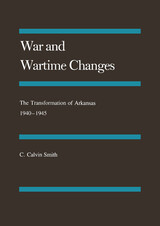 War and Wartime Changes: The Transformation of Arkansas, 1940–1945
C. Calvin Smith
University of Arkansas Press, 1986 This is a lively history of specific social, political, ad economic changes that all-out war brought to the home front in mid-America. Drawing from letters to the editor in local and state papers, from editorials, from personal interviews, and from the manuscript collections left by state political leaders, Calvin Smith brings into focus the impact of wartime not only upon agricultural and business economics but also upon particular social groups and the lives of individuals. The war generated the beginnings of a rights revolution in black communities throughout the nation. The author takes a careful look at the resulting strain on relations between the state’s black and white citizens. No less important is the consideration of Japanese Americans from the West Coast who were relocated to camps in Arkansas, and of the Jehovah’s Witnesses who would not take part in the war effort either on the battlefield or at home. War and Wartime Changes illuminates a fascinating and sometimes embarrassing segment of history which until now has not been presented in a single, cohesive work. The author details the unique experiences Arkansas had at this time as well as the patriotism its citizens felt for their country. Here is the story for the historian, for every student of society and its ways, and for anyone who wants to understand or remember the patriotic fervor of Americans during World War II. Calvin Smith has created, with persistent and imaginative research, a rare admixture of nostalgia and solid scholarship.
The War at Home: Perspectives on the Arkansas Experience during World War I
Mark K. Christ
University of Arkansas Press, 2020 The War at Home brings together some of the state’s leading historians to examine the connections between Arkansas and World War I. These essays explore how historical entities and important events such as Camp Pike, the Little Rock Picric Acid Plant, and the Elaine Race Massacre were related to the conflict as they investigate the issues of gender, race, and public health. This collection sheds new light on the ways that Arkansas participated in the war as well as the ways the war affected Arkansas then and still does today.
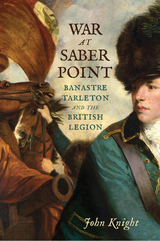 War at Saber Point: Banastre Tarleton and the British Legion
John Knight
Westholme Publishing, 2023 The American Loyalist Regiment Led by the Most Charismatic British Commander of the War
The British Legion was one of the most remarkable regiments, not only of the American Revolution, but of any war. A corps made up of American Loyalists, it saw its first action in New York and then engaged in almost every battle in the Southern colonies. Led by a twenty-four-year-old libertine who purchased his commission to escape enormous gambling debts, the Legion gained notoriety for its ruthless tactics. Excelling in “special operations,” they frequently overwhelmed the Continental forces they fought, becoming the most feared British regiment of the war.
Banastre Tarleton and the Americans he led have always been characterized as brutal, immoral villains—most recently in the movie, The Patriot. But this study subverts our pre-conceived notions of patriotism. The men who filled the Legions ranks were not weak-willed collaborators or treacherous renegades, but free men as motivated by conscience as the Patriots they battled. Few were wealthy. None had a vested stake in the British Government. Each believed that in defending the Crown; they were upholding the rule of law and preserving individual liberty.
These men followed Banastre Tarleton clear across America for years, sacrificing not only their families and homes but, in many instances, their lives. Self-interest could not have persuaded them to do this. Patriotism and fidelity did. Relying on first-hand accounts—letters, diaries, and journals—War at Saber Point: Banastre Tarleton and the British Legion is the enthralling story of those forgotten Americans and the young Englishman who led them.
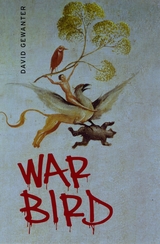 War Bird
David Gewanter
University of Chicago Press, 2009 From Three at 4:43 And here comes my friend, limping on his heavy boot, the heel come off. A cobbler's shop appears, and I buy the black nails, the dwarf's hammer, glue and strapping. I work hard on it, bending there until he speaks and walks on. But as he is dead, his voice and step make no sound. In his third book of poems, David Gewanter takes on wartime America, showing our personal costs and inextricable complicities. The constructs of our social lives, the conventions of our political values, the ambitions of our private fantasies—all these collide comically and tragically. Here, the far right marries the far left, and the sacred is undone by the profane. Gewanter's ironic vision pulls together details from science, history, philosophy, the disappearing dailies, and the emotional life of an engaged and singular mind into poems on the move with tense rhythms, rich correspondences, and daring hairpin turns. War Bird gives the lie to the shining moral complacencies of the homefront. Unsettling yet radiant, this collection is a book for troubled times, for what Whitman called, in “1861,” our “hurrying, crashing, sad, distracted year.”
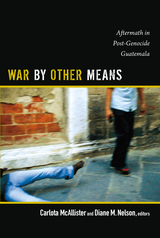 War by Other Means: Aftermath in Post-Genocide Guatemala
Carlota McAllister and Diane M. Nelson, eds.
Duke University Press, 2013 Between 1960 and 1996, Guatemala's civil war claimed 250,000 lives and displaced one million people. Since the peace accords, Guatemala has struggled to address the legacy of war, genocidal violence against the Maya, and the dismantling of alternative projects for the future. War by Other Means brings together new essays by leading scholars of Guatemala from a range of geographical backgrounds and disciplinary perspectives. Contributors consider a wide range of issues confronting present-day Guatemala: returning refugees, land reform, gang violence, neoliberal economic restructuring, indigenous and women's rights, complex race relations, the politics of memory, and the challenges of sustaining hope. From a sweeping account of Guatemalan elites' centuries-long use of violence to suppress dissent to studies of intimate experiences of complicity and contestation in richly drawn localities, War by Other Means provides a nuanced reckoning of the injustices that made genocide possible and the ongoing attempts to overcome them. Contributors. Santiago Bastos, Jennifer Burrell, Manuela Camus, Matilde González-Izás, Jorge Ramón González Ponciano, Greg Grandin, Paul Kobrak, Deborah T. Levenson, Carlota McAllister, Diane M. Nelson, Elizabeth Oglesby, Luis Solano, Irmalicia Velásquez Nimatuj, Paula Worby
 War by Other Means: Geoeconomics and Statecraft
Robert D. Blackwill and Jennifer M. Harris
Harvard University Press, 2016 A Foreign Affairs Best Book of 2016
Today, nations increasingly carry out geopolitical combat through economic means. Policies governing everything from trade and investment to energy and exchange rates are wielded as tools to win diplomatic allies, punish adversaries, and coerce those in between. Not so in the United States, however. America still too often reaches for the gun over the purse to advance its interests abroad. The result is a playing field sharply tilting against the United States.
“Geoeconomics, the use of economic instruments to advance foreign policy goals, has long been a staple of great-power politics. In this impressive policy manifesto, Blackwill and Harris argue that in recent decades, the United States has tended to neglect this form of statecraft, while China, Russia, and other illiberal states have increasingly employed it to Washington’s disadvantage.”
—G. John Ikenberry, Foreign Affairs
“A readable and lucid primer…The book defines the extensive topic and opens readers’ eyes to its prevalence throughout history…[Presidential] candidates who care more about protecting American interests would be wise to heed the advice of War by Other Means and take our geoeconomic toolkit more seriously.
—Jordan Schneider, Weekly Standard
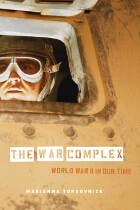 The War Complex: World War II in Our Time
Marianna Torgovnick
University of Chicago Press, 2005 The recent dedication of the World War II memorial and the sixtieth-anniversary commemoration of D-Day remind us of the hold that World War II still has over America's sense of itself. But the selective process of memory has radically shaped our picture of the conflict. Why else, for instance, was a 1995 Smithsonian exhibition on Hiroshima that was to include photographs of the first atomic bomb victims, along with their testimonials, considered so controversial? And why do we so readily remember the civilian bombings of Britain but not those of Dresden, Hamburg, and Tokyo?
Marianna Torgovnick argues that we have lived, since the end of World War II, under the power of a war complex—a set of repressed ideas and impulses that stems from our unresolved attitudes toward the technological acceleration of mass death. This complex has led to gaps and hesitations in public discourse about atrocities committed during the war itself. And it remains an enduring wartime consciousness, one most recently animated on September 11.
Showing how different events from World War II became prominent in American cultural memory while others went forgotten or remain hidden in plain sight, The War Complex moves deftly from war films and historical works to television specials and popular magazines to define the image and influence of World War II in our time. Torgovnick also explores the 1961 trial of Adolf Eichmann, the emotional legacy of the Holocaust, and the treatment of World War II's missing history by writers such as W. G. Sebald to reveal the unease we feel at our dependence on those who hold the power of total war. Thinking anew, then, about how we account for war to each other and ourselves, Torgovnick ultimately, and movingly, shows how these anxieties and fears have prepared us to think about September 11 and our current war in Iraq.
 War: Controlling Escalation
Richard Smoke
Harvard University Press, 1977 The risk that conflicts may escalate “out of control” is one of the greatest dangers confronting the world today. Experts are generally agreed that an atomic war would not come by sudden, all-out attack, because leaders everywhere know what retaliation they would face. The real danger is that some smaller conflict might grow larger and larger, at some point getting out of anyone’s control.
Despite its importance, escalation has received astonishingly little study by specialists. Now, in War: Controlling Escalation, Richard Smoke offers the first comprehensive, scientific examination of escalation processes and the first systematic attempt to find ways to control escalation. He examines in depth five major cases in modern history where escalation occupied center stage. Focusing on the question “How does escalation get out of control?” Smoke takes care to study not only factors at work in wars where this occurred, but also factors preventing it where this might have occurred but did not. The result is an all-inclusive analysis of how escalation processes work and what can be done to halt and control them. Throughout, the author maintains a pragmatic, operational focus, concluding with a set of practical “questions” that decision-makers can ask of their information in trying to keep escalation under control in future conflicts.
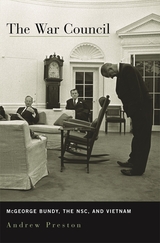 The War Council: McGeorge Bundy, the NSC, and Vietnam
Andrew Preston
Harvard University Press, 2010 Was the Vietnam War unavoidable? Historians have long assumed that ideological views and the momentum of events made American intervention inevitable. By examining the role of McGeorge Bundy and the National Security Council, Andrew Preston demonstrates that policymakers escalated the conflict in Vietnam in the face of internal opposition, external pressures, and a continually failing strategy.
Bundy created the position of National Security Adviser as we know it today, with momentous consequences that continue to shape American foreign policy. Both today's presidential supremacy in foreign policy and the contemporary national security bureaucracy find their origins in Bundy's powers as the first National Security Adviser and in the ways in which he and his staff brought about American intervention in Vietnam. Presidents Kennedy and Johnson were not enthusiastic about waging a difficult war in pursuit of murky aims, but the NSC's bureaucratic dexterity and persuasive influence in the Oval Office skewed the debate in favor of the conflict.
In challenging the prevailing view of Bundy as a loyal but quietly doubting warrior, Preston also revises our understanding of what it meant--and means--to be a hawk or a dove. The War Council is an illuminating and compelling story with two inseparable themes: the acquisition and consolidation of power; and how that power is exercised.
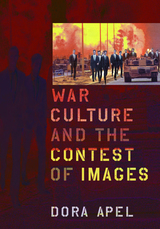 War Culture and the Contest of Images
Apel, Dora
Rutgers University Press, 2012 War Culture and the Contest of Images analyzes the relationships among contemporary war, documentary practices, and democratic ideals. Dora Apel examines a wide variety of images and cultural representations of war in the United States and the Middle East, including photography, performance art, video games, reenactment, and social media images. Simultaneously, she explores the merging of photojournalism and artistic practices, the effects of visual framing, and the construction of both sanctioned and counter-hegemonic narratives in a global contest of images. As a result of the global visual culture in which anyone may produce as well as consume public imagery, the wide variety of visual and documentary practices present realities that would otherwise be invisible or officially off-limits. In our digital era, the prohibition and control of images has become nearly impossible to maintain. Using carefully chosen case studies—such as Krzysztof Wodiczko’s video projections and public works in response to 9/11 and the wars in Iraq and Afghanistan, the performance works of Coco Fusco and Regina Galindo, and the practices of Israeli and Palestinian artists—Apel posits that contemporary war images serve as mediating agents in social relations and as a source of protection or refuge for those robbed of formal or state-sanctioned citizenship. While never suggesting that documentary practices are objective translations of reality, Apel shows that they are powerful polemical tools both for legitimizing war and for making its devastating effects visible. In modern warfare and in the accompanying culture of war that capitalism produces as a permanent feature of modern society, she asserts that the contest of images is as critical as the war on the ground.
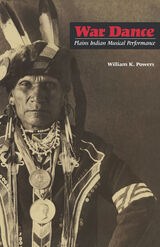 War Dance: Plains Indian Musical Performance
William K. Powers
University of Arizona Press, 1990 The Indian powwow, with its colorful war dance, is among the most vital aspects of American Indian culture. William Powers has witnessed both the traditions and trends in Plains Indian music and dance over the past thirty years, and here encapsulates his long career in what may be the first book that deals with Plains Indian musical culture as a unit. After providing background material on the study of American Indian music, Powers gives a full description of the popular war dance, discusses the powwow as the context in which the war dance appears, and describes associated dances. While observing that a fascination with "pan-Indianism" temporarily misdirected the study of Plains Indian music and dance by focusing too sharply on what many believed was a nationalization of American Indians, Powers notes that individual tribes continue to be concerned with maintaining their ethnic identities through their styles of music and dance. In the balance of the book, Powers offers essays describing Plains songs available on disc and tape, including notes on the history and culture of tribes and some translations of Lakota songs. A concluding essay offers some observations of why Plains Indian music and dance have received the interest they have and why they will continue to symbolize a burgeoning contemporary American Indian culture--not only on the Plains, but in every corner of the world where American Indians are respected, admired, and imitated.
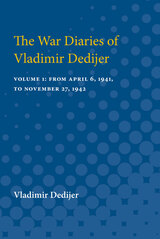 The War Diaries of Vladimir Dedijer: Volume 1: From April 6, 1941, to November 27, 1942
by Vladimir Dedijer
University of Michigan Press, 1990 After fleeing from occupied Beograd to the liberated territory in the Sumadija, Vladimir Dedijer began his life as a Yugoslavian Partisan. Commissioned at the request of then Commander Tito, Vladimir Dedijer began writing his diaries in April of 1941 to record the daily lives, battles, and casualties of the Yugoslavian Partisan Army. The War Diaries of Vladimir Dedijer represents a wealth of primary information about the lives and struggles of the Partisan brigades. There can be no complete understanding of Tito's Yugoslavia without knowing the Diaries' account of the extent of the Second World War's impact on Yugoslavia's people. Tito, who was a frequent reader of the Diaries as the Partisan Army fought across Yugoslavia, called this work "Our Great Obituary."To maintain a diary under the hardships of war was difficult. Among the hazards were river crossings, rain, self-censorship should the Germans find the diaries, and in many instances a shortage of ink. In fact, ink was in such demand that German supplies were targeted by Partisans during raids. Despite these difficulties, Dedijer continually recorded day-to-day life throughout the war. These three volumes contain his writings up to the liberation of Prague in November of 1944.The Diaries were originally published in Yugoslavia more than forty years ago, and have since gone through four editions. The original publication in 1945 caused great debate because of Dedijer's fierce commitment to speaking his views and his uncompromising dedication to recording what he lived. Many felt that Dedijer should not make public the names of Partisan heroes who supported Stalin during the bitter Stalin-Tito split, but in keeping with his values, Dedijer refused, with Tito supporting his decision.
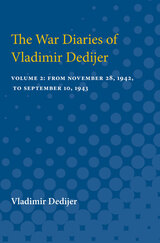 The War Diaries of Vladimir Dedijer: Volume 2: From November 28, 1942, to September 10, 1943
by Vladimir Dedijer
University of Michigan Press, 1990 After fleeing from occupied Beograd to the liberated territory in the Sumadija, Vladimir Dedijer began his life as a Yugoslavian Partisan. Commissioned at the request of then Commander Tito, Vladimir Dedijer began writing his diaries in April of 1941 to record the daily lives, battles, and casualties of the Yugoslavian Partisan Army. The War Diaries of Vladimir Dedijer represents a wealth of primary information about the lives and struggles of the Partisan brigades. There can be no complete understanding of Tito's Yugoslavia without knowing the Diaries' account of the extent of the Second World War's impact on Yugoslavia's people. Tito, who was a frequent reader of the Diaries as the Partisan Army fought across Yugoslavia, called this work "Our Great Obituary."To maintain a diary under the hardships of war was difficult. Among the hazards were river crossings, rain, self-censorship should the Germans find the diaries, and in many instances a shortage of ink. In fact, ink was in such demand that German supplies were targeted by Partisans during raids. Despite these difficulties, Dedijer continually recorded day-to-day life throughout the war. These three volumes contain his writings up to the liberation of Prague in November of 1944.The Diaries were originally published in Yugoslavia more than forty years ago, and have since gone through four editions. The original publication in 1945 caused great debate because of Dedijer's fierce commitment to speaking his views and his uncompromising dedication to recording what he lived. Many felt that Dedijer should not make public the names of Partisan heroes who supported Stalin during the bitter Stalin-Tito split, but in keeping with his values, Dedijer refused, with Tito supporting his decision.
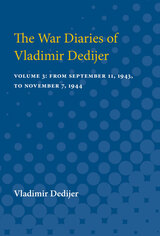 The War Diaries of Vladimir Dedijer: Volume 3: From September 11, 1943, to November 7, 1944
by Vladimir Dedijer
University of Michigan Press, 1990 After fleeing from occupied Beograd to the liberated territory in the Sumadija, Vladimir Dedijer began his life as a Yugoslavian Partisan. Commissioned at the request of then Commander Tito, Vladimir Dedijer began writing his diaries in April of 1941 to record the daily lives, battles, and casualties of the Yugoslavian Partisan Army. The War Diaries of Vladimir Dedijer represents a wealth of primary information about the lives and struggles of the Partisan brigades. There can be no complete understanding of Tito's Yugoslavia without knowing the Diaries' account of the extent of the Second World War's impact on Yugoslavia's people. Tito, who was a frequent reader of the Diaries as the Partisan Army fought across Yugoslavia, called this work "Our Great Obituary."To maintain a diary under the hardships of war was difficult. Among the hazards were river crossings, rain, self-censorship should the Germans find the diaries, and in many instances a shortage of ink. In fact, ink was in such demand that German supplies were targeted by Partisans during raids. Despite these difficulties, Dedijer continually recorded day-to-day life throughout the war. These three volumes contain his writings up to the liberation of Prague in November of 1944.The Diaries were originally published in Yugoslavia more than forty years ago, and have since gone through four editions. The original publication in 1945 caused great debate because of Dedijer's fierce commitment to speaking his views and his uncompromising dedication to recording what he lived. Many felt that Dedijer should not make public the names of Partisan heroes who supported Stalin during the bitter Stalin-Tito split, but in keeping with his values, Dedijer refused, with Tito supporting his decision.
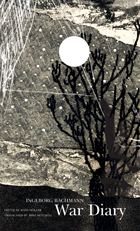 War Diary
Ingeborg Bachmann
Seagull Books, 2011 Austrian writer Ingeborg Bachmann (1926–73) is recognized as one of the most important novelists, poets, and playwrights of postwar German literature. As befitting such a versatile writer, her War Diary is not a day-by-day journal but a series of sketches, depicting the last months of World War II and the first year of the subsequent British occupation of Austria. These articulate and powerful entries—all the more remarkable taking into account Bachmann’s young age at the time—reveal the eighteen-year-old’s hatred of both war and Nazism as she avoids the fanatics’ determination to “defend Klagenfurt to the last man and the last woman.” The British occupation leads to her incredible meeting with a British officer, Jack Hamesh, a Jew who had originally fled Vienna for England in 1938. He is astonished to find in Austria a young girl who has read banned authors such as Mann, Schnitzler, and Hofmannsthal. Their relationship is captured here in the emotional and moving letters Hamesh writes to Bachmann when he travels to Israel in 1946. In his correspondence, he describes how in his new home of Israel, he still suffers from the rootlessness affecting so many of those who lost parents, family, friends, and homes in the war. War Diary provides unusual insight into the formation of Bachmann as a writer and will be cherished by the many fans of her work. But it is also a poignant glimpse into life in Austria in the immediate aftermath of the war, and the reflections of both Bachmann and Hamesh speak to a significant and larger story beyond their personal experiences. Praise for the German Edition “A minor sensation that will make literary history. Thanks to the excellent critical commentary, we gain a sense of a period in history and in Bachmann’s life that reached deep into her later work. . . . What makes these diary entries so special is . . . the detail of the resistance described, the exhilaration of unexpected peace, the joy of freedom.”—Die Zeit
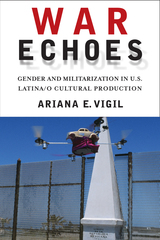 War Echoes: Gender and Militarization in U.S. Latina/o Cultural Production
Vigil, Ariana E
Rutgers University Press, 2014 War Echoes examines how Latina/o cultural production has engaged with U.S. militarism in the post–Viet Nam era. Analyzing literature alongside film, memoir, and activism, Ariana E. Vigil highlights the productive interplay among social, political, and cultural movements while exploring Latina/o responses to U.S. intervention in Central America and the Middle East. These responses evolved over the course of the late twentieth and early twenty-first centuries—from support for anti-imperial war, as seen in Alejandro Murguia's Southern Front, to the disavowal of all war articulated in works such as Demetria Martinez’s Mother Tongue and Camilo Mejia’s Road from Ar Ramadi. With a focus on how issues of race, class, gender, and sexuality intersect and are impacted by war and militarization, War Echoes illustrates how this country’s bellicose foreign policies have played an integral part in shaping U.S. Latina/o culture and identity and given rise to the creation of works that recognize how militarized violence and values, such as patriarchy, hierarchy, and obedience, are both enacted in domestic spheres and propagated abroad.
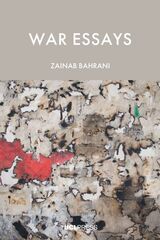 War Essays
Zainab Bahrani
University College London, 2025 This searing collection reveals how the plunder of Iraq’s heritage during the 2003 invasion was not collateral damage but part of a long history of imperial erasure.
In War Essays, Zainab Bahrani delivers a powerful reckoning of the destruction of Iraq’s cultural heritage in the wake of the 2003 invasion by weaving together personal experience and a critique of the enduring colonial practices of archaeology. Across two decades of essays, she examines the war’s devastating impact not only on human lives but also on Iraq’s historical landscapes, monuments, and memory, situating heritage loss within the broader geopolitics of the Middle East.
Bahrani confronts the prevailing narratives about the war, exposing how imperial violence extends beyond the battlefield to target history itself and reshaping the discipline of archaeology. By combining eyewitness testimony with theoretical inquiry, this book reflects on the role of intellectuals and historians in times of war and interrogates the responsibility of those who document conflict and its aftermath. Essential reading for scholars of Middle Eastern studies and archaeology, War Essays offers a unique and deeply personal perspective on the lasting scars of war and the fragile relationship between history and memory.
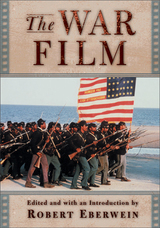 The War Film
Eberwein, Robert
Rutgers University Press, 2004 War has had a powerful impact on the film industry. But it is not only wars that affect films; films influence war-time behavior and incisively shape the way we think about the battles that have been waged.
In The War Film, Robert Eberwein brings together essays by scholars using a variety of critical approaches to explore this enduringly popular film genre. Contributors examine the narrative and aesthetic elements of war films from four perspectives: consideration of generic conventions in works such as All Quiet on the Western Front, Bataan, and The Thin Red Line; treatment of race in various war films, including Glory, Home of the Brave, Platoon,and Hamburger Hill; aspects of gender, masculinity and feminism in The Red Badge of Courage, Rambo, Dogfight, and Courage under Fire; and analysis of the impact of contemporary history on the production and reception of films such as The Life and Times of Rosie the Riveter, Saving Private Ryan, and We Were Soldiers. Drawing attention to the dynamic interrelationships among politics, nationalism, history, gender, and film, this comprehensive anthology is bound to become a classroom favorite.
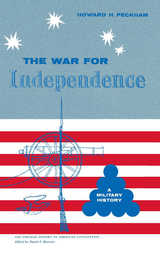 War for Independence: A Military History
Howard H. Peckham
University of Chicago Press, 1958 The American victory in the Revolutionary War came as a surprise to people all over the world. Believing that successful wars were fought by professionals and aristocrats, they could not understand how ragged and hungry troops of ill-assorted civilians were able to defeat one of the world's strongest professional armies.
This book is an effort to explain how and why that upset was accomplished. Alternating with scene and summary, the narrative has pace and proportion. Battles fall into campaigns, and campaigns interpret strategy. Commanders are deftly characterized, and flashes of insight illuminate victories and defeats. There emerges a picture of American soldiers as tougher and more deeply motivated fighters than the uncommitted British and German professionals. The book also demonstrates how highly prized were the rights that the revolutionists sought to confirm or establish, and serves as a reminder today that some ideas are worth risking life for.
"What is most amazing about this excellent history is Prof. Peckham's ability to retell these . . . legendary events . . . in a way which enriches and absorbs the reader."—Robert Kirsch, Los Angeles Times
 The War for Muslim Minds: Islam and the West
Gilles Kepel
Harvard University Press, 2006 The events of September 11, 2001, forever changed the world as we knew it. In their wake, the quest for international order has prompted a reshuffling of global aims and priorities. In a fresh approach, Gilles Kepel focuses on the Middle East as a nexus of international disorder and decodes the complex language of war, propaganda, and terrorism that holds the region in its thrall.
The breakdown of the Israeli-Palestinian peace process in 2000 was the first turn in a downward spiral of violence and retribution. Meanwhile, a neo-conservative revolution in Washington unsettled U.S. Mideast policy, which traditionally rested on the twin pillars of Israeli security and access to Gulf oil. In Saudi Arabia and Afghanistan, a transformation of the radical Islamist doctrine of Bin Laden and Zawahiri relocated the arena of terrorist action from Muslim lands to the West; Islamist radicals proclaimed jihad against their enemies worldwide.
Kepel examines the impact of global terrorism and the ensuing military operations to stem its tide. He questions the United States' ability to address the Middle East challenge with Cold War rhetoric, while revealing the fault lines in terrorist ideology and tactics. Finally, he proposes the way out of the Middle East quagmire that triangulates the interests of Islamists, the West, and the Arab and Muslim ruling elites. Kepel delineates the conditions for the acceptance of Israel, for the democratization of Islamist and Arab societies, and for winning the minds and hearts of Muslims in the West.
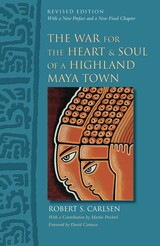 The War for the Heart and Soul of a Highland Maya Town: Revised Edition
By Robert S. Carlsen, with a contribution by Martín Prechtel
University of Texas Press, 2011 This compelling ethnography explores the issue of cultural continuity and change as it has unfolded in the representative Guatemala Mayan town Santiago Atitlán. Drawing on multiple sources, Robert S. Carlsen argues that local Mayan culture survived the Spanish Conquest remarkably intact and continued to play a defining role for much of the following five centuries. He also shows how the twentieth-century consolidation of the Guatemalan state steadily eroded the capacity of the local Mayas to adapt to change and ultimately caused some factions to reject—even demonize—their own history and culture. At the same time, he explains how, after a decade of military occupation known as la violencia, Santiago Atitlán stood up in unity to the Guatemalan Army in 1990 and forced it to leave town. This new edition looks at how Santiago Atitlán has fared since the expulsion of the army. Carlsen explains that, initially, there was hope that the renewed unity that had served the town so well would continue. He argues that such hopes have been undermined by multiple sources, often with bizarre outcomes. Among the factors he examines are the impact of transnational crime, particularly gangs with ties to Los Angeles; the rise of vigilantism and its relation to renewed religious factionalism; the related brutal murders of followers of the traditional Mayan religion; and the apocalyptic fervor underlying these events.
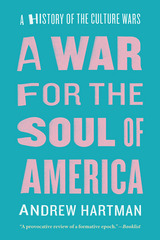 A War for the Soul of America: A History of the Culture Wars
Andrew Hartman
University of Chicago Press, 2015 When Patrick Buchanan took the stage at the Republican National Convention in 1992 and proclaimed, “There is a religious war going on for the soul of our country,” his audience knew what he was talking about: the culture wars, which had raged throughout the previous decade and would continue until the century’s end, pitting conservative and religious Americans against their liberal, secular fellow citizens. It was an era marked by polarization and posturing fueled by deep-rooted anger and insecurity.
Buchanan’s fiery speech marked a high point in the culture wars, but as Andrew Hartman shows in this richly analytical history, their roots lay farther back, in the tumult of the 1960s—and their significance is much greater than generally assumed. Far more than a mere sideshow or shouting match, the culture wars, Hartman argues, were the very public face of America’s struggle over the unprecedented social changes of the period, as the cluster of social norms that had long governed American life began to give way to a new openness to different ideas, identities, and articulations of what it meant to be an American. The hot-button issues like abortion, affirmative action, art, censorship, feminism, and homosexuality that dominated politics in the period were symptoms of the larger struggle, as conservative Americans slowly began to acknowledge—if initially through rejection—many fundamental transformations of American life.
As an ever-more partisan but also an ever-more diverse and accepting America continues to find its way in a changing world, A War for the Soul of America reminds us of how we got here, and what all the shouting has really been about.
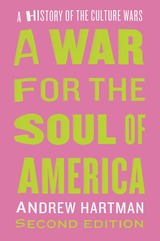 A War for the Soul of America, Second Edition: A History of the Culture Wars
Andrew Hartman
University of Chicago Press, 2019 When it was published in 2015, Andrew Hartman’s history of the culture wars was widely praised for its compelling and even-handed account of the way they developed and came to define American politics as the twentieth century drew to its close. Receiving nearly as much attention, however, was Hartman’s declaration that the culture wars were over—and the left had won. In the wake of Trump’s rise, which was driven in large part by aggressive fanning of those culture war flames, Hartman has brought A War for the Soul of America fully up to date, detailing the ways in which Trump’s success, while undeniable, represents the last gasp of culture war politics—and how the reaction he has elicited can show us early signs of the very different politics to come.
“As a guide to the late twentieth-century culture wars, Hartman is unrivalled. . . . Incisive portraits of individual players in the culture wars dramas. . . . Reading Hartman sometimes feels like debriefing with friends after a raucous night out, an experience punctuated by laughter, head-scratching, and moments of regret for the excesses involved.”—New Republic
 The War Game: A Critique of Military Problem Solving
Garry Brewer and Martin Shubik
Harvard University Press, 1979 This book is a fascinating examination of a subject that has enormous consequences but few initiates--the system of military combat simulations and their advocates in defense establishments. The scope and importance of this field may be hinted at each spring during budget debates, but until now no one has made a full public inquiry into the military studies, the analysis system, and the people behind these obscure enterprises.
How did war games come into vogue? Who designs the models that test and measure weapons capabilities--tests whose outcomes their supporters want to use to determine the allocation of millions of dollars, not to mention the deployment of U.S. armaments, around the globe? How are the potential uses of weapons studied when empirical testing is prohibitive or impossible? And what is the state of the war-gaming art and profession?
These are but a few of the crucial questions addressed and answered in this work. The authors interviewed and observed war-gaming professionals in depth, exploring the extent and status of gaming in the defense community and examining these in terms of purpose, means of production, operations, uses, benefits, and costs. Consequently, their book is not simply an analysis but a portrait of the profession. As such, it will serve not only as a blueprint for necessary improvements in the military area but also as the catalyst for future work in diverse areas, since the problems of largescale models examined in a war-game context are now being experienced in such newer fields as energy policy and urban planning.
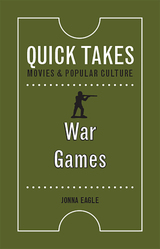 War Games
Jonna Eagle
Rutgers University Press, 2020 The word “wargames” might seem like a contradiction in terms. After all, the declaration “This is war” is meant to signal that things have turned deadly serious, that there is no more playing around. Yet the practices of war are intimately entangled with practices of gaming, from military videogames to live battle reenactments. How do these forms of play impact how both soldiers and civilians perceive acts of war?
This Quick Take considers how various war games and simulations shape the ways we imagine war. Paradoxically, these games grant us a sense of mastery and control as we strategize and scrutinize the enemy, yet also allow us the thrilling sense of being immersed in the carnage and chaos of battle. But as simulations of war become more integrated into both popular culture and military practice, how do they shape our apprehension of the traumatic realities of warfare?
Covering everything from chess to football, from Saving Private Ryan to American Sniper, and from Call of Duty to drone interfaces, War Games is an essential guide for anyone seeking to understand the militarization of American culture, offering a compact yet comprehensive look at how we play with images of war.
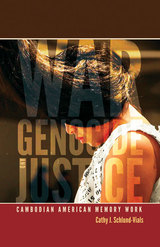 War, Genocide, and Justice: Cambodian American Memory Work
Cathy J. Schlund-Vials
University of Minnesota Press, 2012 In the three years, eight months, and twenty days of the Khmer Rouge’s deadly reign over Cambodia, an estimated 1.7 million Cambodians perished as a result of forced labor, execution, starvation, and disease. Despite the passage of more than thirty years, two regime shifts, and a contested U.N. intervention, only one former Khmer Rouge official has been successfully tried and sentenced for crimes against humanity in an international court of law to date. It is against this background of war, genocide, and denied justice that Cathy J. Schlund-Vials explores the work of 1.5-generation Cambodian American artists and writers. Drawing on what James Young labels “memory work”—the collected articulation of large-scale human loss—War, Genocide, and Justice investigates the remembrance work of Cambodian American cultural producers through film, memoir, and music. Schlund-Vials includes interviews with artists such as Anida Yoeu Ali, praCh Ly, Sambath Hy, and Socheata Poeuv. Alongside the enduring legacy of the Killing Fields and post-9/11 deportations of Cambodian American youth, artists potently reimagine alternative sites for memorialization, reclamation, and justice. Traversing borders, these artists generate forms of genocidal remembrance that combat amnesic politics and revise citizenship practices in the United States and Cambodia. Engaged in politicized acts of resistance, individually produced and communally consumed, Cambodian American memory work represents a significant and previously unexamined site of Asian American critique.
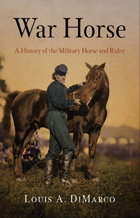 War Horse: A History of the Military Horse and Rider
Louis A. DiMarco
Westholme Publishing, 2008 The Role of Horses in Battle From Ancient Egypt to Modern Afghanistan
For more than four thousand years, the horse and rider have been an integral part of warfare. Armed with weapons and accessories ranging from a simple javelin to the hand-held laser designator, the horse and rider have fought from the steppes of central Asia to the plains of North America. Understanding the employment of the military horse is key to understanding the successes and the limitations of military operations and campaigns throughout history. Over the centuries, horses have been used to pull chariots, support armor-laden knights, move scouts rapidly over harsh terrain, and carry waves of tightly formed cavalry. In War Horse: A History of the Military Horse and Rider, Louis A. DiMarco discusses all of the uses of horses in battle, including the Greek, Persian, and Roman cavalry, the medieval knight and his mount, the horse warriors—Huns, Mongols, Arabs, and Cossacks—the mounted formations of Frederick the Great and Napoleon, and mounted unconventional fighters, such as American Indians, the Boers, and partisans during World War II. The book also covers the weapons and forces which were developed to oppose horsemen, including longbowmen, pike armies, cannon, muskets, and machine guns. The development of organizations and tactics are addressed beginning with those of the chariot armies and traced through the evolution of cavalry formations from Alexander the Great to the Red Army of World War II. In addition, the author examines the training and equipping of the rider and details the types of horses used as military mounts at different points in history, the breeding systems that produced those horses, and the techniques used to train and control them. Finally, the book reviews the importance of the horse and rider to battle and military operations throughout history, and concludes with a survey of the current military use of horses. War Horse is a comprehensive look at this oldest and most important aspect of military history, the relationship between human and animal, a weapons system that has been central to warfare longer than any other.
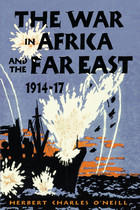 The War in Africa and the Far East, 1914-17
Herbert Charles O'Neill
Westholme Publishing, 2012 The Fight for Germany's African and Asian Colonies During World War I
"This account will be welcome to a large circle of readers. . . . The arduous nature of these campaigns deserves to be far more widely known, and this is just the book for the purpose--short, clear, and easy to read."--Journal of the African Society
The largest battles of World War I were fought in Europe, and it is there where most critical studies focus. The fate of the far-flung colonies of Germany, however, are what gave the war its global scope, with campaigns reaching from China to New Guinea and East to West Africa. While there are detailed accounts of most of these campaigns, The War in Africa and the Far East, 1914-17 is unique in providing a concise history of the entire series of military events in Africa and Asia, giving the reader a better idea of the relationship and chronology of these wide-ranging events. While Germany was stripped of all its overseas colonies, the change in power had unintended consequences, most importantly the rise of Japan in the Pacific, where former German colonies now stood at the territorial boundary between Japan and the United States.
Waged by Allied troops from Britain, Kenya, Zambia, Portugal, Japan, India, Netherlands, and other countries and led by such personalities as General Jan Christian Smuts, the theater of operations crossed modern-day Tanzania, Rwanda, Burundi, Togo, Cameroon, Namibia, New Guinea, Qingdau, the Bismarck Archipelago, and other Pacific Island chains. Originally published in 1918 using official dispatches and other sources, and presented here for the first time in paperback, completely retypeset and with the original maps and additional photographs, The War in Africa and the Far East is a compact overview of an important aspect of the First World War.
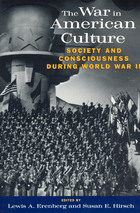 The War in American Culture: Society and Consciousness during World War II
Edited by Lewis A. Erenberg and Susan E. Hirsch
University of Chicago Press, 1996 The War in American Culture explores the role of World War II in the transformation of American social, cultural, and political life.
World War II posed a crisis for American culture: to defeat the enemy, Americans had to unite across the class, racial and ethnic boundaries that had long divided them. Exploring government censorship of war photography, the revision of immigration laws, Hollywood moviemaking, swing music, and popular magazines, these essays reveal the creation of a new national identity that was pluralistic, but also controlled and sanitized. Concentrating on the home front and the impact of the war on the lives of ordinary Americans, the contributors give us a rich portrayal of family life, sexuality, cultural images, and working-class life in addition to detailed consideration of African Americans, Latinos, and women who lived through the unsettling and rapidly altered circumstances of wartime America.
 War in Darfur and the Search for Peace
Alex de Waal
Harvard University Press, 2007 Since it sprang from obscurity to international headlines in 2004, the name “Darfur” has become synonymous with war, massacre, and humanitarian crisis. The crisis had, however, been brewing for far longer, its causes neglected by both scholars and Sudanese leaders.
War in Darfur and the Search for Peace is a series of essays by leading Sudanese and international specialists on Darfur, combining original research and analysis. The book provides in-depth analysis of the origins and dimensions of the conflict, including detailed accounts of the evolution of ethnic and religious identities, the breakdown of local administration, the emergence of Arab militia and resistance movements, and regional dimensions to the conflict.
The study also focuses on the search for peace, with contributions by those most closely engaged in local and international efforts to resolve the conflict. This includes documentation and analysis of the warring parties’ ideologies and agendas and how they have changed in the course of the conflict, and examination of the efforts made by Sudanese civil and political leaders, the African Union, and other international actors to bring the war to an end.
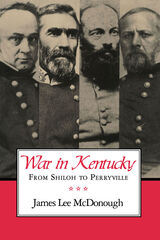 War in Kentucky: From Shiloh to Perryville
James Lee Mcdonough
University of Tennessee Press, 1996 A compelling new volume from the author of Shiloh—In Hell before Night and Chattanooga—A Death Grip on the Confederacy, this book explores the strategic importance of Kentucky for both sides in the Civil War and recounts the Confederacy's bold attempt to capture the Bluegrass State. In a narrative rich with quotations from the diaries, letters, and reminiscences of participants, James Lee McDonough brings to vigorous life an episode whose full significance has previously eluded students of the war.
In February of 1862, the fall of Fort Henry and Fort Donelson near the Tennessee-Kentucky border forced a Confederate retreat into northern Alabama. After the Southern forces failed that spring at Shiloh to throw back the Federal advance, the controversial General Braxton Bragg, newly promoted by Jefferson Davis, launched a countermovement that would sweep eastward to Chattanooga and then northwest through Middle Tennessee. Capturing Kentucky became the ultimate goal, which, if achieved, would lend the war a different complexion indeed.
Giving equal attention to the strategies of both sides, McDonough describes the ill-fated Union effort to capture Chattanooga with an advance through Alabama, the Confederate march across Tennessee, and the subsequent two-pronged invasion of Kentucky. He vividly recounts the fighting at Richmond, Munfordville, and Perryville, where the Confederate dream of controlling Kentucky finally ended.
The first book-length study of this key campaign in the Western Theater, War in Kentucky not only demonstrates the extent of its importance but supports the case that 1862 should be considered the decisive year of the war.
The author: James Lee McDonough, a native of Tennessee, is professor of history at Auburn University. Among his other books are Stones River—Bloody Winter in Tennessee and Five Tragic Hours: The Battle of Franklin, which he co-wrote with Thomas L. Connelly.
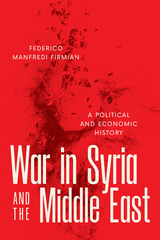 War in Syria and the Middle East: A Political and Economic History
Federico Manfredi Firmian
University of Texas Press, 2025 A wide-ranging examination of the causes of war in Syria and the Middle East. In War in Syria and the Middle East, Federico Manfredi Firmian uses historical, political, and economic lenses to examine how Syria’s civil war is part of a broad pattern of social breakdown increasingly prevalent across the Arab and Islamic worlds. This expansive book argues that many conflicts across the Middle East today are rooted in fundamental ideological divides that originated with European imperialism. In Syria, the iniquities of French rule gave way to the radicalism of the Arab Socialist Baʿth Party, which promised to dismantle imperial legacies and capitalist logics through nationalizations, land redistribution, and central planning. Baʿthist Syria, however, ultimately failed to provide a viable alternative to capitalism. In fact, its failures, and the failures of other revolutionary regimes of socialist inspiration, provided an opening for armed Islamist movements to challenge both secular authoritarian rule and US foreign policies—ultimately leading to civil war. Combining a multidisciplinary approach with fieldwork, War in Syria and the Middle East argues for a global perspective on a pressing, ongoing conflict.
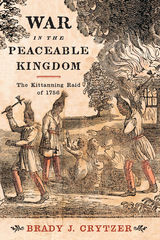 War in the Peaceable Kingdom: The Kittanning Raid of 1756
Brady J. Crytzer
Westholme Publishing, 2016 The First Military Action Authorized by Pennsylvania and How it Changed the Future of the American Colonies
On the morning of September 8, 1756, a band of about three hundred volunteers of a newly created Pennsylvania militia led by Lt. Col. John Armstrong crept slowly through the western Pennsylvania brush. The night before they had reviewed a plan to quietly surround and attack the Lenape, or Delaware, Indian village of Kittanning. The Pennsylvanians had learned that several prominent Delaware who had led recent attacks on frontier settlements as well as a number of white prisoners were at the village. Seeking reprisal, Armstrong’s force successfully assaulted Kittanning, killing one of the Delaware they sought, but causing most to flee—along with their prisoners. Armstrong then ordered the village burned. The raid did not achieve all of its goals, but it did lead to the Indians relocating their villages further away from the frontier settlements. However, it was a major victory for those Pennsylvanians—including some Quaker legislators—who believed the colony must be able to defend itself from outside attack, whether from the French, Indians, or another colony.
In War in the Peaceable Kingdom: The Kittanning Raid of 1756, historian Brady J. Crytzer follows the two major threads that intertwined at Kittanning: the French and Indian War that began in the Pennsylvania frontier, and the bitter struggle between pacifist Quakers and those Quakers and others—most notably, Benjamin Franklin—who supported the need to take up arms. It was a transformational moment for the American colonies. Rather than having a large, pacifist Pennsylvania in the heart of British North America, the colony now joined the others in training soldiers for defense. Ironically, it would be Pennsylvania soldiers who, in the early days of the American Revolution, would be crucial to the survival of George Washington’s army.
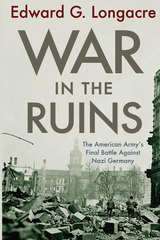 War in the Ruins: The American Army's Final Battle Against Nazi Germany
Edward G. Longacre
Westholme Publishing, 2010 The Last Major Combat for American Troops in Germany During the Final Days of World War II
By April 1945, the last German counteroffensive in the west had been defeated, the vaunted Siegfried Line was no more, the Rhine River had been crossed, and major German cities were being bombed relentlessly. The war in Europe appeared to be in its final stages. As American and British armies overran central Germany, the Russians were smashing their way from the east toward Berlin. Optimism reigned up and down the Allied lines. But as the American Army’s 100th Infantry Division pushed along the west bank of the Neckar River across from bomb-shattered Heilbronn, resistance unexpectedly stiffened. In that 700-year-old city, a major industrial and communications center still operating for the benefit of the Nazi war machine, Hitler’s subordinates had battened down for a last-ditch stand. For sheer ferocity, it would exceed anything the now-battle-hardened Americans had experienced. Here, American troops faced a grueling campaign of house-to-house fighting, with Hitler Youth, Volkssturm militia, and an SS division attempting to stop the American advance at this critical sector of the European theater. Having been repeatedly targeted by Alllied aircraft, the city resembled a vast, Hellish ruin, and as American soldiers inched their way forward, they encountered booby traps, withering sniper fire, deadly Panzerfaust rounds, and a fanatical enemy. The nine-day battle for Heilbronn would be the last major combat for American troops in Europe. Within three weeks of their securing the city, Hitler would be dead and Germany defeated. In War in the Ruins: The American Army’s Final Battle Against Nazi Germany, Edward G. Longacre recounts this neglected but essential chapter in the history of World War II, describing the 100th Division’s swift but grueling advance through the Vosges Mountains, their Rhine River crossing, the assault on the historic Maginot Line, and the ominous approach to Heilbronn. The author then describes the entire bitter battle and its aftermath, using private letters, journals, German and American action reports, and other primary source material, to establish War in the Ruins as an essential volume in the history of World War II in Europe.
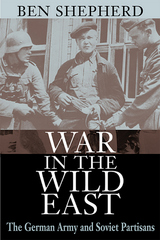 War in the Wild East: The German Army and Soviet Partisans
Ben Shepherd
Harvard University Press, 2004 In Nazi eyes, the Soviet Union was the “wild east,” a savage region ripe for exploitation, its subhuman inhabitants destined for extermination or helotry. An especially brutal dimension of the German army’s eastern war was its anti-partisan campaign. This conflict brought death and destruction to thousands of Soviet civilians, and has been held as a prime example of ordinary German soldiers participating in the Nazi regime’s annihilation policies.
Ben Shepherd enters the heated debate over the wartime behavior of the Wehrmacht in a detailed study of the motivation and conduct of its anti-partisan campaign in the Soviet Union. He investigates how anti-partisan warfare was conducted, not by the generals, but by the far more numerous, average Germans serving as officers in the field. What shaped their behavior was more complex than Nazi ideology alone. The influence of German society, as well as of party and army, together with officers’ grueling yet diverse experience of their environment and enemy, made them perceive the anti-partisan war in varied ways. Reactions ranged from extreme brutality to relative restraint; some sought less to terrorize the native population than to try to win it over. The emerging picture does not dilute the suffering the Wehrmacht’s eastern war inflicted. It shows, however, that properly judging ordinary Germans’ role in that war is more complicated than is indicated by either wholesale condemnation or wholesale exoneration.
This valuable study offers a nuanced discussion of the diversity of behaviors within the German army, as well as providing a compelling exploration of the war and counterinsurgency operations on the eastern front.
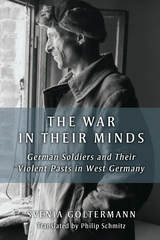 The War in Their Minds: German Soldiers and Their Violent Pasts in West Germany
Svenja Goltermann
University of Michigan Press, 2017 Historians are increasingly looking at the sacrifices Germans had to make during World War II. In this context, Svenja Goltermann has taken up a particularly delicate topic, German soldiers’ experience of violence during the war, and repercussions of this experience after their return home. Part I of her book explores the ways in which veterans’ experiences of wartime violence reshaped everyday family life, involving family members in complex ways. Part II offers an extensive analysis of the psychiatric response to this new category of patient, and in particular the reluctance of psychiatrists to recognize the psychic afflictions of former POWs as constituting the grounds for long-term disability. Part III analyzes the cultural representations of veterans’ psychic suffering, encompassing the daily press, popular films, novels, and theater.
Originally published in German as Die Gesellschaft der Uberlebenden, The War in Their Minds examines hitherto unused source material—psychiatric medical files of soldiers—to make clear how difficult it was for the soldiers and their families to readjust to normal, everyday life. Goltermann allows these testimonies of violence, guilt, justification, and helplessness speak for themselves and sensitively explores how the pension claims of returning soldiers were to compete with the claims of the Holocaust victims to compensation.
 The War in Ukraine’s Donbas: Origins, Contexts, and the Future
David R. Marples
Central European University Press, 2022 This collective work analyzes the ongoing conflict in Ukraine, providing a coherent picture of Ukraine and Eastern Europe in the period 2013–2020. Giving voice to different social groups, scholarly communities and agencies relevant to Ukraine’s recent history, The War in Ukraine's Donbas goes beyond simplistic media interpretations that limit the analysis to Vladimir Putin and Russian aims to annex Ukraine. Instead, the authors identify the deeper roots linked to the autonomy and history of Donbas as a region. The contributions explore local society and traditions and the alienation from Ukraine caused by the events of Euromaidan, which saw the removal of the Donetsk-based president Viktor Yanukovych. Other chapters address the refugee crisis, the Minsk Accords in 2014 and the impact of the new president Volodymyr Zelensky and his efforts to bring the war to an end by negotiations among Russia, Ukraine, France, and Germany. The book concludes with four proposals for a durable peace in Donbas: territorial power-sharing; the conversion of rebels into legitimate political parties; amnesty for all participants of the armed conflict; and a transitional period of several years until political institutions are fully re-established.
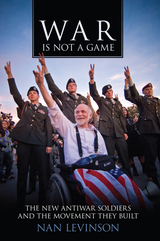 War Is Not a Game: The New Antiwar Soldiers and the Movement They Built
Levinson, Nan
Rutgers University Press, 2016 On July 23, 2004, five marines, two soldiers, and one airman became the most unlikely of antiwar activists. Young and gung-ho when they first signed up to defend their country, they were sent to fight a war that left them confused, enraged, and haunted. Once they returned home, they became determined to put their disillusionment to use. So that sultry summer evening, they mounted the stage of Boston’s historic Faneuil Hall and announced the launch of Iraq Veterans Against the War. War Is Not a Game tells the story of this new soldiers’ antiwar movement, showing why it was born, how it quickly grew, where it has struggled, what it accomplished, and how it continues to resonate in the national conversation about our military and our wars. Nan Levinson reveals the individuals behind the movement, painting an unforgettable portrait of these working-class veterans who refused to be seen as simply tragic victims or battlefront heroes and instead banded together to become leaders of a national organization. Written with sensitivity and humor, War Is Not a Game gives readers an uncensored, grunt’s-eye view of the occupations in Iraq and Afghanistan, while conveying the equally dramatic struggles that soldiers face upon returning home. Demanding to be seen neither simply as tragic victims nor as battlefront heroes, the Iraq Veterans Against the War have worked to shape the national conversation. This book celebrates their bravery, showing that sometimes the most vital battles take place on the home front.
War, Judgment, and Memory in the Basque Borderlands, 1914-1945
Sandra Ott
University of Nevada Press, 2008 During the first half of the twentieth century, the French Basque province of Xiberoa was a place of refuge, conflict, transit, exile and foreign occupation. At the Liberation of France in 1944, many Xiberoans confronted ongoing local divisiveness, rooted in the interwar years, and faced new conflicts arising from legal and civic judgments made during Vichy and German occupation. This book traces the roots of their divided memories to local and official interpretations of what constituted legitimate judgment, legitimate behavior and justice during those troubled times. In order to capture a sense of the diverse ways in which Xiberoan Basques responded to the Germans in their midst, the author explores and contrasts the experiences of people in four different communities located within a fifteen mile radius.
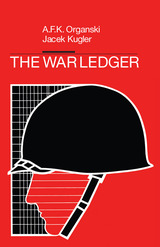 The War Ledger
A. F. K. Organski and Jacek Kugler
University of Chicago Press, 1980 The War Ledger provides fresh, sophisticated answers to fundamental questions about major modern wars: Why do major wars begin? What accounts for victory or defeat in war? How do victory and defeat influence the recovery of the combatants? Are the rules governing conflict behavior between nations the same since the advent of the nuclear era?
The authors find such well-known theories as the balance of power and collective security systems inadequate to explain how conflict erupts in the international system. Their rigorous empirical analysis proves that the power-transition theory, hinging on economic, social, and political growth, is more accurate; it is the differential rate of growth of the two most powerful nations in the system—the dominant nation and the challenger—that destabilizes all members and precipitates world wars.
Predictions of who will win or lose a war, the authors find, depend not only on the power potential of a nation but on the capability of its political systems to mobilize its resources—the "political capacity indicator." After examining the aftermath of major conflicts, the authors identify national growth as the determining factor in a nation's recovery. With victory, national capabilities may increase or decrease; with defeat, losses can be enormous. Unexpectedly, however, in less than two decades, losers make up for their losses and all combatants find themselves where they would have been had no war occurred.
Finally, the authors address the question of nuclear arsenals. They find that these arsenals do not make the difference that is usually assumed. Nuclear weapons have not changed the structure of power on which international politics rests. Nor does the behavior of participants in nuclear confrontation meet the expectations set out in deterrence theory.
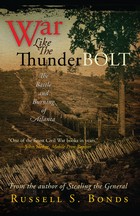 War Like the Thunderbolt: The Battle and Burning of Atlanta
Russell S. Bonds
Westholme Publishing, 2009 A masterpiece of prose and research, the definitive history of the struggle for Atlanta during the Civil War, an episode immortalized by the novel Gone with the Wind
Called “the greatest event of the Civil War” by New York diarist George Templeton Strong, the epic struggle for the city of Atlanta in the bloody summer of 1864 was a pivotal moment in American history. Union commander William Tecumseh Sherman’s relentless fight for the city secured the reelection of Abraham Lincoln, sealed the fate of the Southern Confederacy, and set a precedent for military campaigns that endures today. Its depiction in the novel and motion picture Gone with the Wind established the fight for Atlanta as an iconic episode in our nation’s most terrible war. In War Like the Thunderbolt: The Battle and Burning of Atlanta, award-winning author Russell S. Bonds takes the reader behind the lines and across the smoky battlefields of Peachtree Creek, Atlanta, Ezra Church, and Jonesboro, and into the lives of fascinating characters, both the famous and the forgotten, including the fiery and brilliant Sherman; General John Bell Hood, the Confederacy’s last hope to defend Atlanta; Benjamin Harrison, the diminutive young Indiana colonel who would rise to become President of the United States; Patrick Cleburne, the Irishmanturned- Southern officer; and ten-year-old diarist Carrie Berry, who bravely withstood and bore witness to the fall of the city. Here also is the dramatic story of the ordeal of Atlanta itself—the five-week artillery bombardment, the expulsion of its civilian population, and the infamous fire that followed. Based on new research in diaries, newspapers, previously unpublished letters, and other archival sources, War Like the Thunderbolt is a combination of captivating narrative and insightful military analysis—a stirring account of the battle and burning of the “Gate City of the South.”
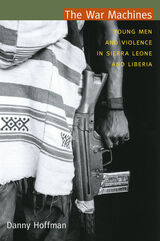 The War Machines: Young Men and Violence in Sierra Leone and Liberia
Danny Hoffman
Duke University Press, 2011 In The War Machines, Danny Hoffman considers how young men are made available for violent labor both on the battlefields and in the diamond mines, rubber plantations, and other unregulated industries of West Africa. Based on his ethnographic research with militia groups in Sierra Leone and Liberia during those countries’ recent civil wars, Hoffman traces the path of young fighters who moved from grassroots community-defense organizations in Sierra Leone during the mid-1990s into a large pool of mercenary labor. Hoffman argues that in contemporary West Africa, space, sociality, and life itself are organized around making young men available for all manner of dangerous work. Drawing on his ethnographic research over the past nine years, as well as the anthropology of violence, interdisciplinary security studies, and contemporary critical theory, he maintains that the mobilization of West African men exemplifies a global trend in the outsourcing of warfare and security operations. A similar dynamic underlies the political economy of violence in Iraq, Afghanistan, and a growing number of postcolonial spaces. An experienced photojournalist, Hoffman integrates more than fifty of his photographs of young West Africans into The War Machines.
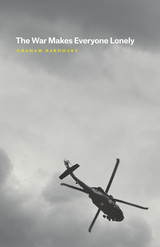 The War Makes Everyone Lonely
Graham Barnhart
University of Chicago Press, 2019 In his first collection of poems, many of which were written during his years as a US Army Special Forces medic, Graham Barnhart explores themes of memory, trauma, and isolation. Ranging from conventional lyrics and narrative verse to prose poems and expressionist forms, the poems here display a strange, quiet power as Barnhart engages in the pursuit and recognition of wonder, even while concerned with whether it is right to do so in the fraught space of the war zone. We follow the speaker as he treads the line between duty and the horrors of war, honor and compassion for the victims of violence, and the struggle to return to the daily life of family and society after years of trauma.
Evoking the landscapes and surroundings of war, as well as its effects on both US military service members and civilians in war-stricken countries, The War Makes Everyone Lonely is a challenging, nuanced look at the ways American violence is exported, enacted, and obscured by a writer poised to take his place in the long tradition of warrior-poets.
 War Memory and Social Politics in Japan, 1945–2005
Franziska Seraphim
Harvard University Press, 2006 Japan has long wrestled with the memories and legacies of World War II. In the aftermath of defeat, war memory developed as an integral part of particular and divergent approaches to postwar democracy. In the last six decades, the demands placed upon postwar democracy have shifted considerably—from social protest through high economic growth to Japan’s relations in Asia—and the meanings of the war shifted with them.
This book unravels the political dynamics that governed the place of war memory in public life. Far from reconciling with the victims of Japanese imperialism, successive conservative administrations have left the memory of the war to representatives of special interests and citizen movements, all of whom used war memory to further their own interests.
Franziska Seraphim traces the activism of five prominent civic organizations to examine the ways in which diverse organized memories have secured legitimate niches within the public sphere. The history of these domestic conflicts—over the commemoration of the war dead, the manipulation of national symbols, the teaching of history, or the articulation of relations with China and Korea—is crucial to the current discourse about apology and reconciliation in East Asia, and provides essential context for the global debate on war memory.
War Music: An Account of Books 1-4 and 16-19 of Homer's Iliad
Christopher Logue
University of Chicago Press, 2003 In his brilliant rendering of eight books of Homer's Iliad, Logue here retells some of the most evocative episodes of the war classic, including the death of Patroclus and Achilles's fateful return to battle, that sealed the doom of Troy. Compulsively readable, Logue's poetry flies off the page, and his compelling descriptions of the horrors of war have a surreal, dreamlike quality that has been compared to the films of Kurosawa. Retaining the great poem's story line but rewriting every incident, Logue brings the Trojan War to life for modern audiences.
 War No More: Eliminating Conflict in the Nuclear Age
Robert Hinde and Joseph Rotblat
Pluto Press, 2003 At a time when terrorism is opening the way for new forms of warfare worldwide, this book provides a much-needed account of the real dangers we face, and argues that the elimination of weapons of mass destruction and of war are attainable and necessary goals.
Written by Nobel Peace prize winner and former nuclear physicist Joseph Rotblat, who was involved in the creation of the first atom bomb, and biologist/ psychologist Robert Hinde, War No More provides expert insight into the nature of modern warfare - including weapons of mass destruction. Examining the key factors that contribute to conflict, the authors explain how best to approach a peaceful future.
If war is ever to be eliminated, we must address key issues such as the gap between rich and poor; have fully effective arms controls, and above all we must have better education. The authors emphasise the United Nations - as well as NGOs, religious groups, and grassroots movements - also have important parts to play.
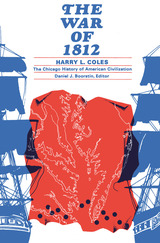 The War of 1812
Harry L. Coles
University of Chicago Press, 1966 This compact history of the war attempts to separate myth from reality. Professor Coles narrates the main operations on both land and sea of the three-year struggle. He examines the conflict from the British (and Canadian) as well as the American point of view, relating events in America to the larger war going on in Europe.
"A balanced analysis of tactics and strategy, this book also summarizes succinctly and clearly recent scholarship on causes and describes briefly the war's military, economic, and political consequences. Coles has surveyed thoroughly the existing literature but arrives at a number of independent judgments. It is the best single-volume account of the war in all its aspects. In recounting sea battles, Coles puts aside the patriotic blinders that have for so long prevented a sensible understanding of American capabilities and strategic necessities; thus American naval victories are put in a proper perspective. And in dealing with land engagements, he has shunned the mocking and amused attitude which has so often passed for historical judgment. Undergraduates will be stimulated by the hints of modern parallels and will find useful the excellent annotated bibliography and simple maps."—Choice
 The War of 1812
Harry L. Coles
University of Chicago Press, 1966 This is an auto-narrated audiobook version of this book.
This compact history of the war attempts to separate myth from reality. Professor Coles narrates the main operations on both land and sea of the three-year struggle. He examines the conflict from the British (and Canadian) as well as the American point of view, relating events in America to the larger war going on in Europe.
"A balanced analysis of tactics and strategy, this book also summarizes succinctly and clearly recent scholarship on causes and describes briefly the war's military, economic, and political consequences. Coles has surveyed thoroughly the existing literature but arrives at a number of independent judgments. It is the best single-volume account of the war in all its aspects. In recounting sea battles, Coles puts aside the patriotic blinders that have for so long prevented a sensible understanding of American capabilities and strategic necessities; thus American naval victories are put in a proper perspective. And in dealing with land engagements, he has shunned the mocking and amused attitude which has so often passed for historical judgment. Undergraduates will be stimulated by the hints of modern parallels and will find useful the excellent annotated bibliography and simple maps."—Choice
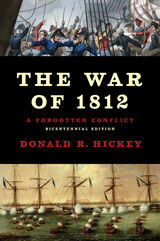 The War of 1812: A Forgotten Conflict, Bicentennial Edition
Donald R. Hickey
University of Illinois Press, 2012 This comprehensive and authoritative history of the War of 1812, thoroughly revised for the 200th anniversary of the historic conflict, is a myth-shattering study that will inform and entertain students, historians, and general readers alike. Donald R. Hickey explores the military, diplomatic, and domestic history of our second war with Great Britain, bringing the study up to date with recent scholarship on all aspects of the war, from the Gulf of Mexico to Canada. The newly expanded The War of 1812: A Forgotten Conflict, Bicentennial Edition includes additional information on the British forces, American Indians, and military operations such as the importance of logistics and the use and capabilities of weaponry. Hickey explains how the war promoted American nationalism and manifest destiny, stimulated peacetime defense spending, and enhanced America's reputation abroad. He also shows that the war sparked bloody conflicts between pro-war Republican and anti-war Federalist neighbors, dealt a crippling blow to American Indians, and solidified the United States's antipathy toward the British.
Book-of-the-Month Club and History Book Club selections and received one of the two 1990 "Best Book Awards" from the American Military Institute.
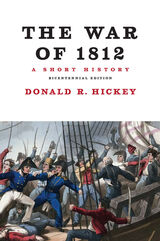 The War of 1812, A Short History
Donald R. Hickey
University of Illinois Press, 2012 This abridged edition of Donald R. Hickey's comprehensive and authoritative The War of 1812: A Forgotten Conflict has been thoroughly revised for the 200th anniversary of the historic conflict. A myth-shattering study that will inform and entertain students and general readers alike, The War of 1812: A Short History explores the military, diplomatic, and domestic history of our second war with Great Britain, bringing the study up to date with recent scholarship on all aspects of the war, from the Gulf of Mexico to Canada. With new information on military operations, logistics, and the use and capabilities of weaponry, The War of 1812: A Short History explains how the war promoted American nationalism, reinforced the notion of manifest destiny, stimulated peacetime defense spending, and enhanced America's reputation abroad. Hickey also concludes that the war sparked bloody conflicts between pro-war Republican and anti-war Federalist neighbors, dealt a crippling blow to the independence and treaty rights of American Indians, and solidified the United States' antipathy toward the British. Ideal for students and history buffs, this special edition includes selected illustrations, maps, a chronology of major events during the war, and a list of suggested further reading.
The War of 1812 in the Old Northwest
Alec R. Gilpin
Michigan State University Press, 2012 This engaging narrative history deftly illustrates the War of 1812 as it played out in the Old Northwest — Ohio, Indiana, Illinois, Michigan, and bordering parts of Canada. From the stirrings of conflict in the area beginning as early as the 1760s, through the Battle of Tippecanoe, and to Michigan Territory’s role as a focal point in prewar preparation, the book examines the lead-up to the war before delving into key battles in the region. In this accessible text, Gilpin explores key figures, dates, and wartime developments, shedding considerable light on the strategic and logistical issues raised by the region’s unique geography, culture, economy, and political temperament. Battles covered include the Surrender of Detroit, the Siege of Fort Meigs, and the battles of River Raisin, Lake Erie, the Thames, and Mackinac Island.
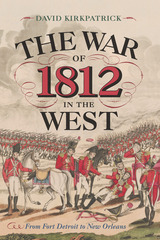 The War of 1812 in the West: From Fort Detroit to New Orleans
David Kirkpatrick
Westholme Publishing, 2019 With the State of Kentucky in the Lead, the Battle to Secure the American Frontier for Westward Expansion
The spring of 1812 found the young American republic on edge. The British Navy was impressing American seamen with impunity at an alarming rate while vicious attacks on frontier settlements by American Indians armed with British weapons had left a trail of fear and outrage. As calls for a military response increased, Kentucky, the first state west of the Appalachians, urged that only by defeating the British could the nation achieve security. The very thought conjured up embellished memories of the American Revolution, and once war was declared, many soldiers believed that the “Spirit of 76” would lead them to victory. But the conflict quickly transformed from a patriotic parade to a desperate attempt to survive against a major military power. While the War of 1812 is known mostly for later events, including the burning of Washington and the siege of Fort McHenry, much of the first two years of the war was fought in the west, with the British Army and their Indian allies nearly overrunning the Old Northwest and threatening the borders of the original colonies.
In The War of 1812 in the West: From Fort Detroit to New Orleans, David Kirkpatrick chronicles the near catastrophic loss of the Ohio, Indiana, and Illinois Territories, the bitter fight against both Tecumseh’s Confederation and the Creek Nation, and the slow recovery and ultimate victory of American forces—a large portion of which was supplied by Kentucky—from Canada to the Gulf of Mexico. Battles such as River Raisin, Thames River, Fort Meigs, and New Orleans are placed in context to show how they secured America’s frontier and opened territory to the west to new settlement following the war.
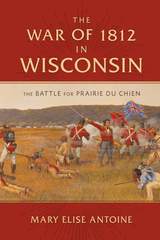 The War of 1812 in Wisconsin: The Battle for Prairie du Chien
Mary Elise Antoine
Wisconsin Historical Society Press, 2016 In The War of 1812 in Wisconsin, author Mary Elise Antoine brings a little-known corner of Wisconsin’s history to life. Prairie du Chien, located just above mouth of the Wisconsin River, was the key to trade on the upper Mississippi. Whoever controlled the prairie commanded the immense territory inhabited by thousands of American Indians—and the fur they traded. When war broke out between the United States and Great Britain in 1812, British and Americans fought to maintain the ever-shifting alliance of the tribes. This is the story of the battle for the control of Prairie du Chien and the western country, which began many years before the three-day siege in July of 1814 for which the Battle of Prairie du Chien is named. It is also the tale of the people, Euro-American and Native, who lived in pre-territorial Wisconsin and how the contest for control of the region affected their lives and livelihoods. The outcome of the War of 1812 would determine what "manifest destiny" would mean to all who called these lands home.
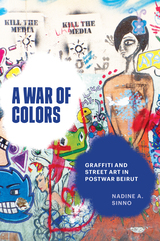 A War of Colors: Graffiti and Street Art in Postwar Beirut
Nadine A. Sinno
University of Texas Press, 2024 Demonstrates the role of Beirut’s postwar graffiti and street art in transforming the cityscape and animating resistance. Over the last two decades in Beirut, graffiti makers have engaged in a fierce “war of colors,” seeking to disrupt and transform the city’s physical and social spaces. In A War of Colors, Nadine Sinno examines how graffiti and street art have been used in postwar Beirut to comment on the rapidly changing social dynamics of the country and region. Analyzing how graffiti makers can reclaim and transform cityscapes that were damaged or monopolized by militias during the war, Sinno explores graffiti’s other roles, including forging civic engagement, commemorating cultural icons, protesting political corruption and environmental violence, and animating resistance. In addition, she argues that graffiti making can offer voices to those who are often marginalized, especially women and LGBTQ people. Copiously illustrated with images of graffiti and street art, A War of Colors is a visually captivating and thought-provoking journey through Beirut, where local and global discourses intersect on both scarred and polished walls in the city.
War Of Conquest: How it was Waged Here in Mexico
Arthur J. O. Anderson
University of Utah Press, 1978 How is it possible that in 1521 five-hundred Spanish soldiers defeated the most powerful military force in Middle America? The answer lies not in western firearms, as we have been taught, but rather in the differences between the Aztec and Spanish cultures. Differing concepts of warfare and diplomacy, reinforced by tensions and stresses within the Aztec political system and its supporting religious beliefs, allowed Cortés to systematically gain and hold the military and diplomatic advantages that gave the Spaniards the day, the war, and the continent.
 The War of My Generation: Youth Culture and the War on Terror
Kieran, David
Rutgers University Press, 2015 Following the 9/11 attacks, approximately four million Americans have turned eighteen each year and more than fifty million children have been born. These members of the millennial and post-millennial generation have come of age in a moment marked by increased anxiety about terrorism, two protracted wars, and policies that have raised questions about the United States's role abroad and at home. Young people have not been shielded from the attacks or from the wars and policy debates that followed. Instead, they have been active participants—as potential military recruits and organizers for social justice amid anti-immigration policies, as students in schools learning about the attacks or readers of young adult literature about wars.
The War of My Generation is the first essay collection to focus specifically on how the terrorist attacks and their aftermath have shaped these new generations of Americans. Drawing from a variety of disciplines, including anthropology, sociology, cultural studies, and literary studies, the essays cover a wide range of topics, from graphic war images in the classroom to computer games designed to promote military recruitment to emails from parents in the combat zone. The collection considers what cultural factors and products have shaped young people's experience of the 9/11 attacks, the wars that have followed, and their experiences as emerging citizen-subjects in that moment. Revealing how young people understand the War on Terror—and how adults understand the way young people think—The War of My Generation offers groundbreaking research on catastrophic events still fresh in our minds.
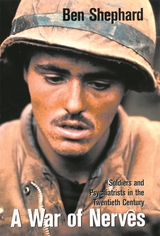 A War of Nerves: Soldiers and Psychiatrists in the Twentieth Century
Ben Shephard
Harvard University Press, 2001 A War of Nerves is a history of military psychiatry in the twentieth century—an authoritative, accessible account drawing on a vast range of diaries, interviews, medical papers, and official records, from doctors as well as ordinary soldiers. It reaches back to the moment when the technologies of modern warfare and the disciplines of psychological medicine first confronted each other on the Western Front, and traces their uneasy relationship through the eras of shell-shock, combat fatigue, and post-traumatic stress disorder.
At once absorbing historical narrative and intellectual detective story, A War of Nerves weaves together the literary, medical, and military lore to give us a fascinating history of war neuroses and their treatment, from the World Wars through Vietnam and up to the Gulf War. Ben Shephard answers recurring questions about the effects of war. Why do some men crack and others not? Are the limits of resistance determined by character, heredity, upbringing, ideology, or simple biochemistry?
Military psychiatry has long been shrouded in misconception, and haunted by the competing demands of battle and of recovery. Now, for the first time, we have a definitive history of this vital art and science, which illuminates the bumpy efforts to understand the ravages of war on the human mind, and points towards the true lessons to be learned from treating the aftermath of war.
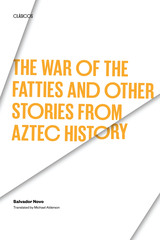 The War of the Fatties and Other Stories from Aztec History
By Salvador Novo
University of Texas Press, 1993 In "The War of the Fatties," a campy, tongue-in-cheek retelling of an episode from the Mexican "Trojan War," naked fat women from Tlatelolco discombobulate Tenochtitlan’s invading army by squirting them with breast milk. Told with satiric allusions to the policies and tactics used by Mexico’s current ruling party, PRI, to consolidate its power, the play unfolds a history of vain rivalry and decadence, intricate political maneuvers, corruption, and unchecked ambition that determined the course of Mexican history for two centuries before the Spanish conquest. Novo’s other works in this collection—"A Few Aspects of Sex among the Nahuas," "Ahuítzotl and the Magic Water," "Cuauhtémoc: Play in One Act," "Cuauhtémoc and Eulalia: A Dialogue," "Malinche and Carlota: A Dialogue," and "In Ticitézcatl or The Enchanted Mirror: Opera in Two Acts"—represent nearly all of his Aztec-related writings. Taken together, they provide a delightful introduction to Novo’s later works and a light-hearted, historically accurate introduction to Aztec culture. The text is supplemented by a glossary of Nahuatl terms, notes on the historical characters, and an introduction that provides historical background and places Novo’s works within their cultural context.
War of Titans: Blake’s Critique of Milton and the Politics of Religion
Jackie DiSalvo
University of Pittsburgh Press, 1983
In a dramatically original analysis, Jackie DiSalvo explores Blake’s reworking of Genesis and Paradise Lost in his prophetic poem The Four Zoas, creating a compelling new reading of both Milton and Blake. With informed argument and provocative insights, DiSalvo shows how Blake’s view of history prefigures the revaluation of our own myths of origin prompted by new political, psychological, and feminist perspectives.
War of Words: Dutch Pro-Boer Propaganda and the South African War (1899-1902)
Vincent Kuitenbrouwer
Amsterdam University Press, 2012 The Boer War gripped the Dutch public during the turn of the nineteenth century, when the Boer Republics, made up of descendants of seventeenth-century settlers from the Netherlands, were fighting the British Empire in South Africa. War of Words examines the ample Dutch propaganda during this time period, which attempted to counterweigh the British coverage of the war. Vincent Kuitenbrouwer offers a highly readable study of the pro-Boer movement in the Netherlands both during the Boer War and far into the twentieth century, while exploring the representation of South Africans in Dutch-language publications and the several persistent stereotypes that colored the Dutch attitude toward the Boers.
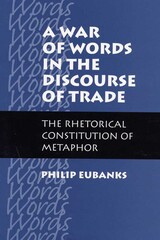 A War of Words in the Discourse of Trade: The Rhetorical Constitution of Metaphor
Philip Eubanks
Southern Illinois University Press, 2000 This study by Phillip Eubanks challenges traditional accounts of metaphor and significantly expands theories of "conceptual" metaphor by examining Trade Is War metaphor as it occurs in concrete discourse. Although scholarly interest in metaphor as an aesthetic, linguistic, and cognitive phenomenon has long endured, Eubanks is among the first to consider metaphor in its sociohistorical role. Questioning major accounts of metaphor from Aristotle to the present, Eubanks argues that metaphor is not just influenced by but actually is constituted by its concrete operation. Far-reaching in its implications for our understanding of metaphor, Eubanks’s premise enables us to see metaphor as a sweeping rhetorical entity even as it accounts for the more localized operations of metaphor of interest to linguists, philosophers of language, and cognitive scientists. Providing a new model of metaphoric functioning, Eubanks reconsiders the most promising account of metaphor to date, the notion of "conceptual metaphor.” Eubanks focuses on the conceptual metaphor Trade Is War—a metaphor found wherever people discuss business and commerce—to develop his rhetorical model of metaphor. He analyzes Trade Is War as it occurs in the print news media, on television discussion shows, in academic works, in popular nonfiction and novels, in historic economic commentary, and in focus group talk. While these examples do reveal a rich variety in the make-up of Trade Is War, much more than mere variety is at stake. Trade Is War is implicated in an extended and rhetorically complex conversation with other metaphors and literal concepts: trade is peace, Trade Is a Game, Trade Is Friendship, Trade is a Journey, and Markets Are Containers. The recognition and analysis of this constituting conversation furthers a reevaluation theory. What also emerges, however, is a valuable portrait of the discourse of trade itself, a discourse that depends importantly upon a responsive interchange of metaphors.
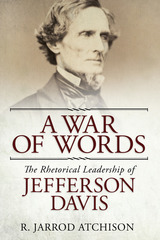 A War of Words: The Rhetorical Leadership of Jefferson Davis
R. Jarrod Atchison
University of Alabama Press, 2017 A rhetorical analysis of Jefferson Davis’s public discourse
Numerous biographies of Jefferson Davis have been penned; however, until now, there had been no substantive analysis of his public discourse as president of the Confederacy. R. Jarrod Atchison’s A War of Words uses concepts from rhetorical theory and public address to help answer a question that has intrigued scholars from a variety of disciplines since the collapse of the Confederacy: what role, if any, did Davis play in the collapse of Confederate nationalism?
Most discussions of Davis and nationalism focus on the military outcomes of his controversial wartime decisions. A War of Words focuses less on military outcomes and argues instead that, in the context of the Confederacy, Jefferson Davis’s rhetorical leadership should have been responsible for articulating a vision for the nation—including the core tenets of its identity, the values the nation should hold dear, the principles it should never compromise, and the goals it should set for its future. Undoubtedly, Davis possessed the skills necessary to make a persuasive public argument. It is precisely because Davis’s oratory skills were so powerful that there is room to judge how he used them. In short, being a great orator is not synonymous with successful rhetorical leadership.
Atchison posits that Davis’s initial successes constrained his rhetorical options later in the war. A War of Words concludes that, in the end, Davis’s rhetorical leadership was a failure because he was unable to articulate a coherent Confederate identity in light of the sacrifices endured by the populace in order to sustain the war effort.
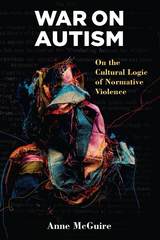 War on Autism: On the Cultural Logic of Normative Violence
Anne McGuire
University of Michigan Press, 2016 War on Autism examines autism as a historically specific and powerladen cultural phenomenon that has much to teach about the social organization of a neoliberal western modernity. Bringing together a variety of interpretive theoretical perspectives including critical disability studies, queer and critical race theory, and cultural studies, the book analyzes the social significance and productive effects of contemporary discourses of autism as these are produced and circulated in the field of autism advocacy. Anne McGuire discusses how in the field of autism advocacy, autism often appears as an abbreviation, its multiple meanings distilled to various “red flag” warnings in awareness campaigns, bulleted biomedical ”facts” in information pamphlets, or worrisome statistics in policy reports. She analyzes the relationships between these fragmentary enactments of autism and traces their continuities to reveal an underlying, powerful, and ubiquitous logic of violence that casts autism as a pathological threat that advocacy must work to eliminate. Such logic, McGuire contends, functions to delimit the role of the “good” autism advocate to one who is positioned “against” autism.
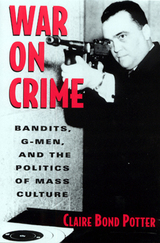 War on Crime: Bandits, G-Men, and the Politics of Mass Culture
Potter, Claire Bond
Rutgers University Press, 1998 War on Crime revises the history of the New Deal transformation and suggests a new model for political history-one which recognizes that cultural phenomena and the political realm produce, between them, an idea of "the state." The war on crime was fought with guns and pens, movies and legislation, radio and government hearings. All of these methods illuminate this period of state transformation, and perceptions of that emergent state, in the years of the first New Deal. The creation of G-men and gangsters as cultural heroes in this period not only explores the Depression-era obsession with crime and celebrity, but it also lends insight on how citizens understood a nation undergoing large political and social changes. Anxieties about crime today have become a familiar route for the creation of new government agencies and the extension of state authority. It is important to remember the original "war on crime" in the 1930s-and the opportunities it afforded to New Dealers and established bureaucrats like J. Edgar Hoover-as scholars grapple with the ways states assert influence over populations, local authority, and party politics while they pursue goals such as reducing popular violence and protecting private property.
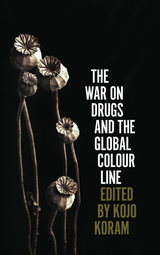 The War on Drugs and the Global Colour Line
Edited by Kojo Koram
Pluto Press, 2019 The War on Drugs has led to millions of people dead, displaced and incarcerated. Disproportionately enforced on oppressed races, international drug prohibition has reinforced the colour line across the globe.
While laws prohibiting the production, sale and use of particular drugs are presented as politically neutral and objective, this collection reveals the racist impact of the War on Drugs across multiple continents and in numerous situations. From racialised drugs policing at festivals in the UK to the necropolitical wars in Juarez, Mexico and from the exchange of drug policing programs between the United States and Israel to the management of black bodies in Brazil, this collection proves that the regulation of drugs and race is an international, and intentional, disaster.
Pushing forward the debate and activism led by groups such as Black Lives Matter and calling for radical changes in drug policy legislation and prison reform, both nationally and internationally, this collection cuts deep and rings true for all people fighting racism today.
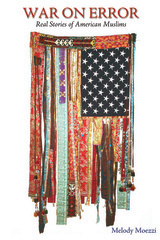 War on Error: Real Stories of American Muslims
Melody Moezzi
University of Arkansas Press, 2007 War on Error brings together the stories of twelve young people, all vastly different but all American, and all Muslim. Their approaches to religion couldn’t be more diverse: from a rapper of Korean and Egyptian descent to a bisexual Sudanese American to a converted white woman from Colorado living in Cairo and wearing the hijab. These individuals, whether they were born to the religion or came to it on their own, have made their own decisions about how observant they’ll be, whether or not to fast, how often to pray, and what to wear. Though each story is unique, each is also seen through the searching eyes of Melody Moezzi, herself an American Muslim of Iranian descent. She finds that the people she interviews are horrified that, in a post-9/11 world, they have seen their religion come to be represented, in the minds of many Americans, by terrorism. These thoughtful and articulate individuals represent the truth about the faith and its adherents who are drawn to the logic, compassion, and tolerance they find in Muslim teachings. Moezzi, ever comfortable with contradiction and nuance, is a likable narrator whose underlying assumption that “faith is greater than dogma” is strengthened as she learns more about her religion and faces her own biases and blind spots. This fresh new voice, combined with the perceptions and experiences of her fellow American Muslims, make for a read that is both illuminating and enjoyable.
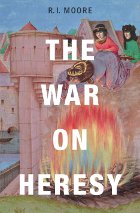 The War on Heresy
R. I. Moore
Harvard University Press, 2012 Between 1000 and 1250, the Catholic Church confronted the threat of heresy with increasing force. Some of the most portentous events in medieval history-the Cathar crusade, the persecution and mass burnings of heretics, the papal inquisition established to identify and suppress beliefs that departed from the true religion-date from this period. Fear of heresy molded European society for the rest of the Middle Ages and beyond, and violent persecutions of the accused left an indelible mark. Yet, as R. I. Moore suggests, the version of these events that has come down to us may be more propaganda than historical reality.
Popular accounts of heretical events, most notably the Cathar crusade, are derived from thirteenth-century inquisitors who saw organized heretical movements as a threat to society. Skeptical of the reliability of their reports, Moore reaches back to earlier contemporaneous sources, where he learns a startling truth: no coherent opposition to Catholicism, outside the Church itself, existed. The Cathars turn out to be a mythical construction, and religious difference does not explain the origins of battles against heretic practices and beliefs.
A truer explanation lies in conflicts among elites-both secular and religious-who used the specter of heresy to extend their political and cultural authority and silence opposition. By focusing on the motives, anxieties, and interests of those who waged war on heresy, Moore's narrative reveals that early heretics may have died for their faith, but it was not because of their faith that they were put to death.
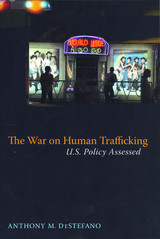 The War on Human Trafficking: U.S. Policy Assessed
Anthony M. DeStefano
Rutgers University Press, 2008 The United States has taken the lead in efforts to end international human trafficking-the movement of peoples from one country to another, usually involving fraud, for the purpose of exploiting their labor. Examples that have captured the headlines include the 300 Chinese immigrants that were smuggled to the United States on the ship Golden Venture and the young Mexican women smuggled by the Cadena family to Florida where they were forced into prostitution and confined in trailers.
The public's understanding of human trafficking is comprised of terrible stories like these, which the media covers in dramatic, but usually short-lived bursts. The more complicated, long-term story of how policy on trafficking has evolved has been largely ignored. In The War on Human Trafficking, Anthony M. DeStefano covers a decade of reporting on the policy battles that have surrounded efforts to abolish such practices, helping readers to understand the forced labor of immigrants as a major global human rights story.
DeStefano details the events leading up to the creation of the Trafficking Victims Protection Act of 2000, the federal law that first addressed the phenomenon of trafficking in persons. He assesses the effectiveness of the 2000 law and its progeny, showing the difficulties encountered by federal prosecutors in building criminal cases against traffickers. The book also describes the tensions created as the Bush Administration tried to use the trafficking laws to attack prostitution and shows how the American response to these criminal activities was impacted by the events of September 11th and the War in Iraq.
Parsing politics from practice, this important book gets beyond sensational stories of sexual servitude to show that human trafficking has a much broader scope and is inextricable from the powerful economic conditions that impel immigrants to put themselves at risk.
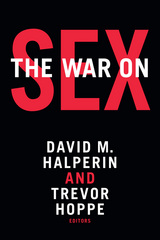 The War on Sex
David M. Halperin and Trevor Hoppe, editors
Duke University Press, 2017 The past fifty years are conventionally understood to have witnessed an uninterrupted expansion of sexual rights and liberties in the United States. This state-of-the-art collection tells a different story: while progress has been made in marriage equality, reproductive rights, access to birth control, and other areas, government and civil society are waging a war on stigmatized sex by means of law, surveillance, and social control. The contributors document the history and operation of sex offender registries and the criminalization of HIV, as well as highly punitive measures against sex work that do more to harm women than to combat human trafficking. They reveal that sex crimes are punished more harshly than other crimes, while new legal and administrative regulations drastically restrict who is permitted to have sex. By examining how the ever-intensifying war on sex affects both privileged and marginalized communities, the essays collected here show why sexual liberation is indispensable to social justice and human rights. Contributors. Alexis Agathocleous, Elizabeth Bernstein, J. Wallace Borchert, Mary Anne Case, Owen Daniel-McCarter, Scott De Orio, David M. Halperin, Amber Hollibaugh, Trevor Hoppe, Hans Tao-Ming Huang, Regina Kunzel, Roger N. Lancaster, Judith Levine, Laura Mansnerus, Erica R. Meiners, R. Noll, Melissa Petro, Carol Queen, Penelope Saunders, Sean Strub, Maurice Tomlinson, Gregory Tomso
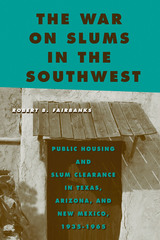 The War on Slums in the Southwest: Public Housing and Slum Clearance in Texas, Arizona, and New Mexico, 1935-1965
Robert B Fairbanks
Temple University Press, 2016 In The War on Slums in the Southwest, Robert Fairbanks provides compelling and probing case studies of economic problems and public housing plights in Albuquerque, Dallas, Houston, Phoenix and San Antonio. He provides brief histories of each city--all of which expanded dynamically between 1935 and 1965--and how they responded to slums under the Housing Acts of 1937, 1949, and 1954. Despite being a region where conservative politics has ruled, these Southwestern cities often handled population growth, urban planning, and economic development in ways that closely followed the national account of efforts to eliminate slums and provide public housing for the needy. The War on Slums in the Southwest therefore corrects some misconceptions about the role of slum clearance and public housing in this region as Fairbanks integrates urban policy into the larger understanding of federal and state-based housing policies.
 A War on Terror: Afghanistan and After
Paul Rogers
Pluto Press, 2004 Paul Rogers is one of the world's leading security experts. Since the 11 September attacks, he has been a regular guest on TV news channels throughout America and Britain, where he has offered expert advice on the real implications of 9/11 and Bush's 'war on terror'. His articles in newspapers around the world, and in the web journal Open Democracy, have become essential reading for many thousands of people, including government officials, senior military, heads of UN agencies, opinion formers, journalists and peace activists.
A War on Terror is Paul Roger's radical assessment of Bush's new policy, the way it has affected world security and the grave implications that it holds for future peace, not only in the Middle East but throughout the world. Moving from the war in Afghanistan and its aftermath to the Israeli/Palestinian conflict, the continuing development of al-Qaida and its associates through to the war on Iraq, Rogers presents a uniquely cogent analysis of these rapid and traumatic events.
In a world in which the US and other states of the Atlantic community are increasingly speaking a different language to that of the majority of the world, Paul Rogers offers a vital critical assessment of the language of dominance and control as 'the New American Century' unfolds.
For the US, in particular, the post-9/11 world is one in which it is essential to maintain firm control of international security, extending to pre-emptive military action. In this book, Rogers demonstrates how futile, mistaken and deeply counter-productive that belief is, and points the way to more effective routes to a more just and secure world.
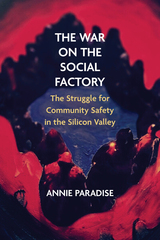 The War on the Social Factory: The Struggle for Community Safety in the Silicon Valley
Annie Paradise
Northwestern University Press, 2024 A collective ethnography of grassroots mobilizations for community safety across the Silicon Valley
This is a narrative of struggle and solidarity and a collective toolkit for grassroots opposition to militarization, policing, and ongoing conditions of war in the current conjuncture of racial patriarchal capitalism. Grassroots researcher Annie Paradise presents here a collective ethnography of the mothers and community matriarchs whose children have been murdered by police across the San Francisco Bay Area as they develop and practice autonomous, creative forms of resistance.
The War on the Social Factory: The Struggle for Community Safety in the Silicon Valley maps local families’ struggles to reclaim their households and their communities—to create a social infrastructure of care, justice, and safety outside state- and market-determined modes of “security.” Practices such as sustained vigil, testimony, and the production and circulation of insurgent knowledges are shown here to be part of interconnected justice efforts to demilitarize and decarcerate communities in the face of the multiple forms of violence enacted under late racial patriarchal capitalism. Paradise examines the expanding carceral processes of enclosure, criminalization, dispossession, expropriation, and disposability that mark the neoliberal "security” regime across the Silicon Valley and offers counter-counterinsurgent strategies and practices of co-generative, dynamic resistance.
War on War: Lenin, the Zimmerwald Left, and the Origins of Communist Internationalism
R. Craig Nation
Duke University Press, 1989 The outbreak of World War I precipitated a schism in the international socialist movement that endures today. Heeding calls for "rational defense," the leading European socialist democratic parties abandoned their vision of peace and internationalism as an integral part of the struggle for social justice and set aside their view of interstate war as the clearest example of the irrational essence of competitive capitalism. Only the Zimmerwald Left, led by Lenin, continued to speak out for internationalism. R. Craig Nation utilizes sources in Dutch, French, German, Italian, Russian, and Swedish to provide the first comprehensive history of the Zimmerwald Left as an international political tendency.
War on Waste: Can America Win Its Battle With Garbage?
Robert Gottlieb and Louis Blumberg; Foreword by Jim Hightower
Island Press, 1989 War on Waste offers a comprehensive analysis of the solid waste problem and the major alternatives that could provide viable solutions to the crisis.
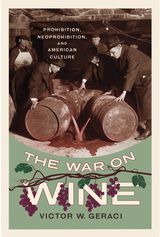 The War on Wine: Prohibition, Neoprohibition, and American Culture
Victor W. Geraci
University of Nevada Press, 2023 The development of an American wine ethos.
The history of wine is a tale of capitalist production and consumer experience, and early Americans embraced the idea of having their own wine culture. But many began to believe that excessive alcohol consumption had become a moral, ethical, economic, political, social, and health conundrum. The result was a national on-again, off-again relationship with the concept of an American wine culture. Citizens struggled to build a wine culture patterned after their diasporic European custom of wine as a moderating beverage that was part of a healthy diet. Yet, as America grew, untold attempts to create a wine culture failed due to climate, pests, diseases, wars, and depressions, resulting in some people considering the nation an alcoholic republic. Thus began an anti-alcohol culture war aimed at restricting or prohibiting alcoholic beverages. With the passage of the Eighteenth Amendment (Prohibition), a culture war started between wet and dry proponents. After the repeal of Prohibition, the decimated wine industry responded by forming the Wine Institute to rebrand wine’s role in American society, after which neoprohibitionists attempted to restrict alcohol availability and consumption. To confront these aggressive actions, the Wine Institute hired politically trained John A. De Luca to navigate the new attacks and pushed for rebranding wine as a cultural spirit with health benefits.
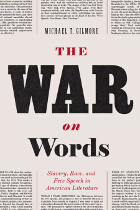 The War on Words: Slavery, Race, and Free Speech in American Literature
Michael T. Gilmore
University of Chicago Press, 2010 How did slavery and race impact American literature in the nineteenth century? In this ambitious book, Michael T. Gilmore argues that they were the carriers of linguistic restriction, and writers from Frederick Douglass to Stephen Crane wrestled with the demands for silence and circumspection that accompanied the antebellum fear of disunion and the postwar reconciliation between the North and South. Proposing a radical new interpretation of nineteenth-century American literature, The War on Words examines struggles over permissible and impermissible utterance in works ranging from Thoreau’s “Civil Disobedience” to Henry James’s The Bostonians. Combining historical knowledge with groundbreaking readings of some of the classic texts of the American past, The War on Words places Lincoln’s Cooper Union address in the same constellation as Margaret Fuller’s feminism and Thomas Dixon’s defense of lynching. Arguing that slavery and race exerted coercive pressure on freedom of expression, Gilmore offers here a transformative study that alters our understanding of nineteenth-century literary culture and its fraught engagement with the right to speak.
 War, Peace, and International Political Realism: Perspectives from THE REVIEW OF POLITICS
Keir A. Lieber
University of Notre Dame Press, 2009
Gathering together essays by some of the most influential modern political philosophers and theorists, War, Peace, and International Political Realism reveals the twentieth-century roots of the realist tradition and demonstrates the enduring relevance of realist insights for current international relations scholarship and foreign affairs. These essays, all of which were published in The Review of Politics, the majority during the 1940s and 1950s, reflect four major tenets of the classical realist tradition: an obligation to confront large and difficult questions about international politics, a recognition of the fundamentally tragic nature of relations among humans and states, a rejection of historical optimism, and a belief in practical morality. Keir A. Lieber provides an excellent introduction emphasizing the importance of political realism as defined by the contributors.
"Political realism is a distinguished intellectual tradition that illuminates the tragic aspects of the human condition. This wide-ranging collection of essays highlights the philosophical depth and topical breadth of postwar realist thought and illustrates both the continuities and divisions that continue to shape that tradition. Readers will gain considerable insight from revisiting these classics, or from discovering them for the first time." --Stephen Walt, Robert and Renee Belfer Professor of International Affairs, Harvard University
"This collection of outstanding essays by such intellectual giants as Hannah Arendt, Herbert Butterfield, George Kennan, and Hans Morgenthau shows why conflict has long been at the heart of international politics and why there will never be world peace." --John J. Mearsheimer, R. Wendell Harrison Distinguished Service Professor of Political Science, University of Chicago
"This volume of essays that were originally published in The Review of Politics provides a unique perspective on the early history of both International Relations and political realism. All of the contributors, including luminaries such as Kennan, Morgenthau, and Thompson, asked profound questions about the nature of man, society, and politics, and should encourage readers to reconsider the purpose of contemporary political science. By focusing on the work of some of the leading realist thinkers who were writing in the 1940s and 1950s, Lieber clearly demonstrates that realism remains extremely relevant to understanding current debates on international politics and American foreign policy." --Brian C. Schmidt, Carleton University
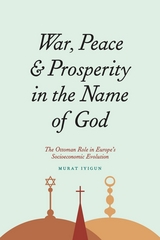 War, Peace, and Prosperity in the Name of God: The Ottoman Role in Europe's Socioeconomic Evolution
Murat Iyigun
University of Chicago Press, 2015 Differences among religious communities have motivated—and continue to motivate—many of the deadliest conflicts in human history. But how did political power and organized religion become so thoroughly intertwined? And how have religion and religiously motivated conflicts affected the evolution of societies throughout history, from demographic and sociopolitical change to economic growth?
War, Peace, and Prosperity in the Name of God turns the focus on the “big three monotheisms”—Judaism, Islam, and Christianity—to consider these questions. Chronicling the relatively rapid spread of the Abrahamic religions among the Old World, Murat Iyigun shows that societies that adhered to a monotheistic belief in that era lasted longer, suggesting that monotheism brought some sociopolitical advantages. While the inherent belief in one true god meant that these religious communities had sooner or later to contend with one another, Iyigun shows that differences among them were typically strong enough to trump disagreements within. The book concludes by documenting the long-term repercussions of these dynamics for the organization of societies and their politics in Europe and the Middle East.
War, Politics and Society in Afghanistan, 1978-1992
Antonio Giustozzi
Georgetown University Press, 1999 This book is the first to analyze the institutions, successes, and failures of the People's Democratic Party of Afghanistan, the pro-Soviet regime that sought to dominate the country during the years of the Soviet military presence. Antonio Giustozzi explores the military, political, and social strategies of the predominantly urban and Marxist regime as it struggled—and ultimately failed—to win the support of a largely rural and Islamic population. Drawing on many Soviet materials not previously used by Western writers, including unpublished Red Army documents and interviews with participants, Giustozzi provides valuable new insights into the cold war and the rise of Islamic revolt.
 War Primer
Alexander Kluge
Seagull Books, 2024 A profound exploration of the enduring impact of war in the wake of the Russian invasion of Ukraine.
“War is back again.” So begins Alexander Kluge’s latest book, prompted by a war of aggression that, though being waged in Europe, is of global importance. Blending simple stories with multimedia and reflecting on human responses and hope, the author does not aim to take sides nor make an appeal. Rather, he is concerned with what he calls “mole war,” the tenacious and often subterranean survival of war—what war makes of people and what life of its own it is capable of.
Kluge’s book is based on an iconic model, the primer, and named after a famous one: Bertolt Brecht’s. Here we find simple stories underpinned with montages, film stills, and sequences. The author was ten years old when—sitting at his school desk and with his finger on the map—he followed German tanks on their journey to Stalingrad. In the time between then and his ninety-first birthday in February 2023, this chronicler of emotions has studied the costumes of war again and again: War is mortal but does not die quickly. How can we respond to its demands?
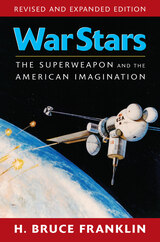 War Stars: The Superweapon and the American Imagination
H. Bruce Franklin
University of Massachusetts Press, 2008 In this new and expanded edition of an already classic work, H. Bruce Franklin brings the epic story of the superweapon and the American imagination into the ominous twenty-first century, demonstrating its continuing importance both to comprehending our current predicament and to finding ways to escape from it.
Sweeping through two centuries of American culture and military history, Franklin traces the evolution of superweapons from Robert Fulton's eighteenth-century submarine through the strategic bomber, atomic bomb, and Star Wars to a twenty-first century dominated by "weapons of mass destruction," real and imagined. Interweaving culture, science, technology, and history, he shows how and why the American pursuit of the ultimate defensive weapon—guaranteed to end all war and bring universal triumph to American ideals—has led our nation and the world into an epoch of terror and endless war.
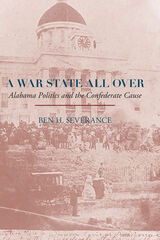 A War State All Over: Alabama Politics and the Confederate Cause
Ben H. Severance
University of Alabama Press, 2020 An in-depth political study of Alabama’s government during the Civil War
Alabama’s military forces were fierce and dedicated combatants for the Confederate cause.In his study of Alabama during the Civil War, Ben H. Severance argues that Alabama’s electoral and political attitudes were, in their own way, just as unified in their support for the cause of southern independence. To be sure, the civilian populace often expressed unease about the conflict, as did a good many of Alabama’s legislators, but the majority of government officials and military personnel displayed pronounced Confederate loyalty and a consistent willingness to accept a total war approach in pursuit of their new nation’s aims. As Severance puts it, Alabama was a “war state all over.”
In A War State All Over: Alabama Politics and the Confederate Cause, Severance examines the state’s political leadership at multiple levels of governance—congressional, gubernatorial, and legislative—and orients much of his analysis around the state elections of 1863. Coming at the war’s midpoint, these elections provide an invaluable gauge of popular support for Alabama’s role in the Civil War, particularly at a time when the military situation for Confederate forces was looking bleak. The results do not necessarily reflect a society that was unreservedly prowar, but they clearly establish a polity that was committed to an unconditional Confederate victory, in spite of the probable costs.
Severance’s innovative work focuses on the martial character of Alabama’s polity while simultaneously acknowledging the widespread angst of Alabama’s larger culture and society. In doing so, it puts a human face on the election returns by providing detailed character sketches of the principal candidates that illuminate both their outlook on the war and their role in shaping policy.
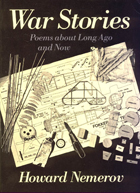 War Stories: Poems about Long Ago and Now
Howard Nemerov
University of Chicago Press, 1987 Howard Nemerov has written often about wars great and small, the overtly political and the deeply personal. But only with the passage of time, a heightening of technique and deepening of insight, has he been able to write from his experience in World War II as he does here, where historical past and personal history finally dovetail. From "The War in the Heavens" to "The War in the Streets," Nemerov chronicles with devastating grace the harrowing of life.
"These new poems of Howard Nemerov are the poems of a master at his best. What is more, they are accessible. They speak out in a beautiful unclouded voice of the experience of a flyer of the Second World War. Although as 'war poems' they take their place among the best of that genre, they resonate far beyond their history with an arresting immediacy."—Karl Shapiro
"Nemerov is the poet of our sanity, his the vision of the heroic ordinary. . . . Forty years after W. W. II, Nemerov's experiences in that war translate into timeless poetry. . . . Nemerov's poetry will outlast our generation: to read it now is to take part in something of ourselves and our world that will—and should—endure."—The Virginia Quarterly Review
"Throughout all his verse, formal language sets up a proscenium, keeping sentiment at a distance. In this elegant theatre, he tells stories that always, first, are works of art."—Denise Low, Kansas City Star
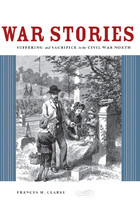 War Stories: Suffering and Sacrifice in the Civil War North
Frances M. Clarke
University of Chicago Press, 2011 The American Civil War is often seen as the first modern war, not least because of its immense suffering. Yet unlike later conflicts, it did not produce an outpouring of disillusionment or cynicism, as most people continued to portray the war in highly sentimental and patriotic terms. While scholars typically dismiss this everyday writing as simplistic or naïve, Frances M. Clarke argues that we need to reconsider the letters, diaries, songs, and journalism penned by Union soldiers and their caregivers to fully understand the war’s impact and meaning. In War Stories, Clarke revisits the most common stories that average Northerners told in hopes of redeeming their suffering and loss—stories that enabled people to make sense of their hardship, and to express their beliefs about religion, community, and personal character. From tales of Union soldiers who died heroically to stories of tireless volunteers who exemplified the Republic’s virtues, War Stories sheds new light on this transitional moment in the history of war, emotional culture, and American civic life.
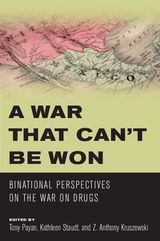 A War that Can’t Be Won: Binational Perspectives on the War on Drugs
Edited by Tony Payan, Kathleen Staudt, and Z. Anthony Kruszewski
University of Arizona Press, 2013 More than forty years have passed since President Richard Nixon described illegal drugs as “public enemy number one” and declared a “War on Drugs.” Recently the United Nations Global Commission on Drug Policy declared that “the global war on drugs has failed with devastating consequences for individuals and societies around the world.” Arguably, no other country has suffered as much from the War on Drugs as Mexico. From 2006 to 2012 alone, at least sixty thousand people have died. Some experts have said that the actual number is more than one hundred thousand. Because the war was conceived and structured by US policymakers and officials, many commentators believe that the United States is deeply implicated in the bloodshed.
A War that Can’t Be Won is the first book to include contributions from scholars on both sides of the US–Mexico border. It provides a unique breadth of perspective on the many dimensions of the societal crisis that affects residents of both nations—particularly those who live and work in the borderlands. It also proposes practical steps toward solving a crisis that shows no signs of abating under current policies. Each chapter is based on well-documented data, including previously unavailable evidence that was obtained through freedom-of-information inquiries in Mexico. By bringing together views from both sides of the border, as well as from various academic disciplines, this volume offers a much wider view of a complex problem—and possible solutions.
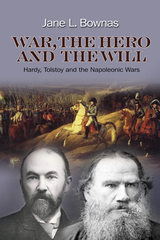 War, the Hero and the Will: Hardy, Tolstoy and the Napoleonic Wars
Jane L. Bownas
Sussex Academic Press, 2022 Thomas Hardy's "The Dynasts" and Leo Tolstoy's "War & Peace" are both works which defy attempts to assign them to a particular genre but might seem to have little else in common apart from being set in the same period of history. This study argues that there are important similarities between these two works and examines the close correspondence between Hardy's and Tolstoy's thinking on themes relating to war, ideas of the heroic and the concept of free will. Although coming from very different backgrounds, both writers were influenced by their experiences of war, Tolstoy directly, by involvement in the wars in the Caucasus and the Crimea, and Hardy indirectly, by the events of the Anglo-Boer Wars. Their reaction to these experiences found expression in their descriptions of the wars fought against Napoleon at the beginning of the century. Hegel saw Napoleon as 'the great world-historical man of his time', and this work considers the ways in which Hardy and Tolstoy undermine this view, portraying Napoleon's physical and mental decline and questioning the role he played in determining the outcomes of military actions. Both writers were deeply interested in the question of free will and determinism and their writings reveal their attempts to understand the nature of the force which lies behind men's actions. Their differing views on the nature of consciousness are considered in the light of modern research on the development of the conscious brain.
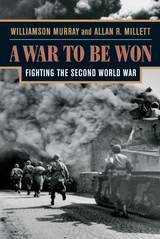 A War To Be Won: Fighting the Second World War
Williamson Murray and Allan R. Millett
Harvard University Press, 2000 In the course of the twentieth century, no war looms as profoundly transformative or as destructive as World War II. Its global scope and human toll reveal the true face of modern, industrialized warfare. Now, for the first time, we have a comprehensive, single-volume account of how and why this global conflict evolved as it did. A War To Be Won is a unique and powerful operational history of the Second World War that tells the full story of battle on land, on sea, and in the air.
Williamson Murray and Allan R. Millett analyze the operations and tactics that defined the conduct of the war in both the European and Pacific Theaters. Moving between the war room and the battlefield, we see how strategies were crafted and revised, and how the multitudes of combat troops struggled to discharge their orders. The authors present incisive portraits of the military leaders, on both sides of the struggle, demonstrating the ambiguities they faced, the opportunities they took, and those they missed. Throughout, we see the relationship between the actual operations of the war and their political and moral implications.
A War To Be Won is the culmination of decades of research by two of America’s premier military historians. It avoids a celebratory view of the war but preserves a profound respect for the problems the Allies faced and overcame as well as a realistic assessment of the Axis accomplishments and failures. It is the essential military history of World War II—from the Sino–Japanese War in 1937 to the surrender of Japan in 1945—for students, scholars, and general readers alike.
 The War with Catiline. The War with Jugurtha
Sallust
Harvard University Press, 2013 Two military monographs.
Sallust, Gaius Sallustius Crispus (86–35 BC), a Sabine from Amiternum, acted against Cicero and Milo as tribune in 52, joined Caesar after being expelled from the Senate in 50, was restored to the Senate by Caesar and took part in his African campaign as praetor in 46, and was then appointed governor of New Africa (Numidia). Upon his return to Rome he narrowly escaped conviction for malfeasance in office, retired from public life, and took up historiography. Sallust’s two extant monographs take as their theme the moral and political decline of Rome, one on the conspiracy of Catiline and the other on the war with Jugurtha.
Although Sallust is decidedly unsubtle and partisan in analyzing people and events, his works are important and significantly influenced later historians, notably Tacitus. Taking Thucydides as his model but building on Roman stylistic and rhetorical traditions, Sallust achieved a distinctive style, concentrated and arresting; lively characterizations, especially in the speeches; and skill at using particular episodes to illustrate large general themes.
For this edition, Rolfe’s text and translation of the Catiline and Jugurtha have been thoroughly revised in line with the most recent scholarship.
War with Catiline. War with Jugurtha. Selections from the Histories. Doubtful Works
Sallust
Harvard University Press Sallust, Gaius Sallustius Crispus (86-35 BCE) of Amiternum, after a wild youth became a supporter of Julius Caesar. He was tribune in 53; expelled from the Senate in 50; was quaestor in 49, praetor in 46. He saw Caesar triumph in Africa and became governor of Numidia, which he oppressed. Later in Rome he laid out famous gardens, retired from public life, and wrote a monograph on Catiline's conspiracy and one on the war with Jugurtha (both extant), and a history of Rome 78-67 BCE (little survives).
Though biased, Sallust's extant work is valuable. It shows lively characterisation (in speeches after Thucydides's manner) and attempts to explain the meaning of events. The work on Catiline has been called a study in social pathology. Sallust's style anticipates that of the early Empire.
War with China: Thinking Through the Unthinkable
David C. Gompert
RAND Corporation, 2016 In the event of a Sino-U.S. war, intense conventional counterforce attacks could inflict heavy losses and costs on both sides, so leaders need options to contain and terminate fighting. As it takes steps to reduce the likelihood of war with China, the United States must prepare for one by reducing force vulnerabilities, increasing counter–anti-access and area-denial capabilities, and using economic and international effects to its advantage.
War with the Newts
Karel Capek
Northwestern University Press, 1996 Working in the fantastic satiric tradition of Wells, Orwell, and Vonnegut, Karel Čapek chronicles the discovery of a colony of highly intelligent giant salamanders on an Indonesian island. Čapek sardonically portrays the reactions of the civilized world-from horror to skepticism, from intellectual fascination to mercantile opportunism-and the ultimate destruction from which it (and the newts) might not escape.
 The War Within: Diaries from the Siege of Leningrad
Alexis Peri
Harvard University Press, 2017 Winner of the Pushkin House Russian Book Prize
Winner of the University of Southern California Book Prize
Honorable Mention, Reginald Zelnik Book Prize
“Fascinating and perceptive.”
—Antony Beevor, New York Review of Books
“Stand aside, Homer. I doubt whether even the author of the Iliad could have matched Alexis Peri’s account of the 872-day siege which Leningrad endured.”
—Jonathan Mirsky, The Spectator
“Powerful and illuminating…A fascinating, insightful, and nuanced work.”
—Anna Reid, Times Literary Supplement
“Much has been written about Leningrad’s heroic resistance. But the remarkable aspect of [Peri’s] book is that she tells a very different story: recounting the internal struggles of ordinary people desperately trying to survive and make sense of their fate.”
—John Thornhill, Financial Times
“A sensitive, at times almost poetic examination of their emotions and disordered mental states. It both contrasts with and complements the equally accurate official Soviet portrait of a stalwart population standing firm in the face of evil and in defense of Soviet ideals.”
—Robert Legvold, Foreign Affairs
In September 1941, two and a half months after the Nazis invaded the Soviet Union, the German Wehrmacht encircled Leningrad. Cut off from the rest of Russia, the city remained blockaded for 872 days, at a cost of almost a million lives. It was one of the longest and deadliest sieges in modern history.
The War Within chronicles the Leningrad blockade from the perspective of those who endured it. Drawing on unpublished diaries, Alexis Peri tells the tragic story of how young and old struggled to make sense of a world collapsing around them. When the blockade was lifted in 1944, Kremlin officials censored publications describing the ordeal and arrested many of Leningrad’s wartime leaders. Some were executed. Diaries—now dangerous to their authors—were concealed, shelved in archives, and forgotten. The War Within recovers these lost accounts, shedding light on one of World War II’s darkest episodes while paying tribute the resilience of the human spirit.
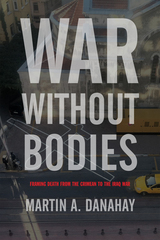 War without Bodies: Framing Death from the Crimean to the Iraq War
Martin Danahay
Rutgers University Press, 2022 Historically the bodies of civilians are the most damaged by the increasing mechanization and derealization of warfare, but this is not reflected in the representation of violence in popular media. In War Without Bodies, author Martin Danahay argues that the media in the United States in particular constructs a “war without bodies” in which neither the corpses of soldiers or civilians are shown. War Without Bodies traces the intertwining of new communications technologies and war from the Crimean War, when Roger Fenton took the first photographs of the British army and William Howard Russell used the telegraph to transmit his dispatches, to the first of three “video wars” in the Gulf region in 1990-91, within the context of a war culture that made the costs of organized violence acceptable to a wider public. New modes of communication have paradoxically not made more war “real” but made it more ubiquitous and at the same time unremarkable as bodies are erased from coverage. Media such as photography and instantaneous video initially seemed to promise more realism but were assimilated into existing conventions that implicitly justified war. These new representations of war were framed in a way that erased the human cost of violence and replaced it with images that defused opposition to warfare.
Analyzing poetry, photographs, video and video games the book illustrates the ways in which war was framed in these different historical contexts. It examines the cultural assumptions that influenced the reception of images of war and discusses how death and damage to bodies was made acceptable to the public. War Without Bodies aims to heighten awareness of how acceptance of war is coded into texts and how active resistance to such hidden messages can help prevent future unnecessary wars.
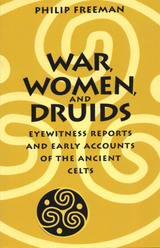 War, Women, and Druids: Eyewitness Reports and Early Accounts of the Ancient Celts
By Philip Freeman
University of Texas Press, 2002 "The ancient Celts capture the modern imagination as do few other people of classical times. Naked barbarians charging the Roman legions, Druids performing sacrifices of unspeakable horror, women fighting beside their men and even leading armies—these, along with stunning works of art, are the images most of us call to mind when we think of the Celts," observes Philip Freeman. "And for the most part, these images are firmly based in the descriptions handed down to us by the Greek and Roman writers." This book draws on the firsthand observations and early accounts of classical writers to piece together a detailed portrait of the ancient Celtic peoples of Europe and the British Isles. Philip Freeman groups the selections (ranging from short statements to longer treatises) by themes—war, feasting, poetry, religion, women, and the Western Isles. He also presents inscriptions written by the ancient Celts themselves. This wealth of material, introduced and translated by Freeman to be especially accessible to students and general readers, makes this book essential reading for everyone fascinated by the ancient Celts.
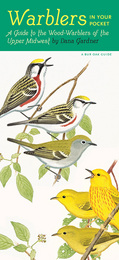 Warblers in Your Pocket: A Guide to Wood-Warblers of the Upper Midwest
Dana Gardner
University of Iowa Press, 2016 Robins may be the official harbingers of spring, but the arrival of the wood-warbler signifies the real beginning of the season. These brightly colored songsters, most of whom have migrated extremely long distances to reach their summer nesting grounds, appear like animated jewels from treetops to shrubs to ground throughout the Midwest. Adult males in fresh spring plumage are particularly striking: the buttery yellow of the commonly seen yellow warbler; brilliant orange of the Blackburnian and bright gold of the prothonotary; rich chestnut of the Cape May, bay-breasted, and chestnut-sided; the blue of the northern parula, cerulean, and black-throated blue make these birds a joy to encounter.
This newest addition to Iowa’s popular series of laminated guides—the twenty-eighth in the series—illustrates the thirty-eight species of warblers that occur in the Upper Midwest states of Minnesota, Illinois, Nebraska, Kansas, North Dakota, South Dakota, Iowa, Indiana, Michigan, Ohio, and Wisconsin. For each species, artist Dana Gardner provides length, range, and habitat; he illustrates male, female, and immature birds where plumage varies; and he includes birds similar to warblers such as kinglets and vireos.
For all their brilliance, warblers can be hard to identify, particularly in the fall—the phrase “confusing fall warblers” was coined for a reason—and when they are in immature plumage. Quick-moving and often found in treetops, they can be challenging even in spring, and the drabber colors of the young birds of the season and of many fall adults can make identification difficult. The illustrations and descriptions in Warblers in Your Pocket will be a most welcome reference for bird watchers throughout the Midwest.
The Wardell Buffalo Trap 48 SU 301: Communal Procurement in the Upper Green River Basin, Wyoming
George C. Frison
University of Michigan Press, 1973 The Late Prehistoric buffalo trap and meat-processing area known as the Wardell site is in Sublette County, in western Wyoming. In this volume, George C. Frison reports on the 1970–1971 excavation at the site. He describes the artifact assemblage and botanical materials and offers radiocarbon dates and an archaeological interpretation of the site. Contribution by Charles A. Reher.
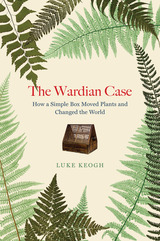 The Wardian Case: How a Simple Box Moved Plants and Changed the World
Luke Keogh
University of Chicago Press, 2020 The story of a nineteenth-century invention (essentially a tiny greenhouse) that allowed for the first time the movement of plants around the world, feeding new agricultural industries, the commercial nursery trade, botanic and private gardens, invasive species, imperialism, and more.
Roses, jasmine, fuchsia, chrysanthemums, and rhododendrons bloom in gardens across the world, and yet many of the most common varieties have roots in Asia. How is this global flowering possible? In 1829, surgeon and amateur naturalist Nathaniel Bagshaw Ward placed soil, dried leaves, and the pupa of a sphinx moth into a sealed glass bottle, intending to observe the moth hatch. But when a fern and meadow grass sprouted from the soil, he accidentally discovered that plants enclosed in glass containers could survive for long periods without watering. After four years of experimentation in his London home, Ward created traveling glazed cases that would be able to transport plants around the world. Following a test run from London to Sydney, Ward was proven correct: the Wardian case was born, and the botanical makeup of the world’s flora was forever changed.
In our technologically advanced and globalized contemporary world, it is easy to forget that not long ago it was extremely difficult to transfer plants from place to place, as they often died from mishandling, cold weather, and ocean salt spray. In this first book on the Wardian case, Luke Keogh leads us across centuries and seas to show that Ward’s invention spurred a revolution in the movement of plants—and that many of the repercussions of that revolution are still with us, from new industries to invasive plant species. From the early days of rubber, banana, tea, and cinchona cultivation—the last used in the production of the malaria drug quinine—to the collecting of beautiful and exotic flora like orchids in the first great greenhouses of the United States Botanic Garden in Washington, DC, and England’s Royal Botanic Gardens, Kew, the Wardian case transformed the world’s plant communities, fueled the commercial nursery trade and late nineteenth-century imperialism, and forever altered the global environment.
 The Warehouse: Workers and Robots at Amazon
Alessandro Delfanti
Pluto Press, 2021 'Work hard, have fun, make history' proclaims the slogan on the walls of Amazon's warehouses. This cheerful message hides a reality of digital surveillance, aggressive anti-union tactics and disciplinary layoffs. Reminiscent of the tumult of early industrial capitalism, the hundreds of thousands of workers who help Amazon fulfil consumers' desire are part of an experiment in changing the way we all work.
In this book, Alessandro Delfanti takes readers inside Amazon's warehouses to show how technological advancements and managerial techniques subdue the workers rather than empower them, as seen in the sensors that track workers' every movement around the floor and algorithmic systems that re-route orders to circumvent worker sabotage. He looks at new technologies including robotic arms trained by humans and augmented reality goggles, showing that their aim is to standardize, measure and discipline human work rather than replace it.
Despite its innovation, Amazon will always need living labor's flexibility and low cost. And as the warehouse is increasingly automated, worker discontent increases. Striking under the banner 'we are not robots', employees have shown that they are acutely aware of such contradictions. The only question remains: how long will it be until Amazon's empire collapses?
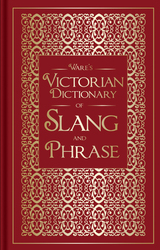 Ware's Victorian Dictionary of Slang and Phrase
J. Redding Ware
Bodleian Library Publishing, 2013 Acutely aware of the changes affecting English at the end of the Victorian era, writer and journalist J. Redding Ware set out to record words and turns of phrase from all walks of life, from the curses in common use by sailors to the rhyming slang of the street and the jargon of the theater dandies. In doing so, he extended the lifespan of words like “air-hole,” “lally-gagging,” and “bow-wow mutton.”
First published in 1909 and reproduced here with a new introduction by Oxford English Dictionary editor John Simpson, Ware’s Victorian Dictionary of Slang and Phrase reflects the rich history of unofficial English. Many of the expressions are obsolete; one is not likely to have the misfortune of encountering a “parlour jumper.” Order a “shant of bivvy” at the pub and you’ll be met with a blank stare. But some of the entries reveal the origins of expressions still in use today, such as calling someone a “bad egg” to indicate that they are dishonest or of ill-repute. While showing the significant influence of American English on Victorian slang, the Dictionary also demonstrates how impressively innovative its speakers were.
A treasure trove of everyday language of the nineteenth century, this book has much to offer in terms of insight into the intriguing history of English and will be of interest to anyone with a passion for words.
Warfare and Diplomacy in Pre-Colonial West Africa
Robert S. Smith
University of Wisconsin Press, 1989 This new edition of the well-known innovative study of the relations of the peoples of West Africa in the precolonial period covers a period of some four or five hundred years, up to the last decades of the nineteenth century. Smith takes account of outside influences but focuses primarily on what happened between African states before the partition of the area and the establishment of colonies.
Warfare and Politics: Cities and Government in Renaissance Tuscany and Venice
Humfrey Butters
Amsterdam University Press, 2020 Warfare and Politics: Cities and Government in Renaissance Tuscany and Venice brings together a group of prominent contributors to consider the topics of government and warfare in Tuscany and Venice in the Renaissance. The essays cover a remarkably broad geographical and topical range as they analyse the economic, military, political, and diplomatic history of Florence, Rome, Venice, and the Italian peninsula in general through the Renaissance and early modern period.
 Warfare and the Dynamics of Political Control
Edited by Brian R. Billman
University of Arizona Press, 2025 Warfare and the Dynamics of Political Control draws on a wealth of interdisciplinary perspectives to explore how conflict shapes the establishment and maintenance of political institutions, from small-scale societies to expansive empires. The book examines the material and ideological factors that drive warfare, the organization of combatants, the ways leaders use violence to consolidate power, and how groups resist political domination in times of conflict. By posing critical questions about the efficacy of strategies and the varied outcomes of conflict-driven power struggles, this volume offers profound insights into the dynamics of political control throughout history. Bringing together case studies from diverse regions and time periods, Warfare and the Dynamics of Political Controlilluminates the multifaceted nature of political violence. The volume includes discussions of human sacrifice, slave-taking, ideological signaling, and military strategy and tactics. The case studies reveal how different forms of political violence influence societal structures. From the fortifications of the Māori in New Zealand to the city walls of early historic India, each contribution provides a detailed analysis of how warfare has been used to both to challenge and to establish political hierarchies. Featuring examples from small foraging communities to large empires across various regions and time periods, the book offers a wide-ranging exploration of how different groups have used and resisted political violence. This essential work contributes to our understanding of the intersections between conflict and political power, making it a vital resource for scholars of anthropology, archaeology, political science, and history.
 Warfare and the Fall of a Fortified Center: Archaeological Investigations at Aguateca
Takeshi Inomata
Vanderbilt University Press, 2006 This volume presents for the first time the detailed data and dramatic findings of Inomata's investigations of this Classic period second capital of the ancient Maya Petexbatun kingdom. As widely discussed in journals and the media, the autonomous Aguateca subproject of the Vanderbilt Petexbatun research recovered remarkable new evidence on the violent end of a great Maya center,. This monograph presents summaries and interpretations of the excavations and surveys, site maps, and recovered ceramics and artifacts, as well as a wide range of applied analyses of this data. The sprawling defensive fortifications of this center, its already formidable natural location, and its final destruction and burning represent one of the most remarkable sets of evidence of the collapse of a Classic Maya kingdom. Inomata presents the evidence on Aguateca and its sudden end, and the implications of his findings for theories of the end of Classic Maya civilization in the Petexbatun.
VIMA Series #3
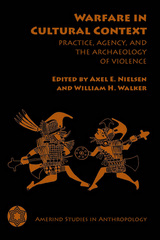 Warfare in Cultural Context: Practice, Agency, and the Archaeology of Violence
Edited by Axel E. Nielsen and William H. Walker
University of Arizona Press, 2009 Warfare is a constant in human history. According to the contributors to this volume, archaeologists have assumed that—within certain socioenvironmental parameters—war is always essentially the same phenomenon and follows a common logic, breaking out under similar conditions and having analogous effects on the people involved. In pursuit of this idea, archaeologists have built models to account for the occurrence of war in various times and places. The models are then tested against prehistoric evidence to make the causes and conduct of war predictable and data-based.
However, contributors argue, this model-and-evidence approach has given rise to multiple competing hypotheses and ambiguity rather than to full, coherent explanations of what turns out to be surprisingly complex acts of war. The chapters in Warfare in Cultural Context contend that agency and culture, inherited values and dispositions (such as religion and other cultural practices), beliefs, and institutions are always woven into the conduct of war.
This revealing book focuses on the ways that specific people construed their interests and life projects, and their problems and possibilities, and consequently chose among alternative courses of action. Using archaeological and ethnohistorical data from various parts of the world, the contributors explore the multiple avenues for the cultural study of warfare that these ideas make possible. Contributions focus on cultural aspects of warfare in Mesoamerica, South America, North America, and Southeast Asia. Case studies include warfare among the Maya, Inca, southwestern Pueblos, Mississippian cultures, and the Enga of Papua New Guinea.
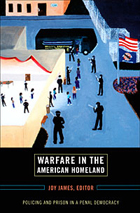 Warfare in the American Homeland: Policing and Prison in a Penal Democracy
Joy James, ed.
Duke University Press, 2007 The United States has more than two million people locked away in federal, state, and local prisons. Although most of the U.S. population is non-Hispanic and white, the vast majority of the incarcerated—and policed—is not. In this compelling collection, scholars, activists, and current and former prisoners examine the sensibilities that enable a penal democracy to thrive. Some pieces are new to this volume; others are classic critiques of U.S. state power. Through biography, diary entries, and criticism, the contributors collectively assert that the United States wages war against enemies abroad and against its own people at home. Contributors consider the interning or policing of citizens of color, the activism of radicals, structural racism, destruction and death in New Orleans following Hurricane Katrina, and the FBI Counterintelligence Program designed to quash domestic dissent. Among the first-person accounts are an interview with Dhoruba Bin Wahad, a Black Panther and former political prisoner; a portrayal of life in prison by a Plowshares nun jailed for her antinuclear and antiwar activism; a discussion of the Puerto Rican Independence Movement by one of its members, now serving a seventy-year prison sentence for sedition; and an excerpt from a 1970 letter by the Black Panther George Jackson chronicling the abuses of inmates in California’s Soledad Prison. Warfare in the American Homeland also includes the first English translation of an excerpt from a pamphlet by Michel Foucault and others. They argue that the 1971 shooting of George Jackson by prison guards was a murder premeditated in response to human-rights and justice organizing by black and brown prisoners and their supporters. Contributors. Hishaam Aidi, Dhoruba Bin Wahad (Richard Moore), Marilyn Buck, Marshall Eddie Conway, Susie Day, Daniel Defert, Madeleine Dwertman, Michel Foucault, Carol Gilbert, Sirène Harb, Rose Heyer, George Jackson, Joy James, Manning Marable, William F. Pinar, Oscar Lòpez Rivera, Dylan Rodríguez, Jared Sexton, Catherine vön Bulow, Laura Whitehorn, Frank B. Wilderson III
Warfare, Ritual, and Symbol in Biblical and Modern Contexts
Brad E. Kelle
SBL Press, 2014 New perspectives on Israelite warfare for biblical studies, military studies, and social theory
Contributors investigate what constituted a symbol in war, what rituals were performed and their purpose, how symbols and rituals functioned in and between wars and battles, what effects symbols and rituals had on insiders and outsiders, what ways symbols and rituals functioned as instruments of war, and what roles rituals and symbols played in the production and use of texts.
Features:
- Thirteen essays examine war in textual, historical, and social contexts
- Texts from the Hebrew Bible are read in light of ancient Near Eastern texts and archaeology
- Interdisciplinary studies make use of contemporary ritual and social theory
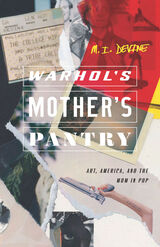 Warhol's Mother's Pantry: Art, America, and the Mom in Pop
M. I. Devine
Ohio State University Press, 2020 Winner of the 2019 Gournay Prize
“What are these fragments we’ve Jersey Shored against our ruin?” asks M. I. Devine, remixing T. S. Eliot, in this dizzying collection of essays that pays homage to the cultural forms that hold us steady. These fragments are stored in Warhol’s Mother’s Pantry, which takes us deep beneath the surfaces of pop to explore our shared quest for meaning today. Julia Warhola, an immigrant who arrived as the US was closing its borders a century ago, is the muse of reuse in these essays that cross boundaries—between now and then, high and low. She is the mom in pop who cut tin cans into flowers and taught Andy (and us) how to reshape and redeem our world. In essays as lyrical, witty, and experimental as the works they cover, Devine offers a new account of pop humanism. How we cut new things from the traditions we’re given, why we don’t stop believin’ (and carry on, wayward sons) when so much is stacked against us. Here are Leonard Cohen’s last songs and Molly Bloom’s last words; Vampire Weekend’s Rostam and Philip Larkin too; Stevie Smith, John Donne, and Kendrick Lamar; sonnets and selfies; early cinema and post–9/11 film, pop hooks, and pop art. In Devine’s hands, these literary and cultural artifacts are provocatively reassembled into an urgent and refreshing history that refuses to let its readers forget where pop came from and where it can go.
 Warhol's Working Class: Pop Art and Egalitarianism
Anthony E. Grudin
University of Chicago Press, 2017 This book explores Andy Warhol’s creative engagement with social class. During the 1960s, as neoliberalism perpetuated the idea that fixed classes were a mirage and status an individual achievement, Warhol’s work appropriated images, techniques, and technologies that have long been described as generically “American” or “middle class.” Drawing on archival and theoretical research into Warhol’s contemporary cultural milieu, Grudin demonstrates that these features of Warhol’s work were in fact closely associated with the American working class. The emergent technologies Warhol conspicuously employed to make his work—home projectors, tape recorders, film and still cameras—were advertised directly to the working class as new opportunities for cultural participation. What’s more, some of Warhol’s most iconic subjects—Campbell’s soup, Brillo pads, Coca-Cola—were similarly targeted, since working-class Americans, under threat from a variety of directions, were thought to desire the security and confidence offered by national brands.
Having propelled himself from an impoverished childhood in Pittsburgh to the heights of Madison Avenue, Warhol knew both sides of this equation: the intense appeal that popular culture held for working-class audiences and the ways in which the advertising industry hoped to harness this appeal in the face of growing middle-class skepticism regarding manipulative marketing. Warhol was fascinated by these promises of egalitarian individualism and mobility, which could be profound and deceptive, generative and paralyzing, charged with strange forms of desire. By tracing its intersections with various forms of popular culture, including film, music, and television, Grudin shows us how Warhol’s work disseminated these promises, while also providing a record of their intricate tensions and transformations.
Wari Imperialism in Middle Horizon Peru
Katharina J. Schreiber with a foreword by Jeffrey R. Parsons
University of Michigan Press, 1992 More than 600 years before the Inka empire ruled the Andean region of South American, during the period known as the Middle Horizon, there were two complex societies: the Tiwanaku and the Wari. In this volume, Katharina J. Schreiber explores the problem of the Middle Horizon through archaeological research in two specific areas: the Carhuarazo Valley and the Jincamocco site. Foreword by Jeffrey R. Parsons.
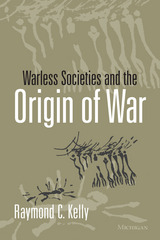 Warless Societies and the Origin of War
Raymond C. Kelly
University of Michigan Press, 2000 Warless Societies and the Origin of War employs a comparative ethnographic analysis of warless and warlike hunting and gathering societies to isolate distinctive features of peaceful preagricultural people and to develop a theoretical model of the origin of war and the early coevolution of war and society. Examining key Upper Paleolithic cave paintings and burials that document lethal violence, Raymond Kelly's illumination of the transition from warlessness to warfare in several specific locales in Europe and the Middle East confounds understandings of the origin of war prevalent today.
Kelly addresses fundamental questions concerning the trinity of interrelationship between human nature, war, and the constitution of society: Is war a primordial and pervasive feature of human existence or a set of practices that arose at a certain time in our recent prehistoric past? Are there peaceful societies in which war is absent and, if so, what are they like and how do they differ from warlike societies? Do the critical differentiating features pertain to child-rearing practices, to modes of conflict resolution, to social and economic inequality, to resource competition, or to the constitution of social groups?
As the conclusions of such an inquiry are central to our conceptions of human nature, the book will interest a wide range of readers, from those curious about the origins of collective violence to those studying the roles social institutions play in society.
Raymond C. Kelly is Professor of Anthropology, University of Michigan.
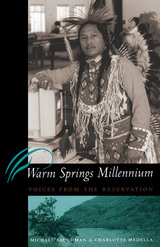 Warm Springs Millennium: Voices from the Reservation
By Michael Baughman and Charlotte Hadella
University of Texas Press, 2000 Established in 1855 on an area one-fifteenth the size of the lands relinquished in return for it, the Warm Springs Reservation in north central Oregon is home to some 3,600 Warm Springs, Wasco, and Paiute Indians, half of whom are under twenty. This book seeks to understand the reservation's inhabitants as a "viable people" who are both visible and vocal as they reflect on their daily lives, their struggles and successes, and their hopes for the future. Michael Baughman and Charlotte Hadella present extended interviews with seven Indian and two non-Indian members of the community. They discuss issues such as the difficulty of maintaining traditional lifeways centered around hunting, fishing, and gathering; the disruptions caused by alcoholism and diseases such as diabetes; and the need for culturally appropriate education for the young. The authors frame the interviews with explanatory material that covers the reservation's history and relations with white society and its efforts to transmit native languages and cultural traditions to its children.
 Warmed by Windchill: A Tiny Colt’s Fight for Life
Jeffrey L. Tucker; Foreword by Carolyn L. Stull, PhD
University of Wisconsin Press, 2013 One bitterly cold winter afternoon, a nine-month-old colt—extremely weak, starving, left to die—was frozen to the rock-hard white landscape of a northern Wisconsin pasture. His whinny for help barely carried through thirty-mile-an-hour winds lashing snow and ice against his thin coat. But somewhere inside him a light refused to go out. The colt's call for help was answered, and that light inspired a worldwide response to his story. The struggle of the little colt, called Windchill by his rescuers, was reported widely, and soon 1.2 million people were following Windchill's progress on a blog and webcam. Warmed by Windchill tells how Jeffrey L. Tucker, owner of nearby Raindance Farms, and Kathi Davis, owner of a horse training operation co-located at Raindance, rescued and cared for the colt, aided by an outpouring of assistance. Donations of money, feed, blankets, and other supplies streamed in as round-the-clock volunteers tried to save Windchill. Warmed by Windchill is both heartening and heartbreaking.
Warmer Than Yesterday: New and Selected Poems
Patricia Cleary Miller
BkMk Press, 2024 The voices in Patricia Cleary Miller’s Warmer Than Yesterday: New and Selected Poems struggle with four of life’s greatest confusions: home, war, death, and love. With humor, pathos, and ambiguity—after all, today is warmer than yesterday—they savor their experiences even if they never seem to find out all the answers as they search in Kansas City and all over the world. As Miller writes, “The characters in this collection are confused; they can’t get it right. Mothers and children, lovers, soldiers: guardedly optimistic, because today is warmer than yesterday, they struggle with the ambiguity of love, death, regret. But the book is not a downer: there are still yellow roses, mermaids, and a bit of tra-la-la in the forest.” This book highlights poems from her numerous books spanning over thirty years.
 Warning! This Product Contains Nuttiness: A Fun Look at the Bizarre World in Which We Live
Sam Venable
University of Tennessee Press, 2013 As seen through the eyes of Sam Venable, the world is indeed bizarre and filled with nuttiness. The archives of the Knoxville News Sentinel offer ample evidence that Venable is a bit of the former and has made a career out of drawing attention to the latter.
For his latest book, Venable has gathered and organized 139 of his newspaper columns—his biggest collection yet—to create a trove of wit and wisdom. In the spirit of “The Emperor’s New Clothes,” he points a finger at human nature, the environment, civil rights and wrongs, and an eclectic mix of other targets, drawing our attention to the foibles, failings, and just plain absurdities that surround us all.
As a native son and treasured institution in East Tennessee, Venable has earned the right to poke fun at its local history, habits, and happenings. He takes full, loving advantage of this license in essays such as “How to Tawlk Good,” “Shall We Gather with a Reptile,” and “The Good, the Bad, the Kudzu.” He takes on the government in a section titled “A Two-Ring Circus with Elephants and Donkeys,” and in another called “Still Waiting for Y2K,” he offers up “A Lesson in Dollars and Sense” and “Blowing the Budget for Bowser.”
Some have called him a modern-day Mark Twain, others the Dave Barry of Knoxville; but while there may be some similarities, Sam Venable is wonderfully unique. He sees—and sees through—the pervasive silliness and stupidity in our world. It evokes wonder in him, and with many a deft turn of phrase, he interprets that wonder for us. Warning! This Product Contains Nuttiness will make you smile, certainly, but it will also make you think and sometimes even touch your heart.
Warnings From the Future: Stories
Ethan Chatagnier
Acre Books, 2018 In ten provocative stories, Ethan Chatagnier presents us with characters in crisis, people grappling with their own and others’ darkness as they search for glimmers to carry them through difficult times, untenable tasks, uncertain futures. The collection explores with unflinching eloquence the quandaries of conscience posed by the present, but also plunges us into a startlingly prescient “what if?” world, exploring in both realms questions concerning the value of perseverance, art, hope, and heart.
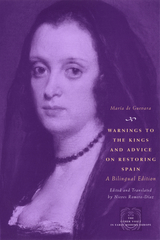 Warnings to the Kings and Advice on Restoring Spain: A Bilingual Edition
María de Guevara
University of Chicago Press, 2007 During a pivotal point in Spanish history, aristocrat María de Guevara (?–1683) produced two extraordinary essays that appealed for strong leadership, protested political corruption, and demanded the inclusion of women in the court’s decision making. “Treaty” gave Philip IV practical suggestions for fighting the war against Portugal and “Disenchantments” counseled the king-to-be, Charles II, on strategies to raise the country’s status in Europe. This annotated bilingual edition, featuring Nieves Romero-Díaz’s adroit translation, reproduces Guevara’s polemics for the first time.
Guevara’s provocative writings call on Spanish women to bear the responsibility equally with men for restoring Spain’s power in Europe and elsewhere. The collection also includes examples of Guevara’s shorter writings that exemplify her ability to speak on matters of state, network with dignitaries, and govern family affairs. Witty, ironic, and rhetorically sophisticated, Guevara’s essays provide a fresh perspective on the possibilities for women in the public sphere in seventeenth-century Spain.
Warped Minds: Cinema and Psychopathology
Temenuga Trifonova
Amsterdam University Press, 2014 Warped Minds explores the transformation of psychopathologies into cultural phenomena in the wake of the transition from an epistemological to an ontological approach to psychopathology. Trifonova considers several major points in this intellectual history: the development of a dynamic model of the self at the fin de siècle, the role of photography and film in the construction of psychopathology, the influence of psychoanalysis on the transition from static, universalizing psychiatric paradigms to dynamic styles of psychiatry foregrounding the socially constructed nature of madness, and the decline of psychoanalysis and the aestheticization of madness into a trope describing the conditions of knowledge in postmodernity as evidenced by the transformation of multiple personality and paranoia into cultural and aesthetic phenomena. Download the Table of Contents and a sample chapter
 Warped Narratives: Distortion in the Framing of Gun Policy
Melissa K. Merry
University of Michigan Press, 2020 The politics of gun policy in the United States are dramatic. Against the backdrop of daily gun violence—which claims more than 33,000 lives per year—gun control groups push for stronger regulations, while gun rights groups resist infringements upon their Second Amendment rights. To illuminate the dynamics of this polarized debate, Warped Narratives examines how and why interest groups frame the gun violence problem in particular ways, exploring the implication of groups’ framing choices for policymaking and politics. Melissa K. Merry argues that the gun policy arena is warped, and that both gun control and gun rights organizations contribute to the distortion of the issue by focusing on atypical characters and settings in their policy narratives. Gun control groups emphasize white victims, child victims, and mass shootings in suburban locales, while gun rights groups focus on self-defense shootings, highlighting threats to “law-abiding” gun owners. In reality, most gun deaths are the result of suicide. Homicides occur disproportionately in urban areas, mainly affecting racial minorities. While warping makes political sense in the short term, it may lead to negative, long-term consequences, including constraints on groups’ ability to build broad-based coalitions and to reduce prospects for compromise. To demonstrate warping, Merry analyzes nearly 67,000 communications by 15 national gun policy groups between 2000 and 2017 collected from blogs, emails, Facebook posts, and press releases. This book is the first to systematically assess the role of race in gun policy groups’ framing and offers the most comprehensive examination to date of interest groups’ presentation of this issue.
 The Warping of Government Work
John D. Donahue
Harvard University Press, 2008 Government has become a refuge, and a relic, of America’s crumbling middle-class economy. As the public and private worlds of work have veered in different directions, the gaps between them are warping government work in unintended ways.
Three decades of economic turbulence have rendered American workplaces more demanding and less secure, more rewarding for high-end workers and punishing for workers without advanced skills. This workplace revolution, however, has largely bypassed government. Public employees—representing roughly one-sixth of the total workforce—still work under the conditions of dampened risk and constrained opportunity that marked most of the economy during the middle-class boom following World War II.
The divergent paths of public and private employment have intensified a long-standing pattern: elite workers spurn public jobs, while less skilled workers cling to government work as a refuge from a harsh private economy. The first trend creates a chronic talent deficit in the public sector. The second trend makes the government workplace rigid and resistant to change. And both contribute to shortfalls in public-sector performance.
The Warping of Government Work documents government’s isolation from the rest of the American economy and arrays the stark choices we confront for narrowing, or accommodating, the divide between public and private work.
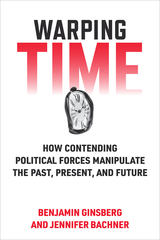 Warping Time: How Contending Political Forces Manipulate the Past, Present, and Future
Benjamin Ginsberg and Jennifer Bachner
University of Michigan Press, 2023 Warping Time shows how narratives of the past influence what people believe about the present and future state of the world. In Benjamin Ginsberg and Jennifer Bachner’s simple experiments, in which the authors measured the impact of different stories their subjects heard about the past, these “history lessons” moved contemporary policy preferences by an average of 16 percentage points; forecasts of the future moved contemporary policy preferences by an average of 12 percentage points; the two together moved preferences an average of 21 percentage points. And, in an Orwellian twist, the authors estimate that the “history lessons” had an average “erasure effect” of 8.5 percentage points—the difference between those with long-held preferences and those who did not recall that they previously held other opinions before participating in the experiment. The fact that the past, present, and future are subject to human manipulation suggests that history is not simply the product of impersonal forces, material conditions, or past choices. Humans are the architects of history, not its captives. Political reality is tenuous. Changes in our understanding of the past or future can substantially alter perceptions of and action in the present. Finally, the manipulation of time, especially the relationship between past and future, is a powerful political tool.
Warplane 04: Brewster Buffalo
Nico Braas
Amsterdam University Press, 2017 One of the lesser-known fighter aircraft of World War II was the Brewster Buffalo, or, using the U.S. Navy designation system, the F2A. By some historians the Buffalo is regarded as an outright failure, but this is a rating this stubby little fighter did not deserve.
This book presents an overview of the development and operational use of the Buffalo with many photos including a number not published before.
Warplane 05: Fokker C.X
Edwin Hoogschagen
Amsterdam University Press, 2017 Designed in 1933, the elegant looking Fokker C.X was outdated from the start. The type was intended as strategic reconnaissance plane but was not suited for this task. More modern, twin-engine types had claimed this specialized role. Instead, the biplane served well as short range scout and light bomber.
The C.X is a little-known member of the Dutch Fokker stable. Just like the D.XXI this biplane served in the air forces of two little neutral countries on the eve of World War II. Both fought gallantly in a war of David versus Goliath proportions, and the complete operational history of the type spans a total of 25 years. In retrospect, the C.X was the last fighting biplane type built by Fokker and the company's last pre-war military type to survive.
Warplane 06: Convair B-58 Hustler
Nico Braas
Amsterdam University Press, 2017 When the B-58 Hustler bomber entered service in 1958 it was a very futuristic looking delta wing bomber, creating a lot of sensation. Intended as a successor of the B-47 Stratojet it could reach twice the speed of sound.
However, problems occurred during the development process and costs risings went so out of control that the whole project was almost cancelled a few times. Strategic Air Command was initially against ordering the B-58 for service, not only because of its complexity but also since they saw no advantage of a Mach 2 bomber over other types. Despite this the B-58 entered service at S.A.C. in 1960. It would have a relatively short operational career.
|
|

